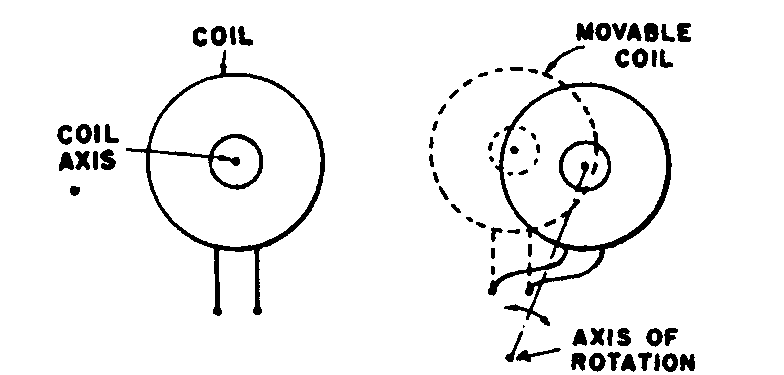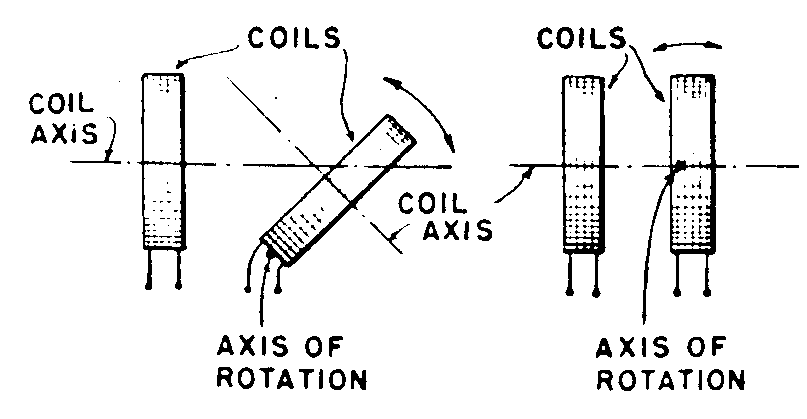SECTION I - CLASS DEFINITION
This is the generic class for the structure of inductor devices
of the passive type.
SECTION II - LINES WITH OTHER CLASSES AND WITHIN THIS CLASS
A. INDUCTOR DEVICES HAVING CAPACITANCE OR RESISTANCE:
1. With Capacitance:
As pointed out above, this class provides for inductor devices
wherein the inherent capacitive reactance of the inductor does not
resonate with the inductance of the inductor within the frequency
range of the electric current adapted to flow therethrough.
Where the inductance of the inductor resonates with its inherent capacitive
reactance, the device is excluded from this class and will
be found in Class 333, Wave Transmission Lines and Networks, subclasses
24+, as a coupling network, (e.g., filter, delay
networks, equalizers, coupling transformers), or
in Class 334, Tuners, appropriate subclasses as
a tuner.
2. With Resistance:
This class provides for all inductor devices having appreciable
inductive reactance regardless of the value of the inherent resistance
of the device within the frequency range of the electric current
adapted to flow therethrough. This class does not provide
for resistors which may have an incidental or undesired inherent inductive
reactance and which are designed to be used only as resistive impedances.
For such excluded resistors, see Class 338, Electrical
Resistors, especially subclasses 61+ for resistors
with inductance reducing means.
3. Inductor Devices in Combination with Separate Capacitors
or Resistors:
This class does not provide for the combination of inductor
devices and separate capacitors and/or resistors irrespective
of whether such combined devices are in mere structural arrangement
or in circuit arrangement with each other. For the excluded
subject matter, see Class 361, Electricity: Electrical
Systems and Devices, subclasses 268+, especially
subclass 270 for the combination of a transformer and capacitor, subclasses
331+ for the structure of switchboards and analogous devices including
the structural combination of plural diverse impedance elements, e.g., inductors
and capacitors, inductors and resistors, capacitors
and resistors or any combination of two or more of such elements
for which provision has not been made elsewhere. See also
the search notes below for other classes providing for inductor, inductor
and capacitor or resistor combinations.
B. INDUCTOR DEVICE STRUCTUIRE CLASSIFIED ELSEWHERE:
1. Stationary Inductor Devices:
Inductor device coil and core structure will be found in Class
361, Electricity: Electrical Systems and Devices, subclasses
268+ for induction or spark coils with capacitors and/or
circuit makers and breakers of the periodically operated type, subclasses
331+.
2. Transmission Line Sections with Distributed Parameters:
Transmission line sections where the line has distributed inductance
and capacity with or without effective distributed resistance are
classified in Class 333, Wave Transmission Lines and Networks, subclasses
219+ and 245+. Note that in subclasses
245+ are resonant long line sections (i.e., with
distributed inductance and capacity) which are designed
to be operated at other than resonant frequency for producing the
effect of an inductance. For example, a short-circuited
quarter-wave length line operated at less than resonant
frequency or an open-circuited line greater than a quarter-wave
length but less than a half wave length of wave energy acts as an
inductance. Also note that subclasses 24+ of
Class 333 contains some patents relating to adjustable inductor
devices which have an appreciable inherent capacity.
3. Electromagnets with Armatures:
Electromagnets of the tractive type which include an armature
for converting electrical energy into mechanical work through the
agency of electromagnetic induction are classified in Class 335, Electricity: Magnetically
Operated Switches, Magnets, and Electromagnets, subclasses
220+ for electromagnets with armatures. Note
that also, Class 335, Electricity: Magnetically
Operated Switches, Magnets, and Electromagnets, subclasses
2+ provides for electromagnetically actuated electric switches.
4. Loading Coils:
Class 178, Telegraphy, subclass 46, provides
for inductor coil structure designed for use in long electric wave transmission
lines to modify the electric wave propagation characteristics of
the lines.
5. Telephone Inductor Coils:
Class 379, Telephonic Communications, subclasses 443+ and
the subclasses specified in the notes thereto provide for inductor
coils combined with the structure of telephone instruments.
6. Loop Antennas:
Class 343, Communications: Radio Wave Antennas, subclasses
700+, and especially subclasses 726, 728, 741+, 748, 764, 788, 842, 855, and
866+, provides for the structure of inductor coil
devices for radiating or intercepting radio wave energy in free
space.
7. Dynamo Electric Machines:
Class 310, Electrical Generator or Motor Structure, appropriate
subclasses for the structure of electric motors and generators including
synchronous condensers, synchronous motors, induction
motors, dynamotors, rotary converters, metadynes, balancer
sets and the like.
8. Electromagnetic Electro-acoustical Wave
Transducers and Sound Pick-ups:
Devices which include an electromagnetic device for converting
electrical energy to sound energy, or vice versa, or
which are used in electrically recording and/or reproducing
sound records or which are used to convert the vibrations of a musical
instrument into modified electric currents, are classified
as follows:
Music instrument transducers, Class 84, Music, subclasses
725 to 729.
Audible electrical signal producers such as bells, whistles, etc., Class
340, Communications: Electrical, subclasses
384+.
Magnetic recording or reproducing devices, Class
360, Dynamic Magnetic Information Storage or Retrieval, subclasses
110+.
Electro-mechanical sound recording and/or
reproducing devices having a stylus for actuating, or actuated
by, the electromagnetic device, Class 369, Dynamic
Information Storage or Retrieval, subclasses 146+.
Telephone transmitters or receivers, Class 379, Telephonic
Communications, subclasses 419-427.
9. Signal Transmitters Using Variable Inductor Devices:
For devices designed to be selectively actuated to transmit
an undulating current for signaling purpose and which include means, such
as a pendulum, reed, or similar vibrating member
to vary the inductance of a variable inductor device, see
References to Other Classes, below.
10. Goniometers:
For Gonionmeters see Class 343 in References to Other Class, below.
11. Inductor Devices with Rotatable Element Recited By
Name Only in Combination with Positioning Means:
Class 74, subclasses 10+ and the subclasses
specified in the notes thereto provides for the combination of a transformer
or inductive reactor having an element (e.g., coil
or core) designed to be angularly movable in combination
with specific mechanical means for rotating a shaft for positioning
the movable element, where no significant structure of
the transformer or reactor other than that it has an angularly movable
part is recited in the claim. Where the means for moving
the shaft is not solely mechanical see the search notes to subclass
10 of Class 74 for the other classes which provide for the combination.
Where significant reactor or transformer structure is claimed, classification
is in this class (336).
12. Inductor Devices or Systems Utilizing High Temperature
Superconducting Material:
For Inductor Devices or Systems Utilizing High Temperature
Superconducting Material, see Class 505 in References to
Other Classes, below.
C. PATTERN CONTROLLED VARIABLE INDUCTOR DEVICES
AND PATTERN TRACING DEVICES WHICH ACTUATE VARIABLE INDUCTOR DEVICES:
In many of the arts, especially in the machine tool
arts, there are machines and apparatus designed to be controlled
in accordance with a pattern. The control pattern may
be facsimile of the article to be made or may be a code-type
pattern or other type of record. Many of these apparatuses
and machines disclose that the pattern actuates a variable inductor
device to modify the electric current in the control system.
A substantially complete listing of all the arts which involve pattern
control may be found in the search notes to Class 178, Telegraphy, subclass
3. Also see this class definition with reference to variable
inductor devices designed for use in reproducing sound records (e.g., phonograph
pick-ups). See References to Other Classes, below, for
classes and subclasses that are considered to be most likely to
include pattern controlled variable inductors.
D. VARIABLE INDUCTOR DEVICES OPERATED BY A CONDITION
SENSITIVE MEANS:
This class provides for adjustable inductor devices where
the movement of the inductance varying means is operated by a device
which responds to a condition, such as pressure responsive
inductor devices, temperature responsive inductor devices, etc., in
subclasses 30+.
There are many classes which provide for such condition responsive
devices in combination with the electrical system. See
above for the classification of adjustable inductor devices which
have their inductance varied in response to sound waves or which
are designed for use in reproducing sound from a sound record, or
which are designed to convert the vibrations of a musical instrument
to modified electric current. Also see above for a reference
to pattern controlled variable inductor devices.
For other classes which should be searched for condition responsive
inductor device systems see References to Other Classes, below.
E. ELECTROMAGNETS AND PERMANENT MAGNETS:
Electromagnets and permanent magnets of general application
and electromagnet coils and cores, per se, are
classified in Class 335, Electricity: Magnetically Operated
Switches, Magnets, and Electromagnets, subclasses
209+ for general application of magnets and electromagnets, electromagnetic
coils and cores, per se, subclasses 285+ for
lifting and holding electro and permanent magnets (e.g., magnetic
chucks). See Class 414, Material or
Article Handling, subclasses 606 and 737 for the provision
of a load-engaging magnet on certain types of load raising
or lowering devices, and Class 294, Handling:
Hand and Hoist-Line Implements, subclass 65.5
for hand and hoist-line implements having a magnetic means
for holding or attaching the material to be lifted to the lifting
handle or hoist-line.
Electromagnetic devices for heating (e.g., by
induction heating) are classified in Class 373, Industrial
Electric Heating Furnaces, subclasses 138+ when
combined with furnace structure, and Class 219, Electric
Heating, subclasses 600+ for inductive heating, subclasses
678+ for microwave heating, and subclasses 764+ for
capacitive dielectric heating.
Class 128, Surgery, subclasses 1.3+ provides
for electromagnetic devices for surgical purposes, including
magnetic probes and such magnetic devices as are designed to induce
electric currents in the human body.
F. INDUCTOR DEVICE SYSTEMS:
1. Current, Voltage And/Or Phase
Control Systems:
This class does not provide for systems which include an inductive
regulator device as a part thereof. Class 323, Electricity:
Power Supply or Regulation Systems, is the generic class
for systems for controlling the voltage and/or current
in the system and/or for systems for controlling the phase
angle between the voltage or current in the system. See
the search notes to the class definition of Class 323 for the other
classes which provide for electrical regulating systems and for
systems which include as a part thereof a regulating device.
2. Miscellaneous Transformer and Inductor Device
Systems:
Class 323, Electricity: Power Supply or
Regulation Systems, is the generic class for transformer
and impedance systems. See subclass 355 and the subclasses
specified in the notes thereto for the miscellaneous inductive reactor
device systems.
3. Inductive Loaded Transmission Lines:
Class 178, Telegraphy, subclass 45 is the
miscellaneous subclass for inductivity loaded transmission line
systems of the type used signaling systems, and Class 379, Telephonic
Communications, subclasses 414+ provide for inductively
loaded telephone lines.
4. Inductively Coupled Signaling Systems:
For signaling systems provided with means for transmitting
the signaling energy through space by electromagnetic induction (e.g., using
transformer coils) see References to Other Classes, below.
5. Transmitting Power To Vehicles:
For transmitting power to vehicles, see References
to Other Classes, below.
G. ANTI-INDUCTIVE DEVICES AND SYSTEMS:
For Anti-Inductive Devices and Systems, see
References to Other Classes, below.
SECTION III - REFERENCES TO OTHER CLASSES
SEE OR SEARCH CLASS:
| 72, | Metal Deforming,
subclass 7 for a metal shaping machine controlled by a pattern-actuated senser
means, and subclass 81 for a direct pattern controlled
sheet metal spinning machine. (See Lines With
Other Classes and Within This Class, C, Pattern
Controlled Variable Inductor Devices and Pattern Tracing Devices
Which Actuate Variable Inductor Devices, above.) |
| 73, | Measuring and Testing, appropriate subclasses, for miscellaneous apparatus
and systems for making nonelectrical, nonchemical and nonoptical
measurements and tests. In Class 73, the sensing
or measuring means may actuate an electrical device, as
a resistance or inductor device. In Class 73, the
apparatus and systems are classified on the basis of the measurement
or test made rather than upon the basis that electrical means are
used. See
subclasses 763+ for stress or strain measuring apparatus wherein
the value of an electric current is modified (such as by
varying an adjustable inductor), particularly
subclass 779 for such apparatus with specified inductive sensor structure, subclass
301 for liquid level or depth gauges of the hydrostatic pressure
type having an electrical means (such as a variable inductor) actuated
by the pressure, subclass 308 for float type liquid level
or depth gauges which actuate an electro-responsive device, subclass 313
for other type liquid level or depth gauges which actuate an electro
responsive device, subclasses 722 and 728 for fluid pressure gauges
which include pressure responsive means for actuating a variable
inductor device. (See Lines With Other Classes
and Within This Class, D, Variable Inductor Devices
Operated By a Condition Sensitive Means, above.) |
| 74, | Machine Element or Mechanism,
subclass 5.6 for gyroscopes with means (including electrical devices) controlled
by the gyroscope for sensing the position of the gyroscope and/or
its gimbals. (See Lines With Other Classes and Within
This Class, D, Variable Inductor Devices Operated
By a Condition Sensitive Means, above.) |
| 82, | Turning,
subclasses 11.1+ , for pattern controlled turning apparatus (e.g., lathes). (See Lines
With Other Classes and Within This Class, C, Pattern
Controlled Variable Inductor Devices and Pattern Tracing Devices
Which Actuate Variable Inductor Devices, above.) |
| 83, | Cutting,
subclass 71 , for cutting machine control devices which
are responsive to tape or card-carried indicia. (See
Lines With Other Classes and Within This Class, D, Variable Inductor
Devices Operated By a Condition Sensitive Means, above.) |
| 102, | Ammunition and Explosives, appropriate subclasses for firing devices for explosive
devices which are actuated by the effect of a magnetic field, see
subclasses 390+ for marine type drop bombs with such ignition means, subclasses 416+ for
marine mines with such firing devices, subclass 427 for
other mines with such firing devices and subclasses 209 and 211
for the miscellaneous explosive devices with such firing devices. (See
Lines With Other Classes and Within This Class, D, Variable
Inductor Devices Operated By a Condition Sensitive Means, above.) |
| 118, | Coating Apparatus,
subclasses 211+ and 323 for pattern controlled coating apparatus. (See Lines
With Other Classes and Within This Class, C, Pattern
Controlled Variable Inductor Devices and Pattern Tracing Devices
Which Actuate Variable Inductor Devices, above.) |
| 142, | Wood Turning, the subclasses indented under the title "copying" and
subclasses 21 , 22, 24, 27+, 30, 37, 38+, 41, and
43+ for pattern controlled wood-turning machines. (See
Lines With Other Classes and Within This Class, C, Pattern
Controlled Variable Inductor Devices and Pattern Tracing Devices
Which Actuate Variable Inductor Devices, above.) |
| 144, | Woodworking,
subclasses 144.1+ and 145.1+ for a pattern controlled
wood working machine. |
| 174, | Electricity: Conductors and Insulators,
subclasses 32+ for conductor systems having means for reducing
or preventing the detrimental effects due to either the self inductance
of a single conductor or mutual inductance between plural conductors.
See the search notes to these subclasses for related fields of search. (Lines
With Other Classes and Within This Class, G, Anti-Inductive
Devices and Systems) |
| 178, | Telegraphy,
subclass 69 for telegraph systems with means, such
as an inductor device, to prevent or reduce inductive effects. (See
Lines With Other Classes and Within This Class, G, Anti-Inductive
Devices and Systems, above.) |
| 178, | Telegraphy,
subclass 43 for telegraph systems. (See
Lines With Other Classes and Within This Class, Inductor
Devices Systems, 4, above.) |
| 178, | Telegraphy,
subclasses 47+ for such devices used in telegraph multiplex systems
and for the multiplex systems. (See Lines With
Other Classes, Signal Transmitters Using Variable Inductor
Devices, above.) |
| 191, | Electricity: Transmission to Vehicles,
subclass 10 for induction systems for transmitting electric
power to a vehicle. (See Lines With Other Classes, F, Inductor
Device Systems, above.) |
| 209, | Classifying, Separating, and
Assorting Solids,
subclass 212 , and 213+ for apparatus for separating
solid materials and assorting or segregating them according to their
diamagnetic or magnetic properties, see subclass 212 for
the apparatus designed to operate due to the diamagnetic properties
and subclasses 213+ for the apparatus designed to operate
due to the magnetic properties. (See Lines With
Other Classes and Within This Class, D, Variable Inductor
Devices Operated By a Condition Sensitive Means, above.) |
| 246, | Railway Switches and Signals,
subclass 8 , 63, 194, for railway
switch and signal systems having inductive means for transmitting
the signals to or from moving trains. (See Lines
With Other Classes and Within This Class, Inductor Devices
Systems, 4, above.) |
| 266, | Metallurgical Apparatus,
subclasses 58+ for pattern controlled metal cutting torches (e.g., oxy-acetylene
torches). (See Lines With Other Classes
and Within This Class, C, Pattern Controlled Variable
Inductor Devices and Pattern Tracing Devices Which Actuate Variable Inductor
Devices, above.) |
| 307, | Electrical Transmission or Interconnection Systems,
subclasses 89+ for systems having means for preventing induction
or coupling with other electrical systems. (See
Lines With Other Classes and Within This Class, G, Anti-Inductive
Devices and Systems, above.) |
| 324, | Electricity: Measuring and Testing,
subclasses 1+ for electrically operated ore detectors (e.g., explosive
mine detectors) which use an inductor device as the sensing
means (e.g., the inductance
is varied by the presence of a magnetic body), and
subclasses 34+ and 59 for miscellaneous electrical testing
apparatus using a variable inductor device as the sensing element (e.g., the
material to be tested varies the inductance of the inductor device
and magnetic field strength testing). (See
Lines With Other Classes and Within This Class, D, Variable Inductor
Devices Operated By a Condition Sensitive Means, above.) |
| 333, | Wave Transmission Lines and Networks,
subclasses 213+ for reactance networks, which may be inductive, of
the active element type. |
| 340, | Communications: Electrical,
subclasses 1.1 through 16.1for selective controlling systems, some
of which may utilize variable inductor devices as transmitters (note
particularly subclasses 13.1-13.38); subclasses
500-693.12 for condition responsive signaling
systems (e.g., alarms, etc.) (see
Lines With Other Classes and Within This Class, D, Variable
Inductor Devices Operated By a Condition Sensitive Means, in
this class (336)); and subclasses
870.31-870.36 for telemetering systems
utilizing variable inductor devices (e.g., flux
valve, etc.) as transmitters (see
Lines With Other Classes and Within This Class, B, 9, Signal Transmitters
Using Variable Inductor Devices in this class (336)). |
| 343, | Communications: Radio Wave Antennas,
subclass 431 and 441 for goniometer devices for use in direction
finding radio systems. A goniometer is an inductor device
with three windings, two of which are fixed, and
one of which is movable, so that the two fixed coils may induce
a current into the movable coil. See this Class, 336, subclasses
115+ for similar devices used as induction regulators. (See
Lines With Other Classes and Within This Class, Goniomters, above.) |
| 374, | Thermal Measuring and Testing,
subclass 184 for a thermometer having a reactive sensing element, and
subclass 188 for thermometer with a mechanical sensor varying an
electrical signal. (See Lines With Other Classes
and Within This Class, D, Variable Inductor Devices
Operated By a Condition Sensitive Means, above.) |
| 379, | Telephonic Communications,
subclasses 251+ and 352+ for such devices designed for
use as calling devices for telephone systems. (See Lines
With Other Classes, Signal Transmitters Using Variable
Inductor Devices, above.) |
| 379, | Telephonic Communications,
subclass 55.1 for telephone systems. (See
Lines With Other Classes and Within This Class, Inductor Devices
Systems, 4, above.) |
| 379, | Telephonic Communications,
subclass 398 and 415 for telephone systems having means, such as
an inductor device, to prevent or reduce inductive effects. (See
Lines With Other Classes and Within This Class, G, Anti-Inductive
Devices and Systems, above.) |
| 409, | Gear Cutting, Milling, or Planing,
subclasses 2+ for a pattern controlled gear cutting machine; subclasses
79+ for a pattern controlled milling machine; subclasses
125+ for a templet or tracer adapted to be used with a milling
machine; and subclasses 289+ for a pattern controlled
planing machine. (See Lines With Other Classes
and Within This Class, C, Pattern Controlled Variable
Inductor Devices and Pattern Tracing Devices Which Actuate Variable
Inductor Devices, above.) |
| 428, | Stock Material or Miscellaneous Articles,
subclasses 544+ for stock materials, e.g., of
indefinite length, which are all metal or have adjacent
metal components, particularly subclasses 592 for stock
material in the form of a helix or having a helical component. |
| 446, | Amusement Devices: Toys,
subclasses 129+ for a toy which involves magnetic phenonmena in
its operation. |
| 451, | Abrading,
subclass 237 for a pattern controlled, rotary type
of abrading machine. (See Lines With Other Classes
and Within This Class, C, Pattern Controlled Variable
Inductor Devices and Pattern Tracing Devices Which Actuate Variable
Inductor Devices, above.) |
| 455, | Telecommunications,
subclasses 67.11 through 67.7for measuring a testing devices used for testing
the operating conditions of the systems; and subclasses
226.1-226.4 for measuring or testing
devices for particular use with radio receivers. (See
Lines With Other Classes and Within This Class, D, Variable
Inductor Devices Operated By a Condition Sensitive Means, above.) |
| 505, | Superconductor Technology: Apparatus, Material, Process,
subclasses 150+ for devices or systems utilizing high temperature (Tc >
30 K) superconducting material, particularly subclasses
211+ for inductors using high temperature superconducting
material. |
| 600, | Surgery,
subclasses 407+ for electric diagnostic instruments for use with
humans and which include an inductor device designed to have its inductance
varied by a condition. (See Lines With Other
Classes and Within This Class, D, Variable Inductor
Devices Operated By a Condition Sensitive Means, above.) |
SECTION IV - GLOSSARY
ADJUSTABLE INDUCTOR
A passive inductor wherein the inductor device includes a
movable element which may be adjusted to different positions or
adjusted to vary its physical dimensions to change the effective
inductance from one value to another.
Examples of such movable elements are: a tap changing switch, a
distortable coil or core, coil length varying means, a
movable core and movable coupled coils.
Inductor devices designed to change inductance (a) as
a function of the current flowing through the inductor winding, or (b) in
accordance with a magnetic bias applied to the core of the device, or (c) as
a function of the ambient temperature of the device, and
wherein no physical elements of the inductor are moved to effect such
change in inductance, are not considered adjustable under
the above definition. Such variable inductors will be
found in subclasses 155+ of this class for magnetically
saturable or high leakage reactance type devices and subclass 179
of this class for devices responsive to changes in ambient temperature.
CLOSED COIL
is a coil which is not designed to be connected to an external
source or to a circuit, but which has the ends of the coil
connected together so that a magnetic field can induce current therein
which current flows in the closed path formed by the closed coil
and generates a magnetic field in opposition to the current inducing
field.
COIL
A conductor which creates a magnetic field due to the flow
of current therein. It may be formed into one or more
convolutions or turns, or have only a partial turn, or
be straight.
COIL AXIS
That path along which a unit magnetic pole would experience
a maximum force when a current is caused to flow in the coil conductor.
For example, in a long, uniform, single
layer cylindrical coil, the coil axis corresponds to the
geometrical axis of the coil.
CONDUCTOR
A body designed to have an electric current flowing therein.
For the purpose of classification, a magnetic core is distinguished
from a conductor. A conductor is designed to be connected
to a source of electromotive force, or to have induced
therein a voltage by inductive coupling from a current carrying
conductor. A conductor, when used as a coil, and
connected either directly or by mutual inductance to a source of
electromotive force, creates a magnetic field due to the
flow of current in the conductor. See the definition of
core.
CORE
A magnetic or magnetizable body having a magnetic permeability
greater than one. The proximate purpose of a core is to
increase the inductance of an associated coil by increasing the
number of magnetic flux interlinkages of the coil. Although
the material of the core is electrically conductive such electrical
conductivity is usually minimized by using magnetic material of
high resistivity in the form of bundles of fine wires, stacks
of thin laminations insulated from each other or a suspension of
iron powder in an electrically insulating binder.
INDUCTIVE COUPLING
The coupling between separate coils or windings due to the
electromagnetic induction between the coils or windings.
INDUCTOR
An impedance device comprising a coil means with or without
core means for introducing inductance into an electric circuit and
wherein the inherent capacitive reactance thereof does not resonate
with the inductance of the coil within the frequency range of the
electric current adapted to flow therethrough. Both transformers and
inductive reactors are included within the meaning of "inductor".
Excluded are inductor devices that are designed to do more than
introduce inductance into a circuit. Examples are:
inductor devices particularly designed to produce a magnetic field
which radiates energy which is not returned to the device, or
devices designed to produce external mechanical work by electromagnetic
action.
MAGNETIC BODY
Same as "CORE" above.
PASSIVE INDUCTOR
An inductor device which contains no source or sink of energy (i.e., an
active element). A "sink of energy" as used in
this definition is an element or network which is designed to absorb
energy, by converting electrical energy into another form
of energy. Excluded, therefore, are
variable or adjustable inductance devices in which the change in
inductance is effected, at least in part, by an
active element such as, by way of example, continuously
rotating machinery (i.e., synchronous
or asynchronous phase modifier or phase advancer machines) or
reactance tube systems having space discharge devices with electrode
biasing potential sources.
TRANSFORMER
An inductor having a plurality of coils or windings in mutually
inductive relation.
WINDING
A coil or plurality of coils which are interconnected, or designed
to be interconnected, having terminal means adapted to
be connected to an external source of current, to an output
or load circuit, or to some other circuit.
SUBCLASSES
![[List of Patents for class 336 subclass 5]](../ps.gif) 5 5 | POLYPHASE: |
| | This subclass is indented under the class definition. Inductor devices comprising plural inductor means arranged
structurally and/or by internal connection for use in a
two or more phase electrical system.
| | (1)
Note. The claims must limit the device to use in
a polyphase system by including some structure or electrical connection
which is not of general utility but is specifically for use in a
polyphase system to be classified herein. |
| | (2)
Note. The search should extend to the appropriate
subclasses below for inductor structure which may be used with polyphase
current but which is of generally utility (e.g., multiple
coil reactors and transformers with plural primary and secondary
windings). |
SEE OR SEARCH CLASS:
| 307, | Electrical Transmission or Interconnection Systems,
subclasses 13+ for plural load systems of the polyphase type. |
| 310, | Electrical Generator or Motor Structure, appropriate subclasses under
subclass 10 for dynamoelectric machine structure of the polyphase type. |
| 323, | Electricity: Power Supply or Regulation
Systems, appropriate subclasses for systems in which a single source of
supply is connected to a single output circuit and the system includes means
for controlling only the magnitude of the current, the
voltage and/or the phase angle between the current or voltage
in the system. The single source of supply may be a polyphase source.
Also see
subclasses 44+ for miscellaneous polyphase transformer systems, and
subclasses 63+ for the miscellaneous polyphase impedance (including
inductive impedance) systems. |
| 331, | Oscillators,
subclass 45 for polyphase output oscillator systems utilizing
polyphase inductor structure. |
| 363, | Electric Power Conversion Systems, especially
subclasses 152+ for induction type (e.g., transformer) phase conversion
systems. |
|
| | |
![[List of Patents for class 336 subclass 10]](../ps.gif) 10 10 | Adjustable inductor: |
| | This subclass is indented under subclass 5. Subject matter wherein the inductor has means for adjusting
its inductance.
| | (1)
Note. The claims must limit the device to use in
a polyphase system by including some structure or electrical connection
which is not of general utility but is specifically for use in a
polyphase system to be classified herein. |
| | (2)
Note. The search should extend to the appropriate
subclasses below for adjustable inductor structure which may be used
with polyphase current but which is of general utility (e.g., multiple
coil reactors and transformers with plural primary and secondary
windings). |
SEE OR SEARCH CLASS:
| 307, | Electrical Transmission or Interconnection Systems,
subclass 104 for systems having means for controlling the same
under highly inductive conditions. |
| 323, | Electricity: Power Supply or Regulation
Systems, appropriate subclasses, for systems in
which a single source of supply is connected to a single output
circuit and the system includes means for controlling only the magnitude
of the current, the voltage and/or the phase angle
between the current or voltage in the system. The single source
of supply may be a polyphase source. |
| 335, | Electricity: Magnetically Operated Switches, Magnets, and
Electromagnets,
subclasses 220+ for structure of polyphase induction devices without inductance
varying means. |
|
| | |
![[List of Patents for class 336 subclass 12]](../ps.gif) 12 12 | Interconnected windings: |
| | This subclass is indented under subclass 5. Subject matter wherein the claimed subject matter sets forth
specific electrical connections between plural inductor devices
which devices comprise a structural unit, so that the devices may
be incorporated in a plural phase system as an operating unit. |
| | |
![[List of Patents for class 336 subclass 15]](../ps.gif) 15 15 | WITH COIL WINDING AND/OR UNWINDING: |
| | This subclass is indented under the class definition. Adjustable inductor devices in which the number of effective
turns of a coil is changed by winding or unwinding the conductor
forming the coil.
| | (1)
Note. The following is an illustrative example:
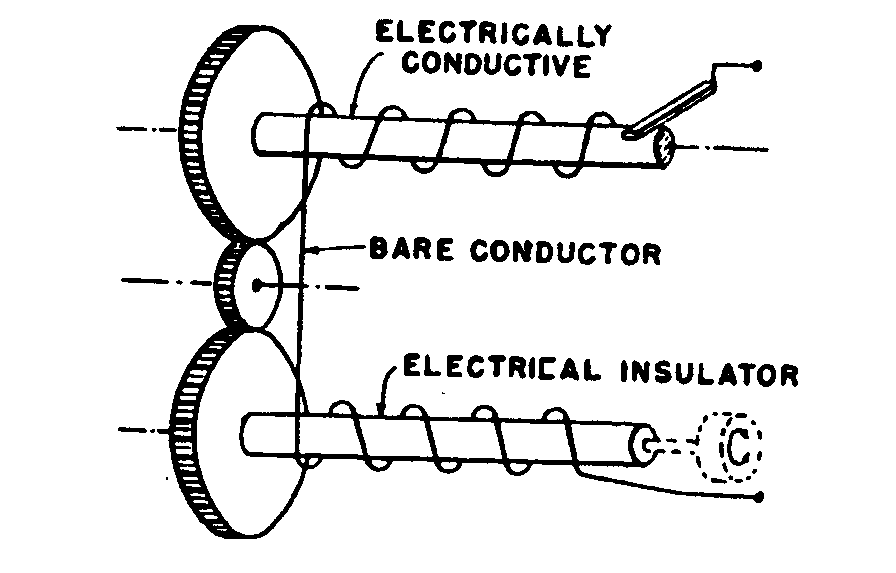
| SEE OR SEARCH THIS CLASS, SUBCLASS:
| 20, | for adjustable inductor devices wherein the inductance
change is effected by distorting or misshaping a coil conductor
and/or core of the regulator. |
| 116, | and 137+, for other adjustable
inductor devices wherein the inductive change is effected by altering
the effective length of the coil conductor by means other than winding
and/or unwinding the conductor. |
| 184, | for inductor devices with coils having different
axis or on different core legs. |
SEE OR SEARCH CLASS:
| 74, | Machine Element or Mechanism,
subclasses 10+ and the subclasses specified in the notes thereto
for mechanical mechanism for rotating a shaft including such mechanism
designed for use with an adjustable inductor device. Also
see the search notes to subclass 10 of Class 74 for the classification
of other rotary shaft moving mechanism and for the line between Class
336 and Class 74. |
| 191, | Electricity: Transmission to Vehicles,
subclasses 12.2+ for an electric current supply conductor and reel
means upon which the conductor may be wound. |
| 242, | Winding, Tensioning, or Guiding,
subclasses 370+ for a reeling device of general use. |
| 334, | Tuners,
subclass 38 for tuners having a reactor element which is adapted
to be wound or unwound upon a core or form. |
| 338, | Electrical Resistors,
subclass 79 for mechanically variable electric resistors in
which the resistance value is varied by winding the resistance element
from one core to another. |
| 343, | Communications: Radio Wave Antennas,
subclasses 700+ for radio antennae in which the effective length of
the antenna is changed by winding the radiating element of the antenna
in or out. |
|
| | |
![[List of Patents for class 336 subclass 20]](../ps.gif) 20 20 | WITH DEFORMABLE OR DISTORTABLE COIL AND/OR CORE: |
| | This subclass is indented under the class definition. Adjustable inductor devices wherein the inductance variation
is attained by changing the physical shape of either the coil or
core or both, usually by physically displacing portions of
the coil or core relative to other portions of the coil or core
respectively, by bending, twisting or stretching.
| | (1)
Note. The following are illustrative examples:
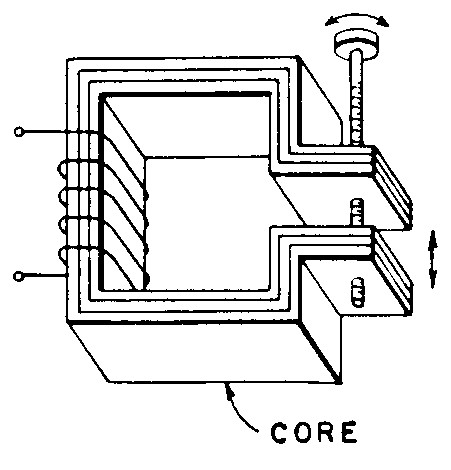
(a) The core is deformed. 
(b) The coil is deformed. |
| | (2)
Note. This subclass includes variable inductor devices
having a core or core part formed of magnetostrictive material which
material exhibits a change in volume and in magnetizing properties
when placed under mechanical stress. |
SEE OR SEARCH THIS CLASS, SUBCLASS:
| 15, | for adjustable inductor devices wherein the deformation
or distortion of the coil conductor is that caused by winding and/or
unwinding the conductor. |
| 115+, | for inductor devices having two or more coils which
are movable relative to each other. |
| 130, | for inductor devices having a relatively movable
magnetic core and coil. |
SEE OR SEARCH CLASS:
| 331, | Oscillators,
subclass 157 for oscillator systems having a frequency determining
element comprising electromechanical resonator of the magnetostrictive
type. |
| 343, | Communications: Radio Wave Antennas,
subclass 868 for loop type antennas with an adjustable configuration, area, or
coil length. |
| 367, | Communications, Electrical:
Acoustic Wave Systems and Devices,
subclass 168 for magnetostrictive electro-acoustic
or electro-vibrational transducers. |
| 369, | Dynamic Information Storage or Retrieval,
subclasses 146+ for magnetostrictive transducers for electromechanical
recording or reproducing. |
| 381, | Electrical Audio Signal Processing Systems and
Devices,
subclasses 150+ for electro-acoustical transducers of
the magnetostrictive type for use in telephony. Subclasses
150+ includes transmitters and receivers. |
|
| | |
![[List of Patents for class 336 subclass 30]](../ps.gif) 30 30 | WITH CONDITION-RESPONSIVE INDUCTANCE ADJUSTING
MEANS (E.G., BY ELECTROMAGNET): |
| | This subclass is indented under the class definition. Adjustable inductor devices where the change in inductance
is effected by adjusting or varying the inductance changing elements
of the device in response to a condition by condition sensing means
external to the device.
| | (1)
Note. The inductance varying element may be a thermally
responsive element (including those for temperature compensations; however, where
compensation is effected by the internal structure of the device, classification
is not herein but in subclass 179), a fluid pressure
diaphragm (e.g., a barometer), a
centrifugal device, or any other device or means responsive
to a condition. |
| | (2)
Note. The following are illustrative examples:
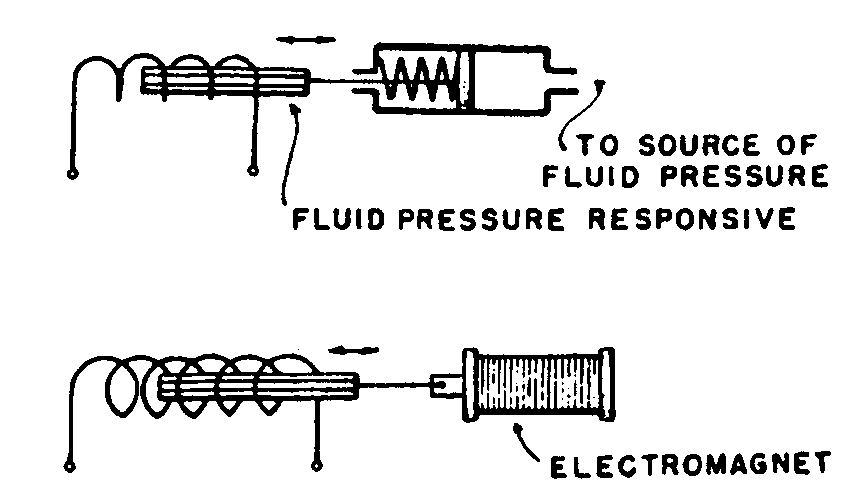
|
| | (3)
Note. See section VI of the class definition for
a listing of other classes which have condition response variable
inductor devices. |
SEE OR SEARCH THIS CLASS, SUBCLASS:
| 179, | and see (1) Note, above. |
SEE OR SEARCH CLASS:
| 307, | Electrical Transmission or Interconnection Systems, appropriate subclasses, for automatically
controlled systems of general application involving two or more
sources or input circuits and/or two or more output or load
circuits. |
| 323, | Electricity: Power Supply or Regulation
Systems, for single load regulation systems in which the
regulation is controlled by a condition. |
| 331, | Oscillators,
subclasses 65+ for oscillator systems combined with a device responsive
to an external physical condition and wherein a frequency determining
element (inductor or capacitor) of the oscillator
is varied by the condition sensing device. |
| 333, | Wave Transmission Lines and Networks,
subclasses 2+ and 17.1+ for wave transmission
lines and networks including an adjustable inductor with automatic
control, and subclasses 15 and 16 for pilot line and pilot
current control systems respectively which may include an adjustable
inductor with automatic control. |
| 334, | Tuners,
subclass 4 for magnetic responsive tuners; subclasses
5+ for tuners responsive to an external condition; subclass
13 for tuners having a saturable core type element and means to
automatically center the frequency of the circuit; subclass
16 for a tuner utilizing a reactance tube tuner combined with automatic
frequency centering circuit means, and subclasses 26+ for
a tuner having an electromagnetic operator with automatic frequency
centering means. |
| 455, | Telecommunications,
subclass 257 for receivers with automatic frequency control
and subclasses 150.1+ for particular frequency
selection means in radio receivers. |
|
| | |
![[List of Patents for class 336 subclass 40]](../ps.gif) 40 40 | ADJUSTABLE BY MAGNETIC FORCE BETWEEN RELATIVELY MOVABLE PARTS
OF THE INDUCTOR: |
| | This subclass is indented under the class definition. Adjustable inductor devices in which the inductance varying
element is adjusted in response to the magnetic force existing between
the magnetic elements (e.g., between the
core and coil or between coils) of the inductor device.
| | (1)
Note. Illustrative examples are:
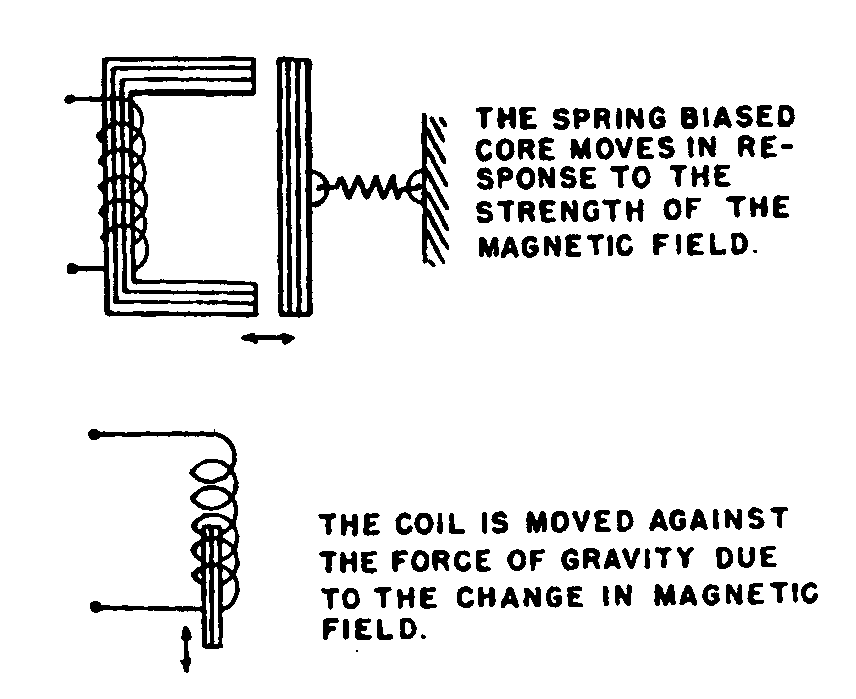
|
| | (2)
Note. This subclass includes inductor devices such
as are used in constant current systems. |
SEE OR SEARCH CLASS:
| 323, | Electricity: Power Supply or Regulation
Systems,
subclass 305 for single source to single load type constant current
regulation systems. |
|
| | |
![[List of Patents for class 336 subclass 41]](../ps.gif) 41 41 | Weight-counterbalanced coil or core: |
| | This subclass is indented under subclass 40. Subject matter in which the weight of one of the elements
which is moved by the magnetic force is counterbalanced at least
in part by a counterbalanced weight so that the magnetic force needed
to move the movable element is either less than or more than the
weight of the movable element.
| | (1)
Note. Where the inductor has a plurality of movable
inductance changing elements (e.g., a
movable coil and a movable core) one of the movable elements may
be used as a counterbalance for the others and vice versa. |
| | (2)
Note. An illustrative example is:
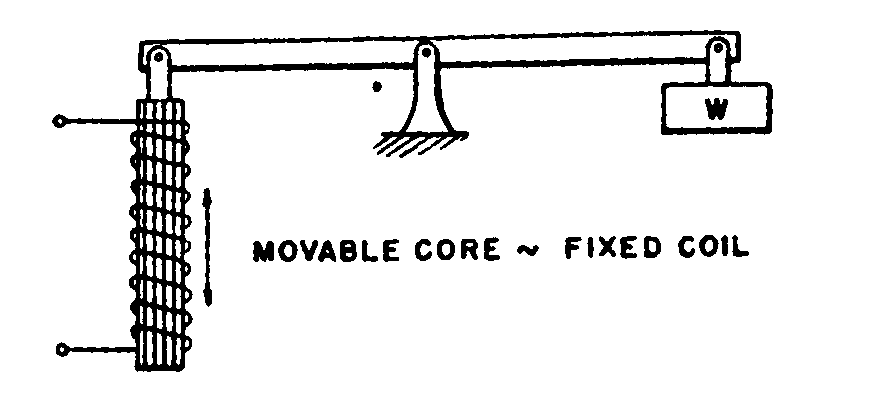
| SEE OR SEARCH CLASS:
| 248, | Supports, appropriate subclasses for counterbalanced movable supports
of general application. Note
subclass 364 of Class 248 and also see the Index to the Manual
of Classification of Patents under the titles "Weights" and "Counterweights"
for counterbalance weights. |
|
| | |
![[List of Patents for class 336 subclass 45]](../ps.gif) 45 45 | WITH MOVABLE ELEMENT POSITION INDICATOR: |
| | This subclass is indented under the class definition. Adjustable inductor devices in which means are provided
for showing the displacement of an inductance changing element of
the inductor device relative to some fixed part of the device.
SEE OR SEARCH CLASS:
| 116, | Signals and Indicators,
subclasses 241+ , for miscellaneous position indicators
other than the electrically actuated or controlled type. |
| 331, | Oscillators,
subclass 64 for oscillators having means for indicating the position
or setting of an adjustable frequency determining element of the oscillator, such
as a variable inductor or capacitor. |
| 340, | Communications: Electrical, appropriate subclasses for electrically actuated or controlled
signals and indicators, especially
subclasses 870.31+ for telemetric systems. |
|
| | |
![[List of Patents for class 336 subclass 55]](../ps.gif) 55 55 | WITH MOVABLE ELEMENT POSITION INDICATOR: |
| | This subclass is indented under the class definition. Inductor devices wherein means are provided for modifying
or for controlling the temperature of the inductor device.
SEE OR SEARCH THIS CLASS, SUBCLASS:
| 179, | for inductor devices whose inherent construction
is such as to maintain their inductance at a constant value, or which
permits their inductance to vary in a predetermined manner with changes
in temperature of the device. |
SEE OR SEARCH CLASS:
| 62, | Refrigeration, appropriate subclasses for miscellaneous refrigeration
apparatus, particularly
subclasses 259.1+ for refrigeration means installed in structures
having other functions. |
| 165, | Heat Exchange, appropriate subclasses for heat exchange apparatus combined
with a device to be cooled or heated thereby, if no structure
of such device is included other than that necessary for cooperation
with the heat exchange device. |
| 174, | Electricity: Conductors and Insulators,
subclasses 15.1+ for a mere housing, casing or envelope
for an electrical device where no significant structure of the device
is claimed with means for modifying the temperature of the device. |
| 310, | Electrical Generator or Motor Structure,
subclass 16 and 52+ for reciprocating and rotary dynamoelectric machines, respectively, with
cooling or temperature modification means. |
| 315, | Electric Lamp and Discharge Devices: Systems, particularly
subclass 50 for combined structure of a space discharge device
and impedance means, which means may be an inductor, and
which means is constructed to modify the temperature of the load
device. |
| 331, | Oscillators,
subclasses 69 and 70 for oscillator systems with means for modifying
or controlling the temperature of the oscillator or an element, such
as a tank circuit inductor, of the oscillator. |
| 454, | Ventilation, appropriate subclasses for miscellaneous ventilating
apparatus. |
|
| | |
![[List of Patents for class 336 subclass 57]](../ps.gif) 57 57 | With inductor insulating fluid circulating means: |
| | This subclass is indented under subclass 55. Subject matter in which the inductor device has a circumambient
liquid or gaseous insulating medium in contact with its coil or
core and wherein means, such as a pump or fan, is included
to force the medium to circulate for the purpose of effecting a
heat exchange between the medium and the inductor device.
SEE OR SEARCH CLASS:
| 62, | Refrigeration, particularly
subclasses 304+ for material cooling means including a gas-liquid
contactor, subclasses 373+ for a cooler in which
a liquid contacts a discrete commodity, and subclasses
403+ for a system for cooling a gas and controlling or directing
it, e.g., with an air pump. |
| 165, | Heat Exchange,
subclasses 104.22+ for a heat exchange device in which mechanically
impelled fluent material picks up heat at one point in a circuit
and discharges it at another. |
| 174, | Electricity: Conductors and Insulators,
subclass 15.1 for fluid feeding, circulating or distributing
for cooling electrical equipment generally and indented subclass
16.1 for such having ventilation and/or gas circulation. |
| 310, | Electrical Generator or Motor Structure,
subclasses 58+ for cooling or fluid contact means for rotary dynamo electric
machinery which includes means to circulate a coolant. |
|
| | |
![[List of Patents for class 336 subclass 58]](../ps.gif) 58 58 | Liquid insulating medium: |
| | This subclass is indented under subclass 55. Subject matter wherein the inductor device is immersed in
a heat exchanging medium comprising an insulating liquid.
| | (1)
Note. If the insulating liquid in which the inductor
is immersed is not specifically disclosed or claimed as a heat exchange
medium for the device classification is not herein but rather in
subclass 94 below. |
SEE OR SEARCH CLASS:
| 208, | Mineral Oils: Processes and Products,
subclass 14 for an insulating oil comprising only mineral oil
components. |
| 252, | Compositions,
subclasses 570+ for fluent dielectric compositions containing a
nonhydrocarbon material. |
| 585, | Chemistry of Hydrocarbon Compounds,
subclasses 6.3+ for an all-hydrocarbon insulating oil
containing more than mineral oil fractions. |
|
| | |
![[List of Patents for class 336 subclass 59]](../ps.gif) 59 59 | Vented casing: |
| | This subclass is indented under subclass 55. Subject matter wherein the inductor has a housing or casing
which is provided with apertures (usually open to the atmosphere) to
allow circulation of air over selected surfaces of the contained
inductor.
SEE OR SEARCH CLASS:
| 165, | Heat Exchange,
subclasses 128+ for a heat exchange structure having a thermosyphonic
flue. |
| 174, | Electricity: Conductors and Insulators,
subclass 16.1 for a mere housing or casing for an electrical
device, where no significant structure of the device is
claimed, with means to provide for ventilation of the interior
of the casing. |
| 454, | Ventilation, appropriate subclasses for miscellaneous ventilating
structure such as cowls, hoods and louvers. |
|
| | |
![[List of Patents for class 336 subclass 60]](../ps.gif) 60 60 | Ventilating passages (e.g., by
coil section or core part spacers): |
| | This subclass is indented under subclass 55. Subject matter comprising passages between or through various
components of the inductor structure so that a cooling fluid may
circulate therethrough.
| | (1)
Note. The passageways may be formed by coil or winding
and/or core part spacers. |
SEE OR SEARCH THIS CLASS, SUBCLASS:
| 185, | for windings formed of multiple coils with spacers
therebetween. |
| 196+, | for spacing means between coil and core. |
| 199+, | for spacing means between coils or coil turns. |
SEE OR SEARCH CLASS:
| 310, | Electrical Generator or Motor Structure,
subclass 65 for rotary dynamo-electric machine structure
wherein spacers are provided between motor core laminations or coils
to effect a heat exchange between a fluid medium and the core or
coils. |
|
| | |
![[List of Patents for class 336 subclass 61]](../ps.gif) 61 61 | Heat exchanging surfaces: |
| | This subclass is indented under subclass 55. Subject matter wherein a heat exchanging surface is structurally
combined with the coil or winding or the core of the inductor, or
the coil or winding or the core is especially adapted by its structure
to have a heat exchanging surface.
| | (1)
Note. The heat exchanging surface is not limited
to heat radiating surfaces but the heat exchange may take place
by conduction or convection or a combination of the various types
of heat transfer, the essential element required for this subclass
being a surface, adapted for heat transfer in intimate
relationship with the coil or winding or the core of the inductor. |
SEE OR SEARCH CLASS:
| 165, | Heat Exchange,
subclass 185 for a heat transmitter, per se. |
| 310, | Electrical Generator or Motor Structure,
subclasses 64+ for heat exchanging surfaces in rotary dynamoelectric machines. |
|
| | |
![[List of Patents for class 336 subclass 62]](../ps.gif) 62 62 | Hollow conductor coil: |
| | This subclass is indented under subclass 55. Subject matter wherein at least one coil of the inductor
device is formed of a tubular conductor which is designed to convey
a temperature modifying fluid therethrough.
SEE OR SEARCH THIS CLASS, SUBCLASS:
| 223, | for windings having conductors of a particular shape
including tubular. |
SEE OR SEARCH CLASS:
| 138, | Pipes and Tubular Conduits, appropriate subclasses for miscellaneous pipe and
tubular conduit structure. |
| 174, | Electricity: Conductors and Insulators,
subclasses 28+ for co-axial type conductors with fluid
or vacuum insulation, subclass 102 for conductors formed
as tubular sheaths for other conductors, and subclasses
126.1+, and especially indented subclasses 130
and 131 for hollow electric conductors of the stranded type. |
| 219, | Electric Heating,
subclasses 600+ for inductive heating, note subclasses 628+ for
an inductor structure having a fluid flow; subclasses 678+ for microwave
heating; and subclasses 764+ for capacitive dielectric
heating. |
|
| | |
![[List of Patents for class 336 subclass 65]](../ps.gif) 65 65 | WITH MOUNTING OR SUPPORTING MEANS (E.G., BASE): |
| | This subclass is indented under the class definition. Inductor devices having exterior means to support the entire
inductor structure.
| | (1)
Note. A support is defined as a device or means
which carries the weight of the inductor device or otherwise hold
or steady it against the pull of gravity. |
| | (2)
Note. Means for supporting parts or elements of
the inductor device with respect to each other are not considered
support or mounting means for classification in this subclass. |
| | (3)
Note. A mere casing or housing for the inductor
device is not considered to be a supporting means within the definition of
this subclass. However, if the casing or housing
is provided with means for supporting the casing or housing such
as being mounted on supporting legs or wheels or has legs extending
from the casing so that casing can be mounted on a panel or wall, the
structure is considered to be supporting structure for this subclass. |
SEE OR SEARCH THIS CLASS, SUBCLASS:
| 92, | for inductor devices provided with means to support
the inductor device within the casing. |
| 185, | for supports or spacers for the coils of a winding. |
| 195, | for one coil supported by another coil. |
| 196+, | for supporting or spacing means between coil and
core. |
| 199+, | for coil or coil turn supports. |
| 210+, | for core clamps, wedges or fasteners. |
SEE OR SEARCH CLASS:
| 174, | Electricity: Conductors and Insulators,
subclass 37 for underground supports for electrical devices; subclass 40
for overhead supports for electrical devices; subclasses
50-64, particularly subclasses 58 and 63, for
means to mount or support a casing or housing for an electrical
device; and subclasses 480-507 for means for mounting
miscellaneous casings or housings for electrical devices on or within
a wall of a building structure. |
| 248, | Supports, appropriate subclasses for miscellaneous supports. |
| 310, | Electrical Generator or Motor Structure,
subclass 91 for dynamoelectric machines combined with supporting means
therefor. |
| 343, | Communications: Radio Wave Antennas,
subclass 869 for loop type antennas with a rotatable support. |
| 361, | Electricity: Electrical Systems and Devices,
subclasses 600+ for mounting means for switchboards or plural diverse. |
|
| | |
![[List of Patents for class 336 subclass 66]](../ps.gif) 66 66 | Handle: |
| | This subclass is indented under subclass 65. Subject matter provided with means to manually hold or support
the inductor device.
SEE OR SEARCH CLASS:
| 16, | Miscellaneous Hardware (e.g., Bushing, Carpet
Fastener, Caster, Door Closer, Panel
Hanger, Attachable or Adjunct Handle, Hinge, Window
Sash Balance, etc.),
subclasses 110.1 through 430 for handles in general. |
| 174, | Electricity: Conductors and Insulators,
subclass 46 for handles restricted by structure to use with
electrical apparatus in general. The Notes listed under
subclass 46 of Class 174 indicate other fields of search for devices with
handles. |
| 310, | Electrical Generator or Motor Structure,
subclass 50 for rotary dynamoelectric machines of the portable
or hand tool type. |
|
| | |
![[List of Patents for class 336 subclass 67]](../ps.gif) 67 67 | Bracket: |
| | This subclass is indented under subclass 65. Subject matter provided with means to rigidly attach and
support the inductor on or to a supporting surface. Usually
the support is adapted to be fastened to a wall and projects therefrom to
support the inductor in cantilever fashion.
SEE OR SEARCH CLASS:
| 174, | Electricity: Conductors and Insulators, particularly
subclasses 480 through 507for wall-mounted conduits or housings. |
| 248, | Supports, appropriate subclasses for object supporting brackets of
general application, see particularly
subclasses 200+ . |
|
| | |
![[List of Patents for class 336 subclass 68]](../ps.gif) 68 68 | Suspension: |
| | This subclass is indented under subclass 65. Subject matter provided with mechanical coupling means by
means of which the inductor may be hung from an overhead position.
SEE OR SEARCH CLASS:
| 248, | Supports, appropriate subclasses for object supporting suspension
type supports, see particularly
subclasses 317+ . |
|
| | |
![[List of Patents for class 336 subclass 69]](../ps.gif) 69 69 | WITH COIL CAPACITANCE MODIFYING MEANS: |
| | This subclass is indented under the class definition. Inductor devices comprising means to modify the inherent
capacitive effects between (a) adjacent turns
of a winding, or (b) between adjacent
windings, or (c) between windings or turns
and adjacent structure such as a core or casing therefor.
| | (1)
Note. The modification of the capacitive effects
may be accomplished, for example, by the provision
of appropriately placed shield members, or open-circuited
auxiliary coils, or by use of a dielectric of graded thickness
or composition. |
| | (2)
Note. The capacitive effect modifying means may
be, for example, to eliminate undesired coupling
between windings, or to protect the inductor from breakdown of
the insulation on the occurrence of high amplitude transient potentials
at the inductor terminals (see indented subclass 70 for
such transient control). |
| | (3)
Note. Mere arrangement of the conductor winding
pattern to prevent undesired coupling between coils is not subject matter
for this subclass. Such subject matter may be found in
the appropriate subclass for the structure involved. |
SEE OR SEARCH CLASS:
| 178, | Telegraphy, appropriate subclasses for telegraph systems with inductors and
capacity balancing means, especially
subclass 45 for loading coils, and subclasses 63 and
69 for cable or line capacity correction. |
| 307, | Electrical Transmission or Interconnection Systems,
subclasses 89+ for anti-inductive systems in general. |
| 333, | Wave Transmission Lines and Networks, appropriate subclasses for wave transmission lines and
networks having inductor elements including means to balance the
capacitance of the elements with respect to a particular potential
plane, see particularly
subclasses 4+ , 117+ and 25+. |
| 361, | Electricity: Electrical Systems and Devices,
subclass 270 for structural combinations of an inductor and
a capacitor. |
| 379, | Telephonic Communications, appropriate subclasses for telephone systems with inductors
and capacity balancing means, especially
subclass 398 and 415 for anti-inductive telephone devices. |
|
| | |
![[List of Patents for class 336 subclass 70]](../ps.gif) 70 70 | With surge potential gradient modifying means: |
| | This subclass is indented under subclass 69. Subject matter wherein the inherent inductor capacitance
relationships are modified by additional means which change the
potential gradient distribution through at least part of the inductor, and
which may include, in addition, connections to
various fixed or other potential points in the inductor, or
a rearrangement of coils or terminals to attain a potential gradient distribution
which will minimize the deleterious effect of surge or transient
electrical pulses or waves to which the inductor may be subjected.
SEE OR SEARCH THIS CLASS, SUBCLASS:
| 84, | for inductors with electric or magnetic shielding
means for shielding the inductor from stray fields or for preventing
radiation of undesired electric or magnetic field energy. |
SEE OR SEARCH CLASS:
| 174, | Electricity: Conductors and Insulators,
subclass 127 for conductor structure which prevents corona discharge, including
such structure which performs this function by preventing high electrostatic
stress at any point; and subclasses 140+ for insulators, including
those combined with conductive means which function together to
control the voltage gradient, particularly subclass 143
for bushing type insulators with alternating rings or cylinders of
conductive and insulating material which exert a modifying effect
on the capacitance between inner and outer conductors of the bushing, particularly
for voltage stress distribution. |
| 307, | Electrical Transmission or Interconnection Systems,
subclass 327 for protective systems for surge, transient or
parasitic current suppression in general. |
| 310, | Electrical Generator or Motor Structure,
subclass 196 for dynamoelectric machine armature or primary
winding structure including corona discharge prevention means. |
|
| | |
![[List of Patents for class 336 subclass 73]](../ps.gif) 73 73 | WITH CLOSED COIL OR CONDUCTOR MEMBER: |
| | This subclass is indented under the class definition. Inductor devices which include a coil and a member which
has at least a portion of the member formed of nonmagnetic electrically conductive
material, the member being shaped so that it provides a
closed electrical circuit for current induced therein.
| | (1)
Note. The conductive member may be a closed coil, a
plate, bar or slug, and need not be formed wholly
of nonmagnetic material (see indented subclass 77 for relatively
movable members of such construction). |
SEE OR SEARCH THIS CLASS, SUBCLASS:
| 84+, | for electric and/or magnetic shields which
may be disclosed as closed conductive members. |
SEE OR SEARCH CLASS:
| 310, | Electrical Generator or Motor Structure,
subclasses 182+ and 197 for short-circuited windings or
conductors in field or armature windings, respectively, for
rotary dynamoelectric machines. |
|
| | |
![[List of Patents for class 336 subclass 75]](../ps.gif) 75 75 | Movable with respect to another coil: |
| | This subclass is indented under subclass 73. Subject matter wherein the coil and the conductive member
are relatively movable with respect to each other.
| | (2)
Note. Illustrative examples are:

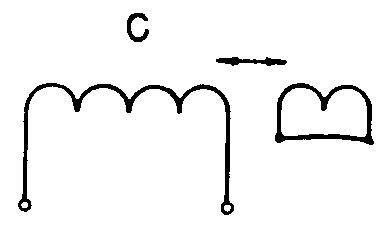
| SEE OR SEARCH THIS CLASS, SUBCLASS:
| 138, | and 144, for adjustable inductor devices
which have closed coils or short-circuited turns which
are fixed in position relative to the coil or coils of the inductor
device. |
SEE OR SEARCH CLASS:
| 331, | Oscillators,
subclass 181 for oscillator systems with a variable inductance frequency
determining means, which variable inductance may be of
the angularly adjustable vane type. |
|
| | |
![[List of Patents for class 336 subclass 77]](../ps.gif) 77 77 | With magnetic portion: |
| | This subclass is indented under subclass 75. Devices in which a portion of the member is formed of magnetic
material.
| | (1)
Note. An illustrative example is:
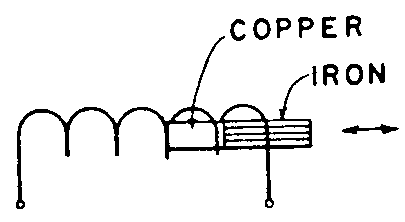
| SEE OR SEARCH THIS CLASS, SUBCLASS:
| 117+, | for inductor devices having relatively movable coils
and a core, at least one of the coils and the core being
relatively movable, see indented subclass 119 where a coil
and the core are movable as a unit with respect to another coil. |
| 130+, | for inductor devices having one or more coils and
a core, the core and a coil being relatively movable with respect
to each other. |
| 221, | for inductor devices comprising miscellaneous core
and coil combinations. |
|
| | |
![[List of Patents for class 336 subclass 79]](../ps.gif) 79 79 | Angularly movable: |
| | This subclass is indented under subclass 75. Devices in which the member is movable about an axis of
rotation.
| | (1)
Note. An illustrative example is:
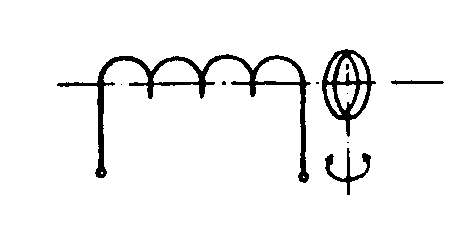
| SEE OR SEARCH THIS CLASS, SUBCLASS:
| 120+, | for inductor devices having relatively movable coils
and a core, a coil and a core being relatively movable
as a unit about an axis of rotation. |
| 122+, | and the subclasses specified in the Notes thereto
for inductor devices having relatively movable coils, one of
the coils being movable about an axis of rotation. |
SEE OR SEARCH CLASS:
| 74, | Machine Element or Mechanism,
subclasses 10+ and the subclasses specified in the Notes thereto
for mechanical mechanism for rotating a shaft including such mechanism
designed for use with an adjustable inductor device. Also
see the search notes to subclass 10 of Class 74 for the classification
of other rotary shaft moving mechanism and for the line between Class
336 and Class 74. |
| 310, | Electrical Generator or Motor Structure,
subclasses 105+ for induced or eddy current magnetic field type
of torque transmitting clutch or brake which have a rotating short-circuited or
conducting disc member, and subclasses 210+ for
dynamoelectric machines with secondary windings or conductors which
may include such of the short-circuited coil or disc conductor
type. |
| 324, | Electricity: Measuring and Testing,
subclasses 137+ for meters with eddy current rotors. |
| 335, | Electricity: Magnetically Operated Switches, Magnets, and
Electromagnets,
subclass 225 for magneto-mechanical motive devices
with relatively, movable members of the induced current
type, (e.g., rotary disk); and
subclass 226 specifically for such with short-circuited
coils. |
|
| | |
![[List of Patents for class 336 subclass 82]](../ps.gif) 82 82 | COIL FORMS PROTECTIVE CASING: |
| | This subclass is indented under the class definition. Inductor devices wherein a coil or winding of the inductor
consists of a solid, unitary preformed casing which substantially
completely encloses the rest of the inductor structure.
A wound coil such as a toroidal or spherical coil which completely
encloses another coil and/or core is excluded from this subclass
and may be found in the appropriate structural subclasses below.
SEE OR SEARCH CLASS:
| 333, | Wave Transmission Lines and Networks,
subclasses 222+ for high frequency resonators of the distributed parameter
type which may include a rigid external conductive casing. |
| 334, | Tuners,
subclasses 41+ for resonant line tuning units wherein the tuning capacitor
may be enclosed in a rigid conductive casing comprising the tuner
inductor, and subclass 85 for a tuner having shielding
or housing means which may be a rigid conductive casing which serves
as an inductance element. |
|
| | |
![[List of Patents for class 336 subclass 83]](../ps.gif) 83 83 | CORE FORMS CASING: |
| | This subclass is indented under the class definition. Inductor devices wherein the coils or windings are substantially
completely enclosed by the core structure except for such apertures in
the core structure necessary to allow passage of the coil or winding
leads.
| | (1)
Note. If a casing or housing having an inductor
therein serves as a portion of the magnetic path of the inductor, classification
is herein rather than in subclasses 90+. |
SEE OR SEARCH THIS CLASS, SUBCLASS:
| 214+, | for inductors with cores wherein multiple separate
magnetic paths are provided in the core structure. |
|
| | |
![[List of Patents for class 336 subclass 84]](../ps.gif) 84 84 | WITH ELECTRIC AND/OR MAGNETIC SHIELDING MEANS: |
| | This subclass is indented under the class definition. Inductor devices provided with means for shielding at least
part of the inductor device from external electric or magnetic fields, or with
means to protect parts of the device from undesired electric or
magnetic fields originating in another part of the device, or
with means to prevent the inductor device from emanating undesired
electric or magnetic fields.
SEE OR SEARCH THIS CLASS, SUBCLASS:
| 69+, | for inductive devices having coil capacitance modifying
means and in which electrostatic shields are associated with the
coil means to shield coils from each other, or in special arrangements
for balancing coil capacitances, or to modify the coil surge
potential gradient. |
| 73+, | for inductive devices having a closed or short-circuited
coil which is often in the form of a conductive screen or plate
of the electrostatic shield type, and indented subclasses
75+ for inductor devices having a movable nonmagnetic conductive
screen or shield which is used to vary the effective inductance
of the inductor device. |
| 82, | for inductive devices wherein a coil, formed
as a solid, unitary structure of conductive material, forms
the casing of the inductive device and may function in part like
an electrostatic shield. |
| 83, | for inductive devices wherein the coil or winding
thereof is totally enclosed by a magnetic core (so-called
"ironclad" cores) which structure tends to confine the
electromagnetic field within the bounds of the inductor. |
| 90+, | for inductor devices with casings or housings not
limited by claimed subject matter to electric or magnetic shielding. |
SEE OR SEARCH CLASS:
| 174, | Electricity: Conductors and Insulators,
subclasses 32 through 397for miscellaneous anti-inductive structures, particularly
subclasses 350-397 for miscellaneous electrical shields and
screen structures not elsewhere classifiable. The search
notes to subclasses 32-397 indicate further fields of search
for anti-inductive and shielding structure. |
| 307, | Electrical Transmission or Interconnection Systems,
subclasses 39+ for anti-inductive means to prevent or modify
the coupling between electrical systems, particularly subclass
91 for "shielding means." |
| 310, | Electrical Generator or Motor Structure,
subclass 256 for stray field flux loss prevention by shielding
means in rotary dynamoelectric machines. |
| 330, | Amplifiers,
subclass 68 for amplifiers combined with significant details of
shielding structure, generally, subclass 170 for
amplifiers having transformer coupling including shielding means
involved in such transformer coupling. |
| 331, | Oscillators,
subclass 67 for oscillator systems provided with an electromagnetic
or electrostatic shield. The shield may be for an element (such
as an inductor) of the oscillator system. |
| 333, | Wave Transmission Lines and Networks,
subclass 12 for transmission line inductive or radiation interference reduction
systems which include shielding means for the purpose. |
| 343, | Communications: Radio Wave Antennas,
subclass 842 for loop type antennas with an electrical shield. |
| 361, | Electricity: Electrical Systems and Devices,
subclasses 268+ for inductors with integral switch or capacitor means, particularly
subclass 270 for those inductive devices structurally combined with
a capacitor. |
|
| | |
![[List of Patents for class 336 subclass 87]](../ps.gif) 87 87 | Adjustable inductor: |
| | This subclass is indented under subclass 84. Subject matter wherein means for adjustment of the inductance
of the inductor device are included. |
| | |
![[List of Patents for class 336 subclass 90]](../ps.gif) 90 90 | WITH OUTER CASING OR HOUSING: |
| | This subclass is indented under the class definition. Inductor devices provided with a casing or housing to enclose
the inductor device.
| | (1)
Note. The casing or housing surrounding the inductor
device in the patents of this and indented subclasses is disclosed primarily
as a mechanical protection for, or to contain an insulating
medium around, the inductor. |
| | (2)
Note. If the casing or housing is claimed as an
electric or magnetic shield, the patent is excluded and
classified in subclasses 84+. |
| | (3)
Note. For classification in this or indented subclasses
some detail of the inductor device such as a winding must be claimed.
If the recitation in the claim of an inductor device is by name
only, the patent is not classified herein but rather in
the appropriate subclasses in Class 174. |
SEE OR SEARCH THIS CLASS, SUBCLASS:
| 55+, | for inductor devices having casings combined with
means to modify the temperature of the inductor. See especially
subclass 59 for vented casings. |
| 65+, | for inductor devices having casings with external
mounting means. |
| 82, | for inductor devices wherein a unitary preformed
coil or winding forms the casing. |
| 83, | for inductor devices wherein the core forms a casing
for the windings. |
SEE OR SEARCH CLASS:
| 174, | Electricity: Conductors and Insulators, for miscellaneous casings and housings for electrical devices
including such casings and housings, in combination with
an electrical device recited by name only, particularly
subclasses 8+ for such devices intended to be used with a fluid
or vacuum; subclasses 37+ for underground vaults
for electrical devices; and subclasses 50+ for
such devices of general utility. |
| 220, | Receptacles, appropriate subclasses for miscellaneous box, housing
or casing structure of general utility. |
| 324, | Electricity: Measuring and Testing,
subclass 156 for casings for electrical measuring instruments. |
| 361, | Electricity: Electrical Systems and Devices,
subclasses 600+ for housings and mounting assemblies with plural
diverse electrical components. |
|
| | |
![[List of Patents for class 336 subclass 92]](../ps.gif) 92 92 | Internal inductor support: |
| | This subclass is indented under subclass 90. Subject matter wherein means are provided within the casing
to maintain the inductor device in a predetermined relation to the
casing.
SEE OR SEARCH THIS CLASS, SUBCLASS:
| 65+, | for the combination of an inductor with means to
support it with respect to its environment. Housed inductor devices
with means external of the housing for supporting the device are in
subclasses 65+. |
|
| | |
![[List of Patents for class 336 subclass 94]](../ps.gif) 94 94 | Fluid insulation: |
| | This subclass is indented under subclass 90. Subject matter wherein the housing or casing containing
the inductor contains an insulating fluid in which the inductor
is immersed.
| | (1)
Note. If means are provided for circulating the
insulating fluid, for cooling purposes, the patent
is not classified herein but rather in subclass 57. |
| | (2)
Note. If the insulating fluid comprises a liquid
and is provided for a cooling effect, classification is
not herein but rather in subclass 58. |
| | (3)
Note. For the locus of patents to insulating fluids, per
se, see the search notes in subclass 58. | |
| | |
![[List of Patents for class 336 subclass 96]](../ps.gif) 96 96 | Potted type: |
| | This subclass is indented under subclass 90. Subject matter wherein the space between the casing or housing
and the inductor and its interstices is occupied by a semisolid
or solidified mass of insulating material such as sand or asphalt (or
other plastic material).
SEE OR SEARCH THIS CLASS, SUBCLASS:
| 58, | and 94, for inductors immersed in an insulating
medium which is in a fluid state. |
|
| | |
![[List of Patents for class 336 subclass 98]](../ps.gif) 98 98 | Exposed core portions: |
| | This subclass is indented under subclass 90. Subject matter wherein a portion of the inductor core protrudes
from the casing or housing, e.g., a
transformer with "end bells" covering only the windings and a portion
of the core. |
| | |
![[List of Patents for class 336 subclass 100]](../ps.gif) 100 100 | WITH VIBRATION CONTROL: |
| | This subclass is indented under the class definition. Inductor devices which are especially designed or provided
with some structure to inhibit or reduce the vibration, to
prevent failure from the vibration or to eliminate or reduce the
effects upon the device of the vibration caused by the fluctuations
in magnetic flux.
SEE OR SEARCH CLASS:
| 74, | Machine Element or Mechanism,
subclass 574.1 for flywheel with electrical or magnetic damping; subclass 574.2
for damping using swinging masses, e.g., pendulum
type for damping, etc.; subclass 574.3
for damping by increasing frictional force; and subclass
574.4 for damping by absorbing the vibration force (via rubber, elastomeric
material, etc.). |
| 188, | Brakes,
subclasses 371+ for braking devices which use plastic deformation or
breakage of a retarder element to dissipate motion; subclasses
378+ for braking devices which use the inertia of a damping
mass; subclasses 266+ for internal resistance
type braking devices or vibration damping means; and subclass
381 for vibration dampers which use friction between damper elements. |
| 248, | Supports,
subclasses 560+ for resilient supports. |
| 267, | Spring Devices, appropriate subclasses, for miscellaneous
spring structures. |
| 310, | Electrical Generator or Motor Structure,
subclass 51 for miscellaneous vibration suppression means utilized in
rotary dynamoelectric machinery, subclass 93 for electrodynamic
brakes utilized to damp out vibrations. |
| 464, | Rotary Shafts, Gudgeons, Housings, and
Flexible Couplings for Rotary Shafts,
subclasses 127 and 180 for shaft couplings and shafting having vibration
dampening characteristics. |
|
| | |
![[List of Patents for class 336 subclass 105]](../ps.gif) 105 105 | COMBINED: |
| | This subclass is indented under the class definition. Inductor devices combined with structure other than the
coil structure or the core structure or the supporting and spacing
structure for mounting the coils and/or cores with respect
to each other, or the structure or means for electrically
insulating the coil and core structure, and which are not
classified in any of the subclasses in this class preceding this
subclass.
| | (1)
Note. If the other structure is a switch for varying
the inductance of the device, as a tap changing switch, the
patent is excluded from this subclass, and will be found
in subclass 150 of this class or one of the subclasses specified
in the Notes to that subclass. If the switch interrupts or
completes the line circuit to the inductor, the patent
is excluded and may be found in Class 361, Electricity: Electrical
Systems and Devices, subclass 157.6. |
| | (2)
Note. An illustrative example is:

| |
| | |
![[List of Patents for class 336 subclass 107]](../ps.gif) 107 107 | With connector: |
| | This subclass is indented under subclass 105. Subject matter combined with means to complete an external
electrical circuit connection to the inductor, said means
comprising readily-detachable, interengaging friction
or screw held, or pressure-exerting, coupling
elements.
SEE OR SEARCH THIS CLASS, SUBCLASS:
| 192, | for inductor devices with terminals adapted to make
permanent or semi-permanent connections with an external
electrical circuit (e.g., solder
lugs). |
SEE OR SEARCH CLASS:
| 343, | Communications: Radio Wave Antennas,
subclass 870 for loop type antennas with a connector or terminals. |
| 439, | Electrical Connectors, appropriate subclasses for an electrical connector, per
se, generally. |
|
| | |
![[List of Patents for class 336 subclass 110]](../ps.gif) 110 110 | WITH PERMANENT MAGNET: |
| | This subclass is indented under the class definition. Inductor devices which are provided with a permanent magnet
to modify the magnetic flux distribution.
| | (1)
Note. An illustrative example is:
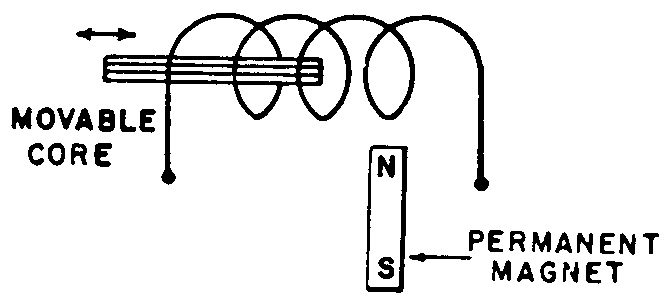
| SEE OR SEARCH THIS CLASS, SUBCLASS:
| 155+, | for inductor devices having a winding adapted to
be energized by direct current to modify the magnetic flux distribution
of the device. |
SEE OR SEARCH CLASS:
| 323, | Electricity: Power Supply or Regulation
Systems,
subclasses 250 , 330, and 362 for miscellaneous
inductive reactor systems where the reactor includes a permanent
magnet as a part thereof. |
| 343, | Communications: Radio Wave Antennas,
subclass 788 for loop type antennas with magnetic material. |
|
| | |
![[List of Patents for class 336 subclass 115]](../ps.gif) 115 115 | RELATIVELY MOVABLE COILS: |
| | This subclass is indented under the class definition. Inductor devices having two coils which are relatively movable
with respect to each other.
| | (1)
Note. Illustrative examples are:
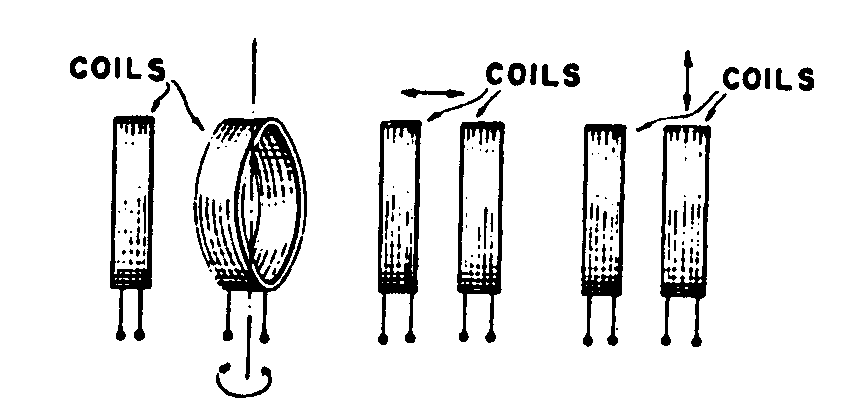
| SEE OR SEARCH THIS CLASS, SUBCLASS:
| 75+, | for inductor devices having a coil and a closed
coil which are relatively movable with respect to each other. |
| 170+, | 180+, 188, and 220, for
inductor devices having plural, nonrelatively movable coils
or windings. |
| 323, | Electricity: Power Supply or Regulation
Systems, subclasses 216, 264, and 347
for inductor systems with movable structure or windings. |
| 330, | Amplifiers, subclasses 65+ for
amplifiers combined with significant structural detail of any of
the circuit elements which may include inductor structure; subclasses
171, 190, and 197 for amplifiers having transformer coupling
including significant details of the transformer structure, subclass 169
for amplifiers having transformer coupling including means for adjusting
such inductive coupling. |
| 333, | Wave Transmission Lines and Networks, subclasses
24+ for coupling networks, including filters, equalizers, and
delay networks, having relatively movable coils, and
especially subclasses 177+ for transformer coupled wave
filters. |
| 334, | Tuners, subclasses 59+ for tuners
having tuned transformer circuits which are substituted by switching
in which the primary may remain stationary while the secondary is
moved relative to the primary, and subclasses 61+ for tuners
having mutual inductance variable means which may be relatively displaceable
coils. |
| 428, | Stock Material or Miscellaneous Articles, subclass
591 for metallic stock having parts which are relatively movable
with respect to each other. |
|
| | |
![[List of Patents for class 336 subclass 116]](../ps.gif) 116 116 | With means to change coil length and/or connections: |
| | This subclass is indented under subclass 115. Subject matter wherein one of the coils is provided with
means (a) to change the physical length of the
coil which is effective as an inductive component, (b) to
add or cut out turns or coils or to substitute a coil section or component
of different characteristics or position for a coil or (c) to
change the direction of current flow through at least a portion
of the coil conductor.
| | (1)
Note. Illustrative examples are:
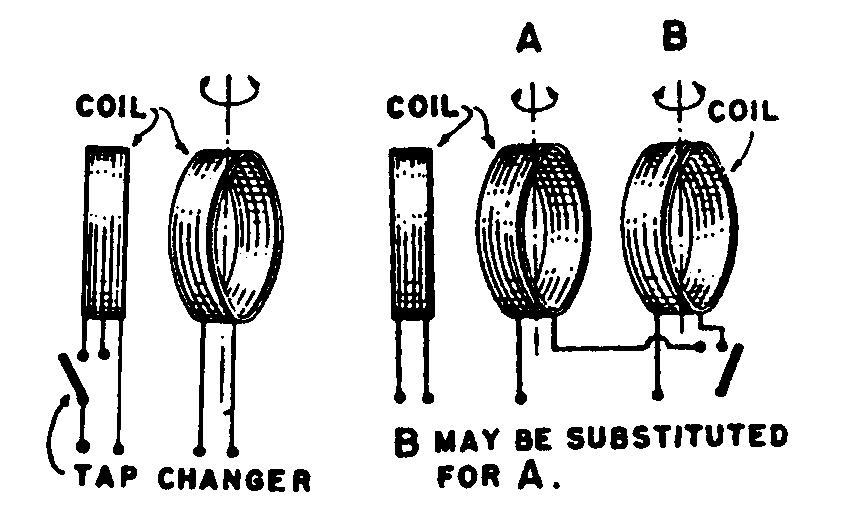
| SEE OR SEARCH THIS CLASS, SUBCLASS:
| 15, | for adjustable inductor devices having means for
varying the number of turns of the coil by winding or unwinding the
coil. |
| 137+, | for other inductor devices wherein the inductance
change is effected by changing the effective coil length and/or
coil connections. |
SEE OR SEARCH CLASS:
| 323, | Electricity: Power Supply or Regulation
Systems,
subclasses 255 and 340 for transformer systems with tapped windings. |
|
| | |
![[List of Patents for class 336 subclass 117]](../ps.gif) 117 117 | With core: |
| | This subclass is indented under subclass 115. Subject matter wherein one of the coils is provided with
a core.
| | (1)
Note. The core may extend through the fixed and
movable coil (e.g., the movable
coil may slide along the core), or one coil may
be provided with a core fixed in relation thereto and the other coil
may be relatively movable with respect to the fixed coil and core, or
each coil may be mounted on respective complementary portions of
a two part core. |
| | (2)
Note. Illustrative examples are:
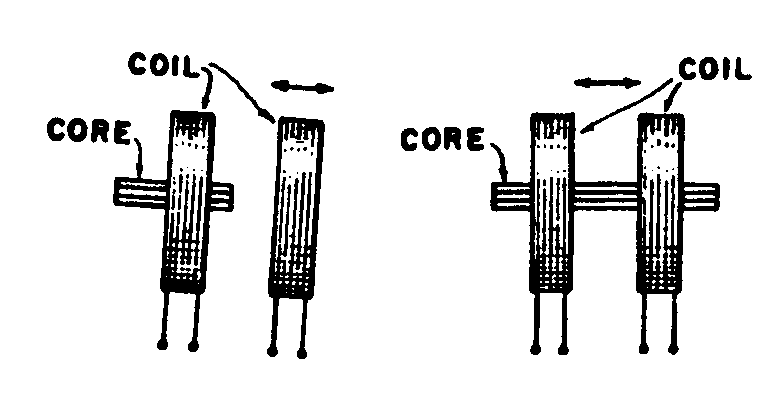
| SEE OR SEARCH THIS CLASS, SUBCLASS:
| 40+, | for adjustable inductor devices having relatively
movable coils and a core where the movement of the movable core
is effected by the change in magnetic force between the two coils (e.g., constant
current devices). |
| 130+, | where the inductor device has a core movable with
respect to one or more coils. |
| 333, | Wave Transmission Lines and Networks, subclasses
177+ for transformer coupled wave filters with magnetic
core inductances. |
|
| | |
![[List of Patents for class 336 subclass 118]](../ps.gif) 118 118 | Relatively movable core and coils: |
| | This subclass is indented under subclass 117. Subject matter, wherein the core is relatively movable
with respect to the two coils which are movable with respect to
each other.
| | (1)
Note. Illustrative examples are:
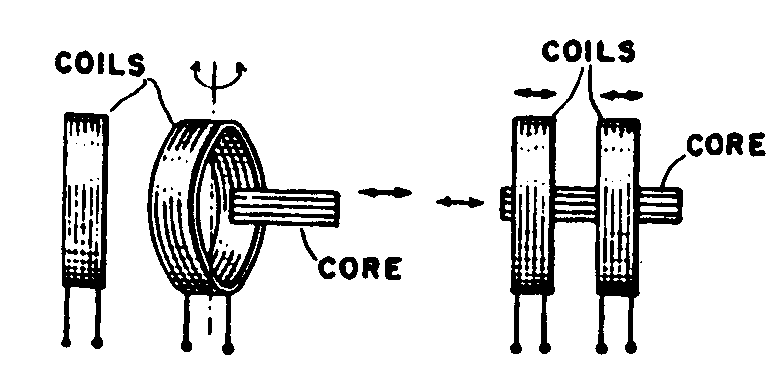
| |
| | |
![[List of Patents for class 336 subclass 119]](../ps.gif) 119 119 | Coil and core movable as a unit: |
| | This subclass is indented under subclass 117. Subject matter wherein a core and a coil which are fixed
with respect to each other are movable as a unit relative to another
coil.
| | (1)
Note. An illustrative example is:
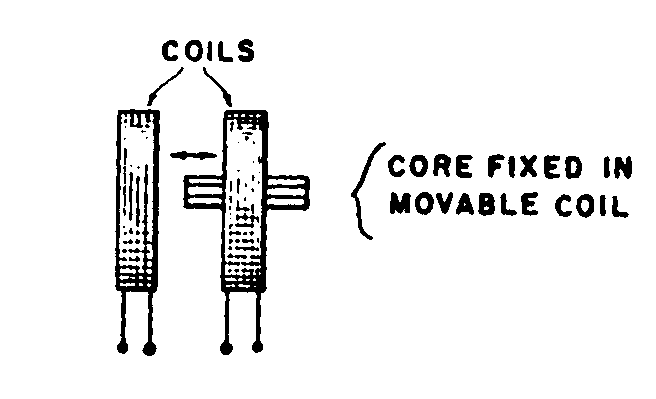
| SEE OR SEARCH THIS CLASS, SUBCLASS:
| 77, | for adjustable inductor devices having a coil and
a closed coil (e.g., short circuit
coil) or conductive member which are relatively movable
with respect to each other, the closed coil or conductive
member having a portion formed of magnetic material. |
| 212, | for inductor devices having core comprising plural
parts formed of unitary assemblages. |
|
| | |
![[List of Patents for class 336 subclass 120]](../ps.gif) 120 120 | Angularly movable: |
| | This subclass is indented under subclass 119. Subject matter wherein the fixed core and coil unit is movable
about an axis of rotation.
SEE OR SEARCH THIS CLASS, SUBCLASS:
| 122+, | for adjustable inductor devices having relatively
movable coils, the movable coil being movable about an
axis of rotation. |
SEE OR SEARCH CLASS:
| 74, | Machine Element or Mechanism,
subclasses 10+ and the subclasses specified in the Notes thereto
for mechanical mechanism for rotating a shaft including such mechanism
designed for use with an adjustable inductor device. Also
see the search notes to subclass 10 of Class 74 for the classification
of other rotary shaft moving mechanism and for the line between Class
336 and Class 74. |
|
| | |
![[List of Patents for class 336 subclass 121]](../ps.gif) 121 121 | Angularly and linearly movable coils: |
| | This subclass is indented under subclass 115. Subject matter wherein a coil is movable about an axis of
rotation and is also movable in a linear path or wherein one coil
is movable about an axis of rotation and another coil is movable in
a linear path.
| | (1)
Note. Illustrative examples are:
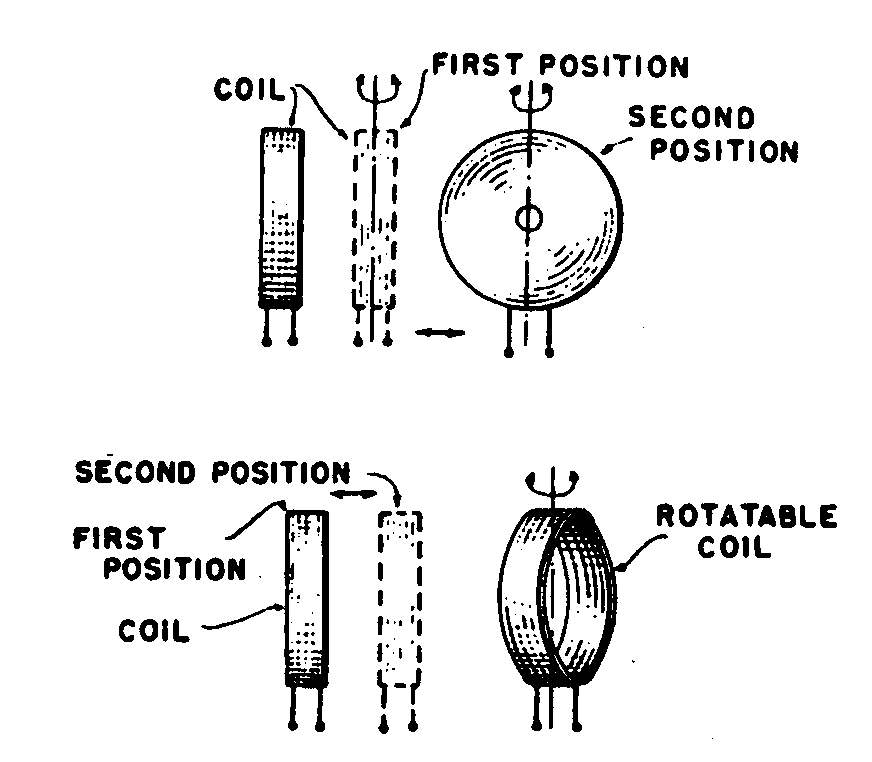
| SEE OR SEARCH THIS CLASS, SUBCLASS:
| 115, | for relatively movable coil inductor devices where
one coil is movable only in a linear path which is not parallel
to the coil axis of the other coil. |
| 122, | for relatively movable coil inductor devices where
a coil is movable only about an axis of rotation. |
| 129, | for relatively movable coil inductor devices where
one coil is movable only in a linear path which is parallel to and
usually coincident with the coil axis of another coil. |
|
| | |
![[List of Patents for class 336 subclass 122]](../ps.gif) 122 122 | Angularly movable: |
| | This subclass is indented under subclass 115. Subject matter wherein a coil is movable about an axis of
rotation.
| | (1)
Note. Illustrative examples are:
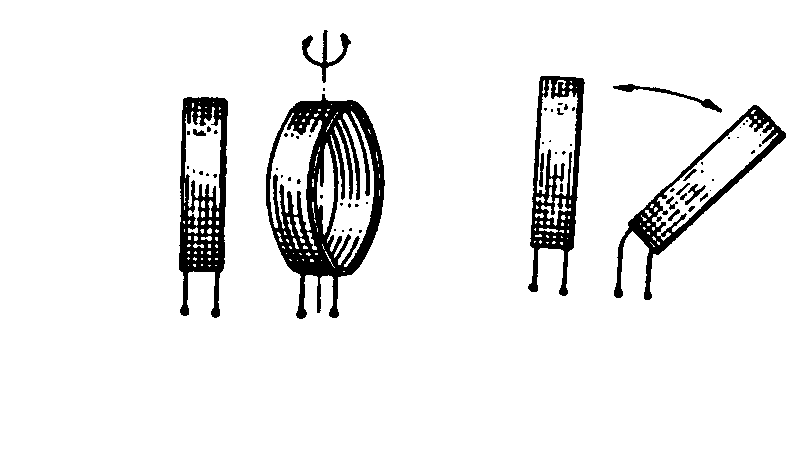
| SEE OR SEARCH THIS CLASS, SUBCLASS:
| 79, | for inductor devices which include a short-circuited
coil which is movable about an axis of rotation. |
| 120, | where the inductor device is provided with a core
for a movable coil, the core and coil being angularly movable as
a unit with respect to another coil. |
| 121, | where the coil is movable about an axis of rotation
and is also linearly movable or where a coil is movable about an
axis of rotation and another coil is linearly movable. |
SEE OR SEARCH CLASS:
| 74, | Machine Element or Mechanism,
subclasses 10+ and the subclasses specified in the Notes thereto
for mechanical mechanism for rotating a shaft including such mechanism
designed for use with an adjustable inductor device. Also
see the search notes to subclass 10 of Class 74 for the classification
of other rotary shaft moving mechanism and for the line between Class
336 and Class 74. |
|
| | |
![[List of Patents for class 336 subclass 125]](../ps.gif) 125 125 | About axis normal to other coil axis: |
| | This subclass is indented under subclass 122. Subject matter wherein the movable coil is movable about
an axis of rotation which passes through the center of the coil
and which is perpendicular to the axis of the other coil.
| | (1)
Note. An illustrative example is:
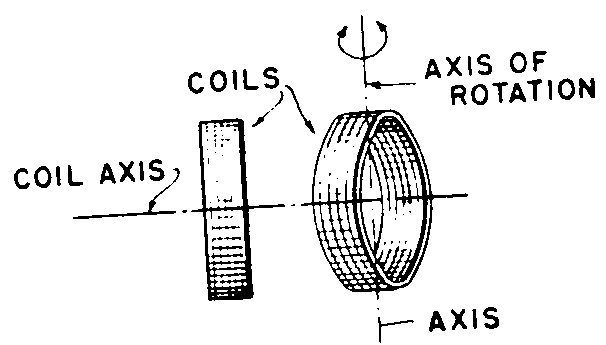
| SEE OR SEARCH THIS CLASS, SUBCLASS:
| 122, | where the movable coil is movable about an axis
of rotation which passes through the center of the coil, the
axis of rotation being transverse to, but not normal to, the
axis of the other coil. |
|
| | |
![[List of Patents for class 336 subclass 126]](../ps.gif) 126 126 | Plural coils movable with respect to a coil: |
| | This subclass is indented under subclass 125. Subject matter having three or more coils, at least
two of the coils being angularly movable with respect to each other
and with respect to another coil.
| | (1)
Note. The plural movable coils may be angularly
movable about the same or different axis of rotation. |
| | (2)
Note. Illustrative examples are:
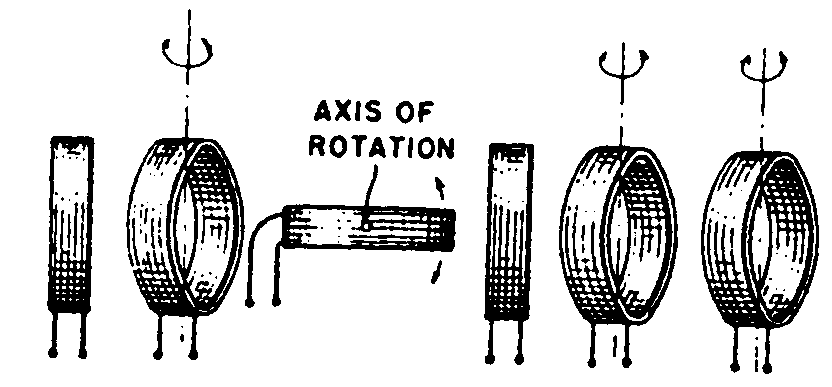
| SEE OR SEARCH THIS CLASS, SUBCLASS:
| 170+, | for inductors having three or more nonmovable windings. |
|
| | |
![[List of Patents for class 336 subclass 127]](../ps.gif) 127 127 | Similar spherical-shaped coils: |
| | This subclass is indented under subclass 125. Subject matter wherein the coils are similar and have a
spherical shape.
| | (1)
Note. The coil winding need not form a complete
sphere, but may only be a portion of a sphere. |
SEE OR SEARCH THIS CLASS, SUBCLASS:
| 230, | for the structure of spherical coils. |
|
| | |
![[List of Patents for class 336 subclass 128]](../ps.gif) 128 128 | Tubular stationary coil: |
| | This subclass is indented under subclass 125. Subject matter wherein the stationary coil has a tubular
shape.
| | (1)
Note. A tubular coil is a coil having a rectilinear
coil axis and having its windings extending along the coil axis
for a distance usually greater than the cross-sectional
dimensions (e.g., the diameter in
the case of round tubular coils) of the coil.
The cross-sectional shape or area usually is uniform along
the coil axis. The cross-sectional shape may
be circular, oval, square, polygonal
or the like. Coils of spherical, toroidal, or
pancake form, for example, are not considered
to be tubular coils for this subclass. |
| | (2)
Note. An illustrative example is:
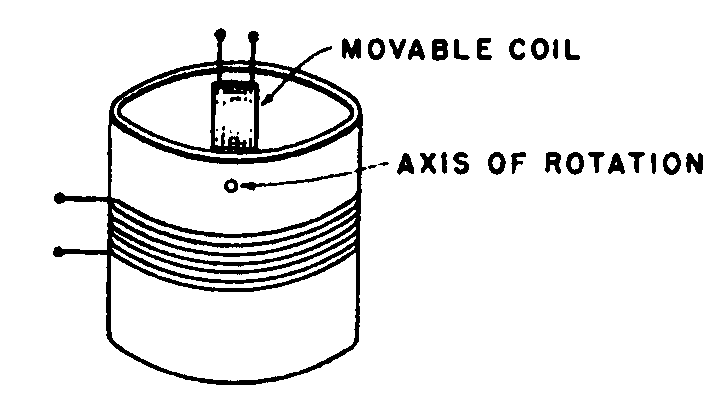
| SEE OR SEARCH THIS CLASS, SUBCLASS:
| 199+, | for the structure of coils on a form and especially
subclass 208 for coil forms. |
| 225+, | for the structure of coils having a special configuration. |
|
| | |
![[List of Patents for class 336 subclass 129]](../ps.gif) 129 129 | Movable along or parallel to other coil axis: |
| | This subclass is indented under subclass 115. Subject matter wherein the coil is movable along a linear
axis which is either coincident with or parallel to the coil axis
of the other coil.
| | (1)
Note. An illustrative example is:
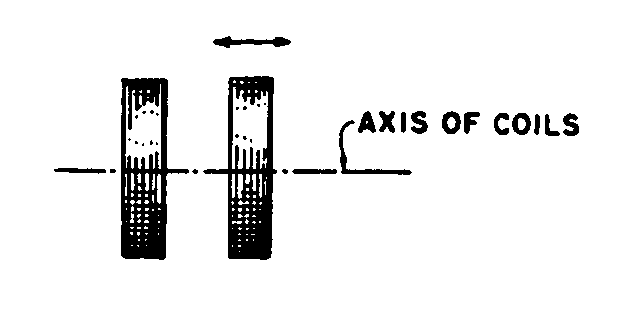
| SEE OR SEARCH THIS CLASS, SUBCLASS:
| 119, | for inductor devices having relatively movable coils, the
movable coil being provided with a core, the core and coil being
movable as a unit along an axis coincident with or parallel to the
axis of the other coil. |
| 121, | for inductor devices having relatively movable coils
wherein a coil is movable about an axis of rotation and is also
movable in a linear path or wherein one coil is movable about an axis
of rotation and another coil is movable in a linear path. |
|
| | |
![[List of Patents for class 336 subclass 130]](../ps.gif) 130 130 | RELATIVELY MOVABLE CORE AND COIL: |
| | This subclass is indented under the class definition. Adjustable inductor devices having a core and a coil which
are relatively movable with respect to each other so that the effective inductance
of the device may be varied.
| | (1)
Note. Illustrative examples are:
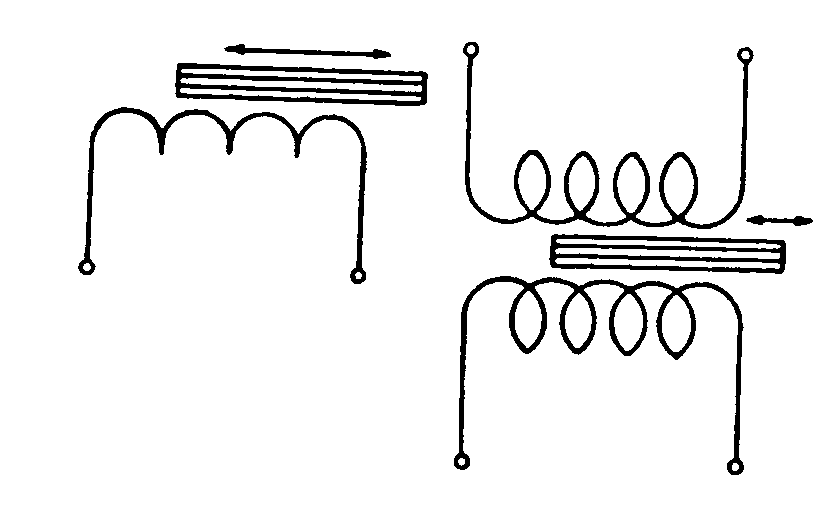
| SEE OR SEARCH THIS CLASS, SUBCLASS:
| 20, | where the inductor device has a deformable or distortable
coil or core. |
| 40, | where the movement between the coil and core is
due to the magnetic force existing between the coil and core. |
| 77, | where the core is a portion of a short-circuited
conductor or conductive member which is movable with respect to
the coil. |
| 117+, | where the inductor device includes two coils which
are movable relative to each other, the core being movable relative
to at least one of the coils. |
| 221, | for the structure of coil and core not elsewhere
provided for. |
SEE OR SEARCH CLASS:
| 74, | Machine Element or Mechanism,
subclasses 10+ and the subclasses specified in the Notes thereto
for mechanical mechanism for rotating a shaft including such mechanism
designed for use with an adjustable inductor device. Also
see the search notes to subclass 10 of Class 74 for the classification
of other rotary shaft moving mechanism and for the line between Class
336 and Class 74. |
| 323, | Electricity: Power Supply or Regulation
Systems,
subclasses 216 , 264, and 347 for miscellaneous
inductive reactor systems where the reactor includes a relatively
movable core and coil. |
| 330, | Amplifiers,
subclass 169 for amplifiers having transformer coupling including
means for adjusting inductive coupling of the transformer. |
| 334, | Tuners, appropriate subclasses for tuned networks for use
in wave energy apparatus and comprising inductance and capacitance
elements in circuit arrangement to form a resonant circuit and in
which structure is provided for adjusting one or both of these elements
for changing the mean resonant frequency of the circuit.
The adjustable inductance is usually of the movable core type. |
| 343, | Communications: Radio Wave Antennas,
subclass 748 for loop type antennas with a variable reactance
for tuning the antenna. |
|
| | |
![[List of Patents for class 336 subclass 131]](../ps.gif) 131 131 | Plural coils with plural cores: |
| | This subclass is indented under subclass 130. Subject matter which includes a plurality of coils, each
of the coils being provided with a core which is relatively movable
with respect to the coil with which it is associated.
| | (1)
Note. The several coils may or may not be in inductive
relation to each other. |
| | (2)
Note. Illustrative examples are:
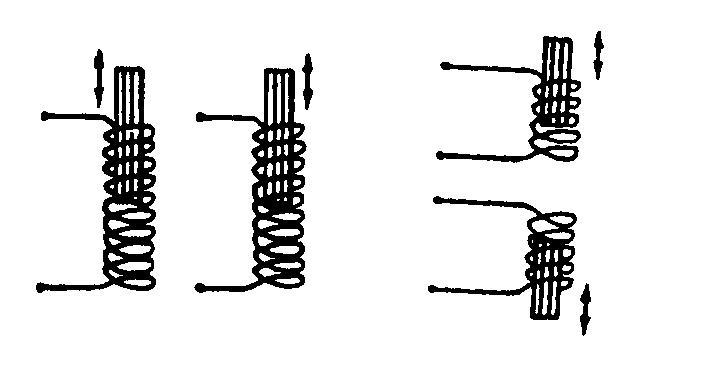
| SEE OR SEARCH THIS CLASS, SUBCLASS:
| 170+, | 182+, 188, and 220, for
the structure of nonadjustable inductive devices having plural windings (e.g., transformers). |
SEE OR SEARCH CLASS:
| 333, | Wave Transmission Lines and Networks,
subclasses 24+ for coupling networks including plural coils with plural
cores, and particularly subclasses 177+ for transformer
coupled wave filters with magnetic core inductance. |
| 334, | Tuners,
subclass 77 for tuners having variable inductors which are
gang operated. |
|
| | |
![[List of Patents for class 336 subclass 132]](../ps.gif) 132 132 | Plural relatively movable core parts: |
| | This subclass is indented under subclass 130. Subject matter wherein the core is formed of a plurality
of separate parts, one of the parts being movable relative
to the other part.
| | (1)
Note. The core part which is movable with respect
to the other core part may be movable with respect to the coil, or the
other core part may be movable with respect to the coil.
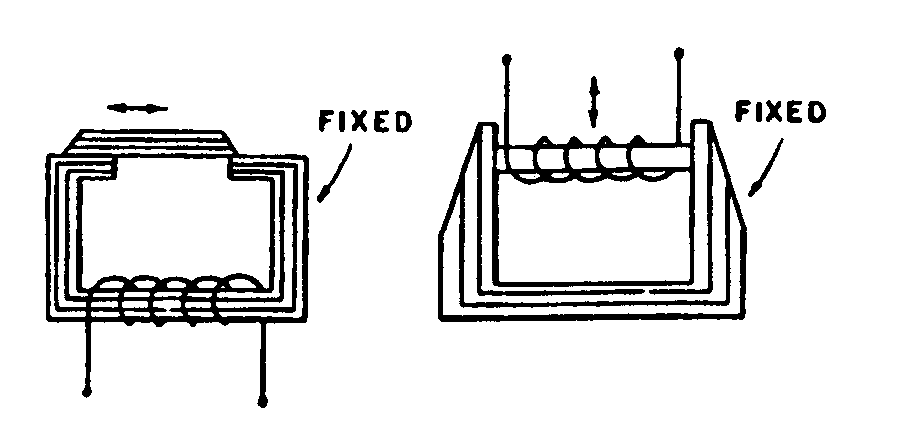
|
| | (2)
Note. Illustrative examples are: |
SEE OR SEARCH THIS CLASS, SUBCLASS:
| 221, | for inductive devices with plural part cores in
general. |
|
| | |
![[List of Patents for class 336 subclass 133]](../ps.gif) 133 133 | Adjustable magnetic shunt: |
| | This subclass is indented under subclass 132. Subject matter wherein the inductor device is provided with
at least two coils, one of the core portions forming a
continuous flux path inductively coupling the two coils, the
movable magnetic core portion being arranged between the two coils
so as to provide an adjustable shunt for shunting some of the magnetic
flux from the core portion forming the continuous flux path so that
one of the coils may be linked by a different amount of magnetic
flux than that which links the other coil.
| | (1)
Note. An illustrative example is:
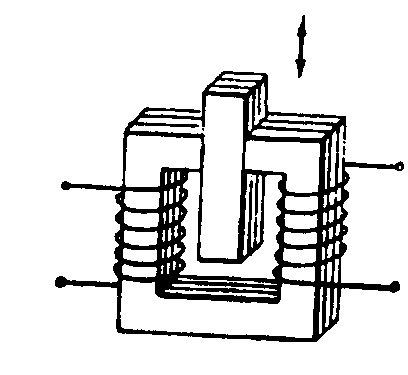
MOVABLE CORE SHUNTS FLUX GENERATED BY ONE COIL FROM OTHERCOIL. |
| | (2)
Note. The following illustrated types of inductor
devices, below, are not included in this subclass.
For the below excluded types of inductor devices, see subclasses 134+ where
there is an adjustable air gap and subclass 132 for such devices
without an adjustable air gap.
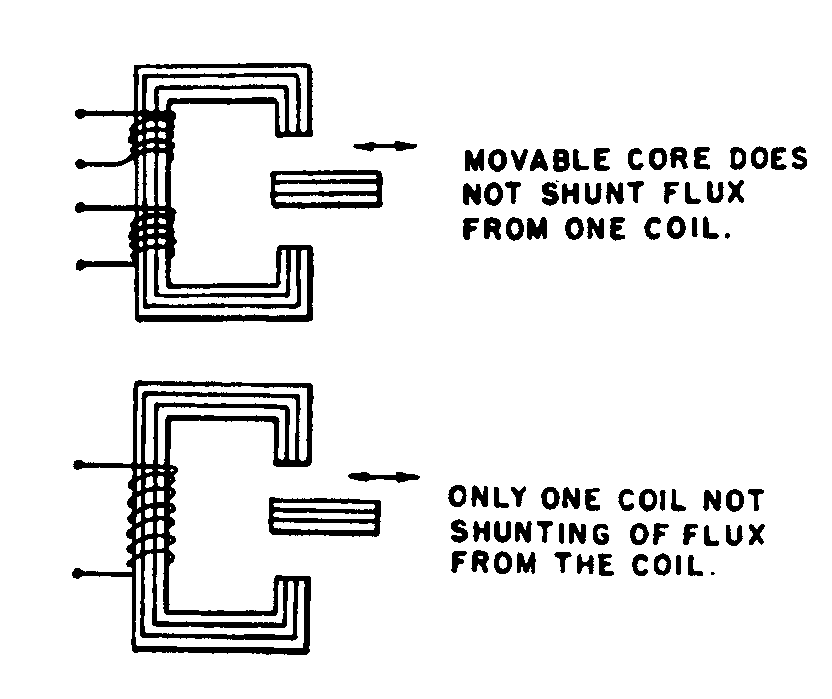
| SEE OR SEARCH THIS CLASS, SUBCLASS:
| 160, | for inductive regulators, without relatively
movable parts, having a magnetic shunt. |
|
| | |
![[List of Patents for class 336 subclass 134]](../ps.gif) 134 134 | Adjustable air gap: |
| | This subclass is indented under subclass 132. Subject matter wherein the movable core portion in at least
one of the positions to which it may be moved provides an air gap
between itself and the other core portion.
| | (1)
Note. The movable core portion may provide an air
gap between itself and the other core portion in all of the positions to
which it may be moved. |
| | (2)
Note. Illustrative examples are:
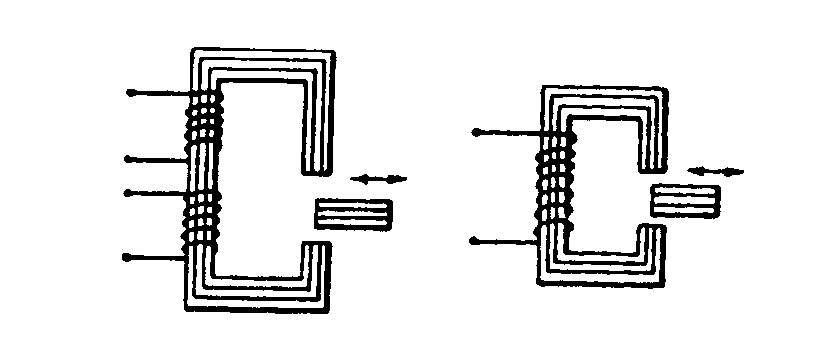
| SEE OR SEARCH THIS CLASS, SUBCLASS:
| 155+, | for inductive regulators, with no relatively
moving parts having an air gap. |
| 178, | for inductive devices with a closed core interrupted
by an air gap, generally. |
|
| | |
![[List of Patents for class 336 subclass 135]](../ps.gif) 135 135 | Angularly movable: |
| | This subclass is indented under subclass 134. Subject matter wherein the movable core portion is movable
about an axis of rotation.
| | (1)
Note. An illustrative example is:
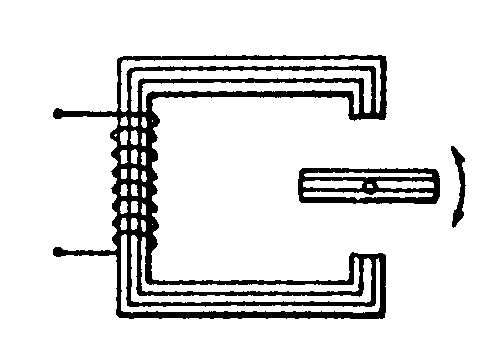
| SEE OR SEARCH THIS CLASS, SUBCLASS:
| 120, | for inductor devices having a core and coil which
are movable as a unit about an axis of rotation to effect movement between
the core and coil unit and another coil. |
SEE OR SEARCH CLASS:
| 74, | Machine Element or Mechanism,
subclasses 10+ and the subclasses specified in the notes thereto
for mechanical mechanism for rotating a shaft including such mechanism
designed for use with an adjustable inductor device. Also
see the search notes to subclass 10 of Class 74 for the classification
of other rotary shaft moving mechanism and for the line between Class
336 and Class 74. |
|
| | |
![[List of Patents for class 336 subclass 136]](../ps.gif) 136 136 | Telescoping magnetic body and coil: |
| | This subclass is indented under subclass 130. Subject matter in which the core and a coil are relatively
movable in the direction of the axis of the coil and in variable
amount of overlapping relation.
| | (1)
Note. In the devices in this subclass, the core
may be "telescoped" within the coil, or the coil may be
telescoped within the core. |
| | (2)
Note. An illustrative example is:
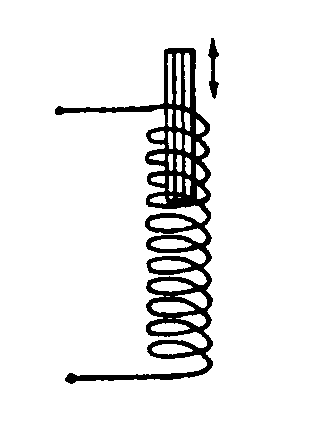
| |
| | |
![[List of Patents for class 336 subclass 137]](../ps.gif) 137 137 | WITH MEANS TO CHANGE COIL LENGTH OR CONNECTIONS: |
| | This subclass is indented under the class definition. Inductor devices wherein a coil is provided with means (a) to
change the physical length of the coil which is effective as an inductive
component, or (b) to add or cut out turns
or coils or to substitute a coil section or component of different
characteristics or position for a coil or (c) to
change the direction of current flow through at least a portion
of the coil conductor.
| | (1)
Note. Illustrative examples are:
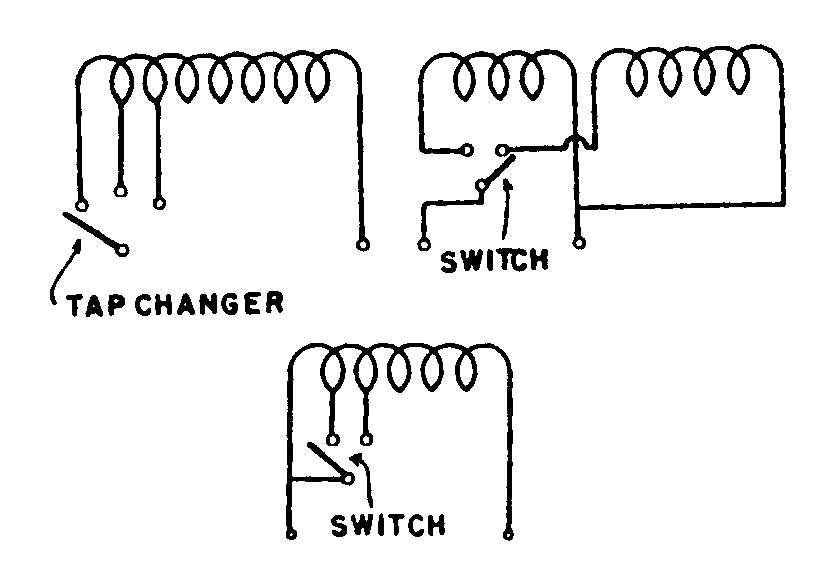
| SEE OR SEARCH THIS CLASS, SUBCLASS:
| 15, | where the effective number of turns of the coil
is varied by winding or unwinding the coil conductor. |
| 116, | where one of the coils is also movable with respect
to another of the coils. |
SEE OR SEARCH CLASS:
| 74, | Machine Element or Mechanism,
subclasses 10+ and the subclasses specified in the notes thereto
for mechanical mechanism for rotating a shaft including such mechanism
designed for use with an adjustable inductor device. Also
see the search notes to subclass 10 of Class 74 for the classification
of other rotary shaft moving mechanism and for the line between Class
336 and Class 74. |
| 323, | Electricity: Power Supply or Regulation
Systems,
subclasses 255 and 340 for transformer systems with tapped windings. |
| 334, | Tuners,
subclasses 47+ for tuners of the switch type and especially subclasses
56+ for a switch type tuner in which the inductor only
is modified or substituted by switching. |
| 343, | Communications: Radio Wave Antennas,
subclass 748 for loop type antennas with a variable reactance
for tuning the antenna; and subclass 868 for loop type
antennas having means for adjusting the coil length. |
|
| | |
![[List of Patents for class 336 subclass 138]](../ps.gif) 138 138 | Parallel-spaced conductors or coils bridged by
movable connector: |
| | This subclass is indented under subclass 137. Subject matter comprising conductors (which may
be coils) lying in side by side relation, or having
a common axis, and bridged by a conducting member, which
member is movable along the conductors to include equivalent portions
of both conductors in each of its various positions.
| | (1)
Note. Illustrative examples are:

| SEE OR SEARCH THIS CLASS, SUBCLASS:
| 184, | for nonadjustable plural coil winding inductive
devices where coils have different axes or are mounted on different
core legs. |
SEE OR SEARCH CLASS:
| 333, | Wave Transmission Lines and Networks,
subclasses 219+ for resonators of the distributed electrical parameter
type, which structurally may be parallel transmission lines joined
by a movable shorting bar, and subclasses 245+ for
similar distributed electrical parameter lines which are operated
at other than their resonant frequency thereby effecting an inductive
or capacitive reactance at the terminals thereof. |
|
| | |
![[List of Patents for class 336 subclass 139]](../ps.gif) 139 139 | Contactor following helical conductor: |
| | This subclass is indented under subclass 137. Subject matter wherein the coil is formed of a helically
or spirally wound conductor, a movable contactor being
provided to make contact with the coil, the conductor contact
being movable along the length of the helical or spiral conductor
and maintaining a continuous contact with the conductor during such
movement so that the conductor contact of the contactor travels
in the helical or spiral path defined by the conductor and so that
in the range of adjustment of the contactor the change in effective impedance
is continuously changing (as distinguished from a step-by-step
change).
| | (1)
Note. If the device is also provided with means
so that the contact can be moved out of contact with the conductor
to make a large discontinuous change in inductance, this
will not exclude the patent from this subclass. |
| | (2)
Note. An illustrative example is:
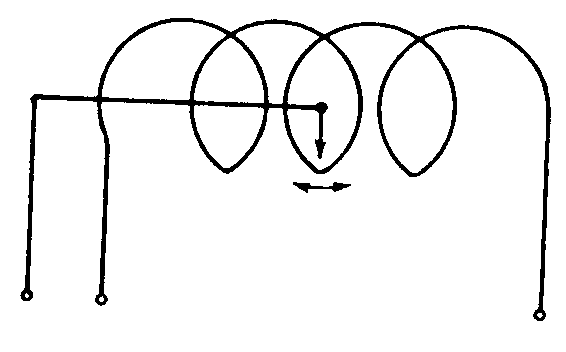
| SEE OR SEARCH CLASS:
| 74, | Machine Element or Mechanism,
subclasses 10+ and the subclasses specified in the Notes thereto
for mechanical mechanism for rotating a shaft including such mechanism
designed for use with an adjustable inductor device. Also
see the search notes to subclass 10 of Class 74 for the classification
of other rotary shaft moving mechanism and for the line between Class
336 and Class 74. |
| 334, | Tuners,
subclasses 72+ for tuners having a variable inductor of the type
in which a movable contact is adjusted over the length of the inductor. |
| 338, | Electrical Resistors,
subclasses 143+ for mechanically variable electrical resistors
in which the contact terminal moves along the turns of the helical resistance
element. |
|
| | |
![[List of Patents for class 336 subclass 140]](../ps.gif) 140 140 | Plural movable contactors: |
| | This subclass is indented under subclass 139. Subject matter having a plurality of contactors for contacting
the helical or spiral conductor of the coil, or having
a plurality of spiral or helical coils with a contactor, which
follows and makes continuous contact with the conductor for each
coil, the plural contactors being capable of being moved
separately or differentially with respect to one another.
| | (1)
Note. Illustrative examples are:
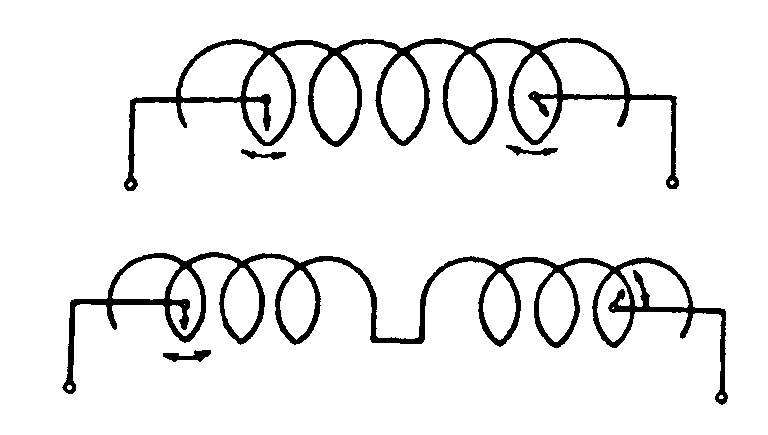
| |
| | |
![[List of Patents for class 336 subclass 141]](../ps.gif) 141 141 | With contactor guide track: |
| | This subclass is indented under subclass 139. Subject matter having the movable contactor movably mounted
on and/or guided by an elongated bar or track member, the
bar or track member extending parallel to or being co-incident
with the coil axis.
| | (1)
Note. an illustrative example is:
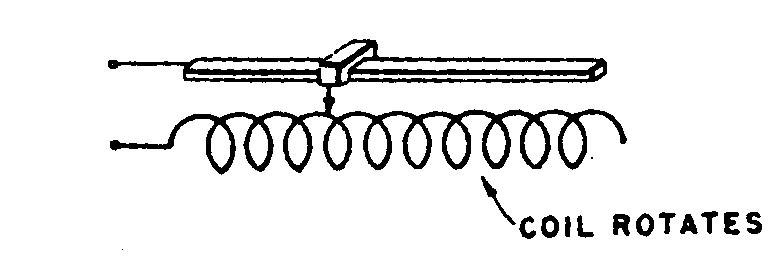
| |
| | |
![[List of Patents for class 336 subclass 142]](../ps.gif) 142 142 | Coil connections changed by moving coil (e.g., coil
substitution): |
| | This subclass is indented under subclass 137. Subject matter wherein the inductor device includes a plurality
of coils with separate electrical contacts or a coil having contact
means (e.g., taps) for
making contact with the coil at different places and a supporting
structure for the coils or coil, the supporting structure
being provided with electrical contacts for making contact with
less than all of the coils or with means for making contact at different
places on the coil, the plurality of coils or the tapped
coil being movably supported with respect to the supporting structure, and
the coils or coil and supporting structure being designed so that
as the coils or coil is moved, different coils or coil contacts
can be moved into circuit making relation with the contacts in the
supporting structure.
| | (1)
Note. In the devices in this and the indented subclass, the
structure is designed for changing coils in the circuit or for varying
the amount of coil conductor in the circuit. The distinguishing feature
is that the coil change or conductor length is changed by moving
the coils or coil, rather than by having the coils or coil
stationary and moving a contactor (e.g., switch
into contact with the coil terminals or along the coil. |
| | (2)
Note. Where the device has a plurality of coils, the
coils must be arranged so as not to be movable with respect to each other
when in circuit making relation with the contacts so as to vary
the effective inductance of the device. If the effective
inductance of the device can be changed by moving the coils relative
to each other, see subclasses 115+ above. |
| | (3)
Note. An illustrative example is:
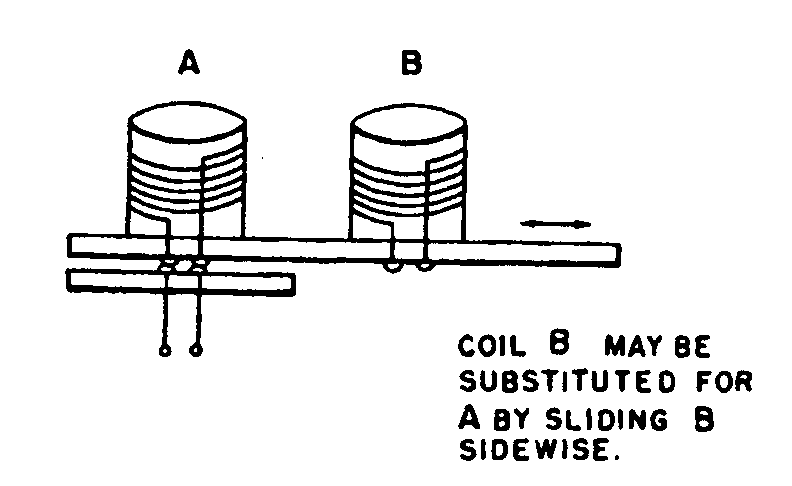
| SEE OR SEARCH THIS CLASS, SUBCLASS:
| 15, | for inductor devices where the length of the coil
conductor is changed by winding or unwinding the conductor on the
coil. |
| 115+, | for inductor devices which are provided with relatively
movable coils for changing the effective inductance of the device. |
| 149, | for inductor devices where the effective length
of the coil conductor is changed by sliding a contactor along the
coil winding. |
| 150, | for inductor devices wherein the inductor is provided
with taps and a tap changing switch is provided. |
SEE OR SEARCH CLASS:
| 323, | Electricity: Power Supply or Regulation
Systems,
subclasses 255 , 340, and 354 for miscellaneous
impedance systems wherein a plurality of impedances (e.g., inductor
devices) are provided and means are provided for selecting
the impedance which may be included in the circuit. |
| 331, | Oscillators,
subclass 179 for oscillator systems wherein the generated oscillation
frequency may be changed in discrete steps by inductance coil substitution. |
| 334, | Tuners,
subclasses 47+ for switch type tuners. |
|
| | |
![[List of Patents for class 336 subclass 143]](../ps.gif) 143 143 | With connection reversing means: |
| | This subclass is indented under subclass 137. Subject matter wherein the inductor device is provided with
a plurality of coil sections or a coil having means (e.g., taps) for
making contact with the coil conductor at different places, the
inductor device including means (e.g., a switch) to
reverse the inductive effect of one coil section or part with respect
to another coil section or part, and to thereby change
the effective inductance of the inductor device.
| | (1)
Note. An illustrative example is:
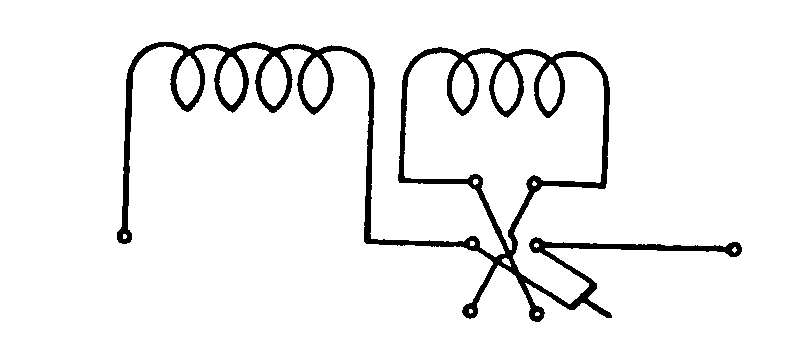
| |
| | |
![[List of Patents for class 336 subclass 144]](../ps.gif) 144 144 | With variable number of short-circuited turns: |
| | This subclass is indented under subclass 137. Subject matter having adjustable means to selectively form
a closed circuit with one or more turns of the coil.
| | (1)
Note. An illustrative example is:
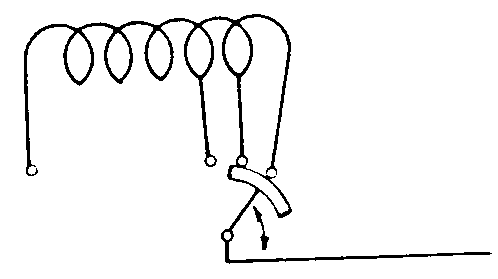
| SEE OR SEARCH THIS CLASS, SUBCLASS:
| 15, | for inductor devices in which the number of effective
turns of a coil is changed by winding or unwinding the coil conductors
upon a short circuiting member. |
| 73+, | for inductor devices with closed coil, particularly
indented subclasses 75+ where the closed coil (e.g., the
short circuited turns) is movable relative to the coil. |
| 138, | for similar adjustable inductor devices having a
plurality of parallel spaced coil members, a bridging member being
movable along the coils to short circuit equivalent portions of
both coils. |
|
| | |
![[List of Patents for class 336 subclass 145]](../ps.gif) 145 145 | Plural coils (e.g., transformers): |
| | This subclass is indented under subclass 137. Subject matter wherein the inductor device is provided with
a plurality of coils in mutually inductive relation.
| | (1)
Note. See the Notes to the class definition for
the other classes which provide for plural coil inductive reactors
and transformers. |
SEE OR SEARCH THIS CLASS, SUBCLASS:
| 116, | where the coils are also movable relative to each
other. |
| 138, | where the coils are spaced in parallel relationship
and a movable contactor contacts both coils to include an equivalent
portion of both coils in circuit. |
| 170+, | 182+, 188, and 220, for
the structure of nonadjustable inductive devices having plural windings (e.g., transformers). |
SEE OR SEARCH CLASS:
| 330, | Amplifiers,
subclass 169 for amplifiers having transformer coupling including
means to adjust the inductive coupling. |
|
| | |
![[List of Patents for class 336 subclass 146]](../ps.gif) 146 146 | Inductance change in plural coils: |
| | This subclass is indented under subclass 145. Subject matter having means for changing the coil length
and/or connections of a plurality of the coils.
SEE OR SEARCH THIS CLASS, SUBCLASS:
| 138, | where the coils are spaced in parallel relationship
and a movable contactor contacts both coils to include an equivalent
portion of both coils in circuit. |
| 143, | where one of the coils is provided with connection
reversing means. |
| 144, | where one of the coils is provided with means to
vary the number of short-circuited turns. |
|
| | |
![[List of Patents for class 336 subclass 147]](../ps.gif) 147 147 | Plural coils or coil portions connected in parallel or
in series and parallel: |
| | This subclass is indented under subclass 145. Subject matter in which there are a plurality of coils or
coil portions which are connected in parallel relation with respect
to each other, means being provided to change the coil
length or connections of the parallel connected coils or coil portions.
| | (1)
Note. The change may be to change the coils or coil
portions from parallel relation to series relation. |
| | (2)
Note. The device may also include coils or coil
portions connected in series with the parallel connected coils or
coil portions. |
| | (3)
Note. Illustrative examples are:
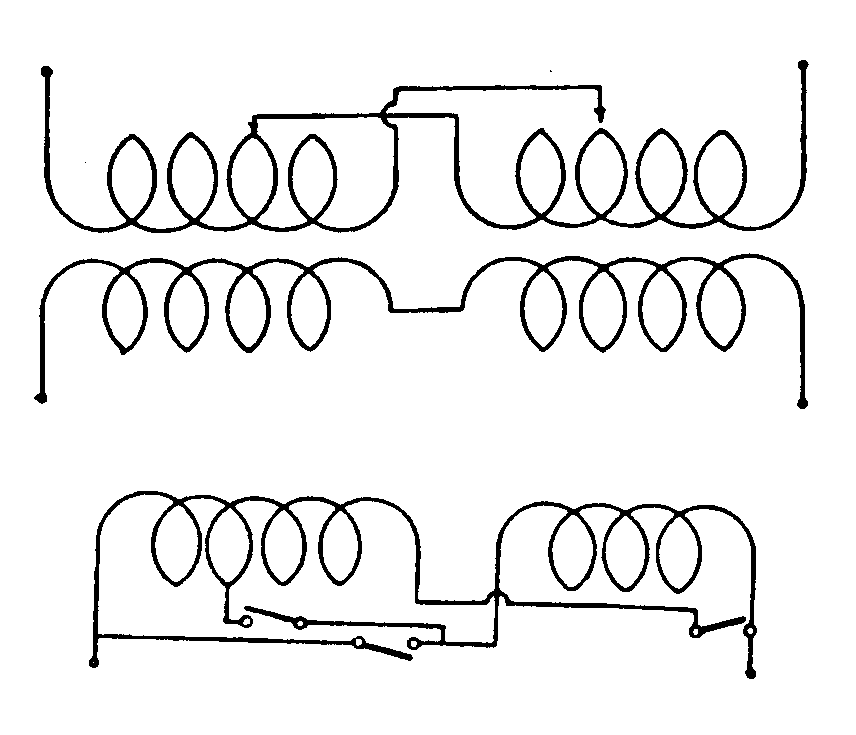
| SEE OR SEARCH CLASS:
| 323, | Electricity: Power Supply or Regulation
Systems,
subclass 346 for miscellaneous transformer systems where the
transformer is provided with windings which may be selectively connected
wither in series or parallel. |
|
| | |
![[List of Patents for class 336 subclass 148]](../ps.gif) 148 148 | Autotransformers: |
| | This subclass is indented under subclass 145. Subject matter in which a coil portion forms at least a
part of a plurality of coils.
| | (1)
Note. Included in this subclass are auto-transformers. |
| | (2)
Note. An illustrative example is:

| |
| | |
![[List of Patents for class 336 subclass 149]](../ps.gif) 149 149 | Contactor slidable on coil winding: |
| | This subclass is indented under subclass 137. Subject matter comprising a coil and a contactor which travels
on and across the successive conductor turns of the coil, making
direct contact with the coil conductor.
SEE OR SEARCH THIS CLASS, SUBCLASS:
| 138, | for inductor devices having a plurality of parallel
spaced coils, a movable contractor being provided to contact both
coils to include an equivalent portion of both coils in circuit. |
| 139, | where the coil is a helical coil or spiral and the
contactor follows the conductor so as to make continuous contact with
the coil conductor. |
| 150, | for inductor devices with a tap changing switch. |
|
| | |
![[List of Patents for class 336 subclass 150]](../ps.gif) 150 150 | Series change (e.g., tap
change): |
| | This subclass is indented under subclass 137. Subject matter wherein the inductor coil is provided with
a plurality of contact means so that the change in inductance can
be effected by adding or subtracting turns or coil portions in series
to the portion of the coil connected in the circuit.
| | (1)
Note. An illustrative example is:
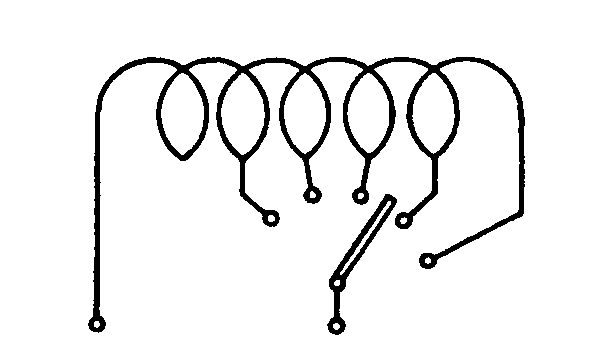
| SEE OR SEARCH THIS CLASS, SUBCLASS:
| 139, | where the coil is a helical coil or spiral, and
the contactor follows the conductor so as to make continuous-contact
with the coil conductor. |
| 142, | where the connections to the coil are changed by
moving the coil (i.e., movable
coil and fixed contacts). |
| 149, | where a contactor slides along the coil conductor, making
direct contact with the coil conductor. |
SEE OR SEARCH CLASS:
| 307, | Electrical Transmission or Interconnection Systems,
subclass 50 for tap changing means associated with a multi-cell
battery which floats across another source of electrical energy. |
| 310, | Electrical Generator or Motor Structure,
subclass 189 for tapped field or excitation windings of dynamoelectric machines, and
subclass 200 for tapped armature or primary windings of dynamoelectric
machines. |
| 323, | Electricity: Power Supply or Regulation
Systems,
subclasses 255 and 340 for transformer systems with tapped windings. |
|
| | |
![[List of Patents for class 336 subclass 155]](../ps.gif) 155 155 | INDUCTIVE REGULATORS WITH NO RELATIVELY MOVING PARTS: |
| | This subclass is indented under the class definition. Inductor devices comprising an inductor with no relatively
movable parts wherein (a) the inductance thereof
is variable in response to current flow therethrough or (b) a
magnetic shunt or air gap is provided to cause a high leakage reactance
between at least two magnetically coupled windings, or (c) the
core saturation of the device is controlled by an auxiliary bias
means such as a DC control winding.
| | (1)
Note. A disclosure in the specification of any of
the above enumerated subject matter is sufficient to cause classification in
this or indented subclasses of any patent that would otherwise be
classified in the succeeding subclasses of this class. |
SEE OR SEARCH THIS CLASS, SUBCLASS:
| 110, | for inductor devices having a magnetic bias produced
by a permanent magnet. |
| 178, | for closed type cores with their magnetic path interrupted
by an air gap. |
SEE OR SEARCH CLASS:
| 310, | Electrical Generator or Motor Structure, appropriate subclasses, particularly
subclasses 179+ for analogous generator or motor structure, and especially
indented subclass 193 for generator or motor structure having nonmagnetic
inserts or air gaps. |
| 315, | Electric Lamp and Discharge Devices: Systems, particularly
subclass 282 for discharge device with a regulating transformer
in the supply circuit. |
| 318, | Electricity: Motive Power Systems,
subclass 513 for electric motor armature circuit control systems
utilizing a saturable reactor. |
| 322, | Electricity: Single Generator Systems, particularly
subclass 57 for dynamoelectric generators with means to saturate
a portion of the generator magnetic structure. |
| 323, | Electricity: Power Supply or Regulation
Systems,
subclass 56 for current and/or voltage magnitude control
systems where the control means is a saturable transformer, and
subclass 89 where the control means is a saturable reactor. |
| 330, | Amplifiers,
subclass 8 for magnetic amplifiers (having a saturable
reactor active element). |
| 331, | Oscillators,
subclass 181 for oscillator systems having an oscillation frequency
determining element comprising a variable inductance, which inductance
may be of the saturable core type. |
| 332, | Modulators, particularly
subclass 173 for amplitude modulators which may utilize saturable
inductors. |
|
| | |
![[List of Patents for class 336 subclass 160]](../ps.gif) 160 160 | With magnetic shunt to increase leakage reactance: |
| | This subclass is indented under subclass 155. Subject matter comprising two or more magnetically coupled
windings or coils mounted on a core having at least one auxiliary
magnetic path which serves to divert a portion of the flux emanating
from one or more of the windings or coils so as to prevent the said
flux portion from linking one or more of the other windings or coils.
SEE OR SEARCH CLASS:
| 310, | Electrical Generator or Motor Structure, particularly
subclass 190 for rotary dynamoelectric machine field structure
having magnetic shunts for shifting the field flux. |
| 322, | Electricity: Single Generator Systems, particularly
subclass 50 for dynamoelectric generator control means including
a magnetic shunt for the field flux. |
|
| | |
![[List of Patents for class 336 subclass 165]](../ps.gif) 165 165 | Air gap in magnetic shunt: |
| | This subclass is indented under subclass 160. Subject matter having an air gap in the auxiliary magnetic
path.
| | (1)
Note. The air gap may interrupt the auxiliary magnetic
path partially or completely, and may constitute a nonmagnetic
spacer or filler material. |
SEE OR SEARCH THIS CLASS, SUBCLASS:
| 134+, | for relatively movable core and coil inductor apparatus
having an adjustable air gap. |
| 178, | for closed type cores interrupted by an air gap
wherein the purpose of the air gap is not disclosed as subject matter for
subclasses 155+. |
SEE OR SEARCH CLASS:
| 310, | Electrical Generator or Motor Structure,
subclass 192 for generator or motor winding and core structure
having nonmagnetic inserts or gaps. |
|
| | |
![[List of Patents for class 336 subclass 170]](../ps.gif) 170 170 | THREE OR MORE WINDINGS: |
| | This subclass is indented under the class definition. Inductor devices comprising three or more windings, not
elsewhere provided for.
SEE OR SEARCH THIS CLASS, SUBCLASS:
| 5+, | for inductors with polyphase windings which may
have three or more windings. |
| 73+, | for inductors which may have two or more windings
and in addition a closed or short circuited coil or winding. |
| 115+, | for inductive devices with relatively movable coils
which may have three or more windings. |
| 130+, | for inductive devices having relatively movable
core and coil, which may have three or more windings. See
particularly indented subclass 131 for inductors including plural
cores and plural coils or windings. |
| 137+, | for inductive devices with means to change coil
lengths or connections which may have three or more windings. See
particularly indented subclasses 145+ for transformers
with plural windings or coils. |
| 155+, | for inductive regulators which have plural windings. |
| 182+, | for inductor devices with two windings at least
one of which is a plural coil winding. |
| 188, | for inductor devices having two windings with mutually
crossed turns. |
| 214+, | for inductive devices having multiple magnetic paths
which includes subject matter where such multiple magnetic paths
have or are adapted to have three or more windings distributed thereon. |
| 220, | for inductive devices having two windings, not
elsewhere provided for. |
SEE OR SEARCH CLASS:
| 310, | Electrical Generator or Motor Structure,
subclasses 184+ and 198+ for plural field windings and
plural armature or primary windings, respectively, for
rotary dynamoelectric machines. |
| 323, | Electricity: Power Supply or Regulation
Systems, particularly
subclasses 48+ for transformer systems with plural primary and/or
secondary windings, and subclasses 83+ for inductor systems
in general having plural windings. |
| 330, | Amplifiers,
subclasses 165+ , 188+, and 195+ for
amplifier systems having transformer coupling, particularly subclasses
171, 190, and 197 where transformer structure
is involved. |
| 335, | Electricity: Magnetically Operated Switches, Magnets, and
Electromagnets,
subclass 291 for electromagnets of the lifting, traction
and related types. |
| 343, | Communications: Radio Wave Antennas,
subclass 867 for plural loop type antennas. |
|
| | |
![[List of Patents for class 336 subclass 171]](../ps.gif) 171 171 | Noninductively related windings: |
| | This subclass is indented under subclass 170. Subject matter wherein the inductor device and its windings
are so constructed, positioned, arranged, and/or
connected that at least one of the windings is electromagnetically
decoupled with respect to the other windings.
SEE OR SEARCH THIS CLASS, SUBCLASS:
| 184, | for inductor devices having a winding with plural
coils, so constructed or arranged that the axis of at least
one coil is not coincident with the axes of the other coils. |
SEE OR SEARCH CLASS:
| 333, | Wave Transmission Lines and Networks, for wave transmission systems utilizing hybrid or
three winding transformers wherein at least one winding is magnetically
decoupled from the other windings. |
|
| | |
![[List of Patents for class 336 subclass 172]](../ps.gif) 172 172 | COIL TURN LINKS PORTION OF CORE ACROSS SECTION (E.G., FRACTIONAL TURN): |
| | This subclass is indented under the class definition. Inductor devices wherein the inductor comprises a coil or
winding having a turn or series of full turns which embrace the
full transverse section of the core and which includes, in
addition, one or more shorter turns which embrace only
a portion of the transverse section of the core. The core
flux path may be a single solid or laminated core leg with a small
piece thereof cut out to permit the "partial turns" to enclose a
smaller cross-section of the core flux path than is enclosed
by the full turns; or the core flux path may consist of
two or more parallel core legs of a single core or of two independently
constructed cores with the full turns enclosing the core legs in
cross-section, and the "partial turns" enclosing
in like manner fewer core legs than those enclosed by the full turns.
SEE OR SEARCH THIS CLASS, SUBCLASS:
| 73, | for closed or short-circuited turns enclosing
less cross-section of a flux path than those enclosed by
full turns of the inductor. |
| 133, | and 160+, for inductor devices
of the adjustable or regulating type having core structures including
a separate and distinct shunt magnetic path structure. |
|
| | |
![[List of Patents for class 336 subclass 173]](../ps.gif) 173 173 | INTERLINKED COILS OR WINDINGS (E.G., CURRENT
TRANSFORMER): |
| | This subclass is indented under the class definition. Inductor devices in which two or more coils or windings
of the device, as defined by the limiting or boundary surfaces
of their turns, cross each other so as to be interlinking.
SEE OR SEARCH THIS CLASS, SUBCLASS:
| 73+, | for closed or short-circuited coils which
may interlink with another coil or winding. |
| 82, | for inductors where a coil forms the casing thereof
and which may involve interlinked coils. |
| 175+, | for a core surrounding a linear conductor. |
| 180+, | for inductors with plural coil windings where single
turns of different coils may cross at one or more points. |
| 187, | for coils formed of plural parallel conductors which
are transposed. |
| 188, | for inductors in which the individual turns of two
or more coils or windings mutually cross each other . |
| 189+, | for single coils with crossed turns. |
| 195, | for inductors where one coil has a conductor which
receives another coil in a groove, recess, or
hollow space of such conductor. |
SEE OR SEARCH CLASS:
| 310, | Electrical Generator or Motor Structure,
subclasses 179+ for winding and core structures for rotary dynamoelectric
machines, appropriate subclasses of which may have interlinking
coils. |
| 324, | Electricity: Measuring and Testing,
subclass 127 for means for measuring, testing, or
sensing electricity, per se, having a transformer
coupling which may be of the type having interlinking coils or windings (e.g., current
or potential instrument transformers). |
|
| | |
![[List of Patents for class 336 subclass 174]](../ps.gif) 174 174 | Coil surrounding linear conductor: |
| | This subclass is indented under subclass 173. Subject matter wherein one of the interlinking coils is
a linear conductor and is surrounded by another coil.
| | (1)
Note. The linear conductor referred to above is
regarded as a segment of a circular coil of infinite radius thereby bringing
such subject matter within the definition of subclass 173 under
which this subclass is indented. |
SEE OR SEARCH THIS CLASS, SUBCLASS:
| 175+, | for linear conductors surrounded by magnetic cores. |
|
| | |
![[List of Patents for class 336 subclass 175]](../ps.gif) 175 175 | CORE SURROUNDING LINEAR CONDUCTOR: |
| | This subclass is indented under the class definition. Inductor devices in which a linear conductor comprising
the inductor winding or coil is surrounded by a magnetic core.
| | (1)
Note. Where both a coil and core surround a linear
conductor the subject matter is classified above in subclass 174
of this class. |
SEE OR SEARCH THIS CLASS, SUBCLASS:
| 173+, | for inductors with interlinked coils or windings (e.g., current
transformers). |
| 221, | for the combination of a core and coil in general
and not elsewhere classified. |
| 233, | for magnetic core structure in general not elsewhere
classified. |
SEE OR SEARCH CLASS:
| 324, | Electricity: Measuring and Testing,
subclass 127 for means for measuring, testing, or
sensing electricity, per se, having transformer
coupling means, some of which are current transformers
having a winding or coil comprised of a linear conductor. |
|
| | |
![[List of Patents for class 336 subclass 176]](../ps.gif) 176 176 | Hinged core: |
| | This subclass is indented under subclass 175. Subject matter in which the magnetic core surrounding the
linear conductor comprises plural parts which are hinged at some
point, usually to facilitate placing the core about the
conductor.
SEE OR SEARCH THIS CLASS, SUBCLASS:
| 132+, | for inductors with relatively movable core parts
for varying the inductance of the inductor. |
| 210, | for inductors with core clamps, wedges
or fasteners. |
| 212, | for inductor cores formed of plural parts. |
| 216+, | for joint structure of cores. |
|
| | |
![[List of Patents for class 336 subclass 177]](../ps.gif) 177 177 | WITH COIL OR MAGNETIC MATERIAL: |
| | This subclass is indented under the class definition. Inductor devices wherein the conductor of a coil of the
device is constructed in whole or in part of magnetic material.
SEE OR SEARCH THIS CLASS, SUBCLASS:
| 213, | for cores formed of wound strip or filamentary material. |
| 222+, | for windings of inductors generally, including
windings whose conductors are constructed of a special material. |
| 233+, | for magnetic cores of inductors generally, particularly
for cores of special materials. |
SEE OR SEARCH CLASS:
| 252, | Compositions,
subclasses 62.51+ for the compositions of magnetic materials generally. |
| 428, | Stock Material or Miscellaneous Articles,
subclasses 544+ for stock material or intermediate articles which
are all metal or have adjacent metal components, particularly
subclasses 615+ for metallic composites defined in terms
of the composition of their components, and subclass 928
for metallic stock having magnetic properties. |
|
| | |
![[List of Patents for class 336 subclass 178]](../ps.gif) 178 178 | WITH CLOSED CORE INTERRUPTED BY AN AIR GAP: |
| | This subclass is indented under the class definition. Inductor devices comprising a structure having a closed
core which is partially or completely interrupted at one or more
points by nonmagnetic separators or air gaps.
| | (1)
Note. If the purpose of the nonmagnetic separator
or gap is for the purpose of causing a leakage reactance which is usually
a function of the load current of the device, the patent
is not classified herein but rather in subclasses 155+. |
SEE OR SEARCH CLASS:
| 310, | Electrical Generator or Motor Structure,
subclass 192 for electric generator or motor winding and core
structure having nonmagnetic inserts or air gaps. |
|
| | |
![[List of Patents for class 336 subclass 179]](../ps.gif) 179 179 | COILS WITH TEMPERATURE COMPENSATING MEANS: |
| | This subclass is indented under the class definition. Inductor devices wherein the coil or winding and/or
supporting structure thereof is so constructed as to maintain the
inductance of the device constant over a predetermined range of
ambient temperature, or wherein the device is designed
to follow a predetermined law of variation of inductance with ambient
temperature.
| | (1)
Note. The inductance of the device may be maintained
constant by (a) utilizing structural components
having equal compensatory temperature coefficients, or (b) utilizing
winding and/or supporting structure members having constant temperature
coefficients. |
SEE OR SEARCH THIS CLASS, SUBCLASS:
| 30, | for inductor devices controlled by an external temperature
sensitive element. |
SEE OR SEARCH CLASS:
| 252, | Compositions,
subclass 70 for compositions having specific temperature response
characteristics. |
| 324, | Electricity: Measuring and Testing,
subclasses 105+ for electric meters with thermal compensation means. |
| 334, | Tuners,
subclasses 5+ for condition responsive tuners which may involve coils
with temperature compensating means. |
| 361, | Electricity: Electrical Systems and Devices,
subclass 140 for electromagnet circuits having means for compensating
for thermal changes, and subclasses 158 and 161+ for
electromagnet systems that are thermally responsive. |
| 428, | Stock Material or Miscellaneous Articles,
subclasses 616+ for a metallic composite which is arcuately deflectable
by a temperature change. |
|
| | |
![[List of Patents for class 336 subclass 180]](../ps.gif) 180 180 | WINDING FORMED OF PLURAL COILS (SERIES OR PARALLEL): |
| | This subclass is indented under the class definition. Inductor devices wherein the device is comprised of at least
one winding having a plurality of coils which are connected or are
specifically designed to be connected together.
SEE OR SEARCH THIS CLASS, SUBCLASS:
| 5, | for inductors of the polyphase type which may include
windings with plural coils. |
| 73+, | and 115+, for relatively movable
coils which may include windings with plural coils. |
| 131, | for relatively movable core and coil which may include
windings with plural coils. |
| 137, | for inductors with means to change coil length or
connections which may include windings with plural coils. |
| 155+, | for inductive regulators which may have windings
with plural coils. |
| 170+, | for inductors with three or more windings wherein
at least one of said windings may be comprised of plural coils. |
SEE OR SEARCH CLASS:
| 310, | Electrical Generator or Motor Structure,
subclasses 179+ for winding and core structure for dynamoelectric machines, appropriate
subclasses of which may include windings having plural coils. |
| 323, | Electricity: Power Supply or Regulation
Systems,
subclasses 44+ for transformer systems, and subclasses 82+ for
reactors appropriate subclasses of which may include windings with
plural coils. |
| 335, | Electricity: Magnetically Operated Switches, Magnets, and
Electromagnets,
subclasses 291+ for structure of lifting, holding and
similar magnets, appropriate subclasses of which may include
windings with plural coils. |
|
| | |
![[List of Patents for class 336 subclass 181]](../ps.gif) 181 181 | Wound to reduce external magnetic field (i.e., fieldless
winding): |
| | This subclass is indented under subclass 180. Subject matter in which the coils of the winding are so
positioned, constructed and connected that the resultant
external magnetic field set up, when current is caused
to flow in each of the coils, is substantially reduced
or cancelled (i.e., so-called
"fieldless" coils).
SEE OR SEARCH THIS CLASS, SUBCLASS:
| 83, | for inductors completely enclosed by a core. |
| 84, | for inductors with electric and/or magnetic
shielding means. |
| 189+, | for coils with crossed turns, which may
be wound to reduce external fields. |
| 225+, | for coils of special configuration some of whose
shapes may be of significance in reducing external fields, particularly
subclass 229, toroidal coils, indented thereunder
which are known to reduce external fields. |
|
| | |
![[List of Patents for class 336 subclass 182]](../ps.gif) 182 182 | Two windings (e.g., transformer): |
| | This subclass is indented under subclass 180. Subject matter in which the inductor includes two windings, at
least one of which is formed of plural coils.
SEE OR SEARCH THIS CLASS, SUBCLASS:
| 5+, | for inductors with two or more windings adapted
for polyphase use. |
| 170+, | for inductors with three or more windings. |
| 220, | for inductors having two windings wherein each winding
consists of a single coil. Note particularly the subclasses
of this class and the outside classes specified in the Notes to
subclass 220 as to other fields of search for plural winding inductors
wherein at least one of the windings may include plural coils. |
SEE OR SEARCH CLASS:
| 330, | Amplifiers,
subclasses 165+ , 188+, and 195+ for
amplifier systems having transformer coupling, particularly subclasses
171, 190, and 197 where transformer structure
is involved. |
|
| | |
![[List of Patents for class 336 subclass 183]](../ps.gif) 183 183 | Coils of different windings interposed: |
| | This subclass is indented under subclass 182. Subject matter in which at least one coil of one winding
is positioned between separate coils of another winding.
SEE OR SEARCH THIS CLASS, SUBCLASS:
| 69+, | for inductors with coil balancing means which may
also have plural coil windings with interposed coils. |
|
| | |
![[List of Patents for class 336 subclass 184]](../ps.gif) 184 184 | Coils having different axis or on different core legs: |
| | This subclass is indented under subclass 180. Subject matter wherein the coils of an inductor winding
are distributed on different legs of the inductor core means, or
wherein at least two coils of an inductor winding are so positioned that
their axes do not coincide.
| | (1)
Note. For relevant material in other classes see
the search notes to other classes under subclasses 180 and 182 of this
class. |
SEE OR SEARCH THIS CLASS, SUBCLASS:
| 15, | for adjustable inductors wherein a coil conductor
is wound from one coil supporting form to another having a different
axis. |
| 69+, | for inductors with coil capacitance balancing means
which also may have a winding with plural coils distributed on different
axes or different core legs. |
| 115+, | for relatively movable coils particularly subclasses
121 and 122+ which may have plural windings distributed on
different axes or core legs. |
| 131, | for relatively movable core and coil with plural
coils and plural cores which may have a winding with plural coils
distributed on different axes of core legs. |
| 137+, | for inductors with means to change coil length or
connections which may have windings with plural coils distributed
on different axes or core legs. |
| 155+, | for inductive regulators with no movable parts which
may have plural coils of a winding distributed on different core
legs or wherein the axes of the coils of a winding do not coincide. |
| 170+, | for inductors with three or more windings of which
one may be plural coil with the coils distributed on different axes
or core legs. |
SEE OR SEARCH CLASS:
| 310, | Electrical Generator or Motor Structure, particularly
subclasses 184+ for rotary dynamo-electric machine field structures
having plural field coils on separate poles and which may be connected
to form a single winding. |
|
| | |
![[List of Patents for class 336 subclass 185]](../ps.gif) 185 185 | Coil supports or spacers: |
| | This subclass is indented under subclass 180. Subject matter comprising preformed supporting, holding
or spacing means which supports, holds or maintains in
spaced apart relationship a plurality of coils of a winding.
SEE OR SEARCH THIS CLASS, SUBCLASS:
| 60, | for inductors with ventilating passages, particularly
for structure establishing such passages by spacing apart coils
of a plural coil winding or wherein such passages are a part of the
coil supporting structure. |
| 65+, | for supports for inductors in general designed to
support the inductor with respect to its environment. |
| 92, | for supports for inductors with casing where the
support is specifically adapted to maintain the inductor fixed relative
to the casing. |
| 195, | for inductors wherein one coil having a grooved, hollow
or recessed conductor portion supports another coil within said
portion. |
| 196+, | for supporting or spacing means between coil and
core of an inductor, particularly subclass 198 indented thereunder
for preformed insulation between coil and core. |
| 199+, | for supports for the closely similar organization
of plural windings not involving a plural coil winding. |
| 209, | for inductor coils with outer windings or binders. |
|
| | |
![[List of Patents for class 336 subclass 186]](../ps.gif) 186 186 | COIL FORMED OF PARALLEL CONNECTED CONDUCTORS: |
| | This subclass is indented under the class definition. Inductor devices comprising a coil having convolutions or
turns formed of plural strand or multiple type conductors, which strands
or conductors are electrically connected in parallel.
| | (1)
Note. The subject matter of this subclass is distinguished
from that of subclass 180 of this class in that, of the
parallel connected plural coils which may be found therein, each
coil is a separate entity, as established in the definition
of coil immediately under the class definition, whereas
in this subclass (186) each of the plural conductors
is not constructed to function as a separate inductor coil, but
all the parallel connected conductors together are constructed and arranged
to function as a single coil. |
SEE OR SEARCH THIS CLASS, SUBCLASS:
| 138, | for inductors with parallel spaced conductors or
coils bridged by a movable connector. |
| 147, | for inductors having plural coils or windings connected
in parallel or series and parallel. |
| 180, | and see (1) Note, above. |
SEE OR SEARCH CLASS:
| 174, | Electricity: Conductors and Insulators, particularly
subclasses 24+ , and 68.1+ for plural
conductor cables or conductors, especially subclasses 113+ indented
under subclass 68.1 for multiple conductors wherein the
individual conductors are insulated from each other, and
subclasses 128+ indented under subclass 68 for plural strand
conductors wherein the individual strands are uninsulated. |
|
| | |
![[List of Patents for class 336 subclass 187]](../ps.gif) 187 187 | Crossed or transposed conductors: |
| | This subclass is indented under subclass 186. Subject matter in which the plural conductors comprising
the coil are transposed in positional relationship to each other
at a plurality of points.
SEE OR SEARCH THIS CLASS, SUBCLASS:
| 188, | for plural windings with mutually crossed turns. |
| 189+, | for a coil with crossed turns. |
SEE OR SEARCH CLASS:
| 174, | Electricity: Conductors and Insulators, particularly
subclass 34 for multiple conductor or cable structure wherein
the conductors are transposed in relative position, usually
for the purpose of reducing the effect of mutual inductance between
the conductors. |
|
| | |
![[List of Patents for class 336 subclass 188]](../ps.gif) 188 188 | TWO WINDINGS WITH MUTUALLY CROSSED WINDING TURNS: |
| | This subclass is indented under the class definition. Inductor devices wherein the device comprises two windings
whose respective turns are mutually crossed at a plurality of points.
SEE OR SEARCH THIS CLASS, SUBCLASS:
| 75+, | and 115+, for inductors with relatively movable
coils whose respective conductors may cross at different positional
adjustments of the coils. |
| 173+, | for interlinking coils. The coils do not have
mutually crossed turns but the coils as a whole are interlinking.
Subclass 174 indented under 173 has a linear conductor as one coil. |
| 182+, | for plural windings with plural coils. |
| 189+, | for coils wherein the coil conductor crosses at
a plurality of points in successive convolutions of the coil conductor. |
|
| | |
![[List of Patents for class 336 subclass 189]](../ps.gif) 189 189 | COIL WITH CROSSED TURNS: |
| | This subclass is indented under the class definition. Inductor devices comprising inductor coils in which the
conductor thereof is in crossed relationship with itself at a plurality
of points in its length.
SEE OR SEARCH THIS CLASS, SUBCLASS:
| 172, | for inductors wherein the winding or coil has at
least one turn of reduced length which links only a portion of the
flux path and which turn may cross the remaining full turns of the winding
or coil. |
| 173, | for inductors with interlinked coils. |
| 187, | for transposed parallel connected conductors. |
| 188, | for plural windings with mutually crossed turns. |
SEE OR SEARCH CLASS:
| 310, | Electrical Generator or Motor Structure, appropriate subclasses under 179+, which
include coils and windings with crossed turns particularly
subclasses 206 and 207 for lap and wave windings. |
| 335, | Electricity: Magnetically Operated Switches, Magnets, and
Electromagnets,
subclasses 291+ for magnets and electromagnets structure of the
lifting, holding or tractive type which may include coils
of the bank-wound or other cross-wound types.
See subclass 210 for electronic and ionic beam deflecting coils
which are usually of the scramble-wound type. |
|
| | |
![[List of Patents for class 336 subclass 190]](../ps.gif) 190 190 | Bank or universal wound coils (e.g., honeycomb, random
wound): |
| | This subclass is indented under subclass 189. Subject matter wherein the inductor comprises a coil of
more than one layer of conductor (e.g., honeycomb
and random or scramble wound coils).
SEE OR SEARCH THIS CLASS, SUBCLASS:
| 75, | and 115+, for inductors with relatively movable
coils and wherein the conductors of the coil conductors may mutually
cross. |
| 188, | for inductors with plural windings having mutually
crossed turns. |
SEE OR SEARCH CLASS:
| 428, | Stock Material or Miscellaneous Articles,
subclass 593 for metallic stock material of honeycomb configuration. |
|
| | |
![[List of Patents for class 336 subclass 191]](../ps.gif) 191 191 | Basket weave (single layer): |
| | This subclass is indented under subclass 189. Subject matter wherein the inductor comprises a single layer
coil of the basket weave type. This subclass includes
basket weave coils where the layer is concentric to the coil axis and
spider web coils where the layer lies in a surface normal to the
coil axis.
SEE OR SEARCH THIS CLASS, SUBCLASS:
|
| | |
![[List of Patents for class 336 subclass 192]](../ps.gif) 192 192 | WINDING WITH TERMINALS, TAPS, OR COIL
CONDUCTOR END ANCHORING MEANS: |
| | This subclass is indented under the class definition. Inductor devices comprising inductors with means, such
as terminal lugs, for effecting external electrical connection
to the inductor coil conductor ends, or wherein means are
provided to effect electrical connection intermediate the coil conductor
ends (e.g., tap connections), and/or
wherein means are provided to fasten or tie in the end turn or turns
of the coil conductor to prevent loosening or unravelling thereof.
SEE OR SEARCH THIS CLASS, SUBCLASS:
| 15, | for coil end holding means associated with coil
winding or unwinding. |
| 107, | for terminal connectors of the quick detachable
type (e.g., plug and socket type) when
combined with an inductor device. |
| 185, | for coil supports and spacers for plural coil windings, particularly
for coil end or connecting means between coils having such supports
or spacers. |
| 199+, | for coil turn supports or spacers, particularly
indented subclass 200 for coated conductive means used as a terminal
or tap, indented subclass 205 for coil terminals, taps
or end means embedded in plastic material, and indented
subclass 206 for flexible filaments, strip or sheet insulation
used to anchor coil terminal ends. |
| 223, | for inductor windings with coil conductor of particular
shape. |
SEE OR SEARCH CLASS:
| 24, | Buckles, Buttons, Clasps, etc.,
subclasses 115+ for cord and rope holders particularly indented
subclasses 122.3 and 122.6 for holders for sheathed strand
and plural-strand cord or rope (which includes
similarly constructed electrical conductors where no electrical
features are claimed.) |
| 29, | Metal Working, appropriate subclasses for methods of manufacture and special
apparatus for assembly and disassembly of metal articles and the
like, generally particularly
subclasses 874+ for methods of manufacture of contacts and terminals, subclasses
602.1+ methods of manufacture of electromagnets, transformers, and
inductances, especially subclass 605 with winding and coiling which
includes the anchoring of coil ends. |
| 156, | Adhesive Bonding and Miscellaneous Chemical Manufacture,
subclasses 47+ for methods of making electrical conductors of
indefinite length, noting subclass 49, indented thereunder, which
is specific to splicing. See also appropriate subclasses in
this class (156) for apparatus and methods involving
winding and wrapping. |
| 174, | Electricity: Conductors and Insulators, appropriate subclasses for electrical conductor and insulator
structure in general, particularly,
subclasses 19+ for conduit or cable end structure with fluid or
vacuum and subclasses 21+ for conduit or cable joint structure
with fluid or vacuum, subclasses 68.1+ for
conduit, cable and conductor structure in general, especially
indented subclasses 71+ for branched structures, indented
subclass 73 for joint and end structure and subclasses 84+ for
joint structure. |
| 191, | Electricity: Transmission to Vehicles, particularly
subclasses 12.2+ for flexible electrical conductors having an end
secured to a reel structure and adapted to be wound thereon. |
| 242, | Winding, Tensioning, or Guiding,
subclasses 379+ and 125+ for means to connect an end of
an elongated material to a spool or core. |
| 248, | Supports, for supports of general application, particularly
subclasses 49+ for pipe or cable supports, and subclasses
329+ for cord supported reels. |
| 310, | Electrical Generator or Motor Structure, particularly
subclasses 40+ for rotary dynamoelectric machines, especially
subclass 71 of such machines combined with connectors, terminals
or lead-ins, subclass 234 for commutators having
winding connectors, subclass 260 for stator structure with
end turn supports and subclass 270 for rotor structure with end
turn supports. |
| 343, | Communications: Radio Wave Antennas,
subclass 867 for loop type antennas with plural taps or tapped coils. |
| 439, | Electrical Connectors, appropriate subclasses for electrical connectors, generally. Search
especially
subclasses 1+ for a pair of relatively movable electrical connectors; subclasses
445+ for an electrical connectors with a pivoted guard
for the line cord; subclasses 449+ for an electrical
connectors with a stress relieving means; and subclasses
877+ for a metallic connector or contact also having securing
part adapted to be crimped, deformed or bent onto a conductor. |
|
| | |
![[List of Patents for class 336 subclass 195]](../ps.gif) 195 195 | COIL SUPPORTED WITHIN GROOVED OR HOLLOW COIL CONDUCTOR
OF ANOTHER COIL: |
| | This subclass is indented under the class definition. Inductor devices wherein one coil conductor supports another
coil conductor in specifically provided channels, grooves, recesses, or
hollow spaces within such supporting coil conductor.
| | (1)
Note. Where one coil merely supports another without
especially designed spaces within the coil conductor for receiving
the supported coil, such subject matter is not in this
subclass, but will be found in subclass 185 where plural coil
windings are involved or in subclass 208 of this class where one
coil forms a preformed support for another. |
| | (2)
Note. Where a supporting coil completely encloses
the supported coil such subject matter is not in this subclass but will
be found in subclass 82 of this class. |
SEE OR SEARCH THIS CLASS, SUBCLASS:
| 62, | for inductors with hollow conductors adapted for
passage of cooling fluid there-through. |
| 65+, | for inductors with means to support them relative
to their environment. |
| 82, | for inductors where coil forms casing. See (2) Note
above. |
| 92, | for inductors with means to support them relative
to an enclosing casing. |
| 185, | for inductor coil supports or spacers for plural
coil windings. See also (1) Note, above. |
| 199+, | for inductor coil or coil turn supports. |
| 220, | for inductors with plural windings generally not
elsewhere provided for. |
| 223, | for windings having a coil conductor of particular
shape. |
SEE OR SEARCH CLASS:
| 174, | Electricity: Conductors and Insulators, particularly
subclasses 28+ for co-axial or concentric conductors, subclasses
102+ for conductors with conductive armor or sheath, subclasses
113+ for electrical conductor structure, per se. |
| 428, | Stock Material or Miscellaneous Articles,
subclasses 544+ for stock materials, e.g., of
indefinite length which are all metal or have adjacent metal components. |
|
| | |
![[List of Patents for class 336 subclass 196]](../ps.gif) 196 196 | WITH SUPPORTING AND/OR SPACING MEANS BETWEEN COIL
AND CORE: |
| | This subclass is indented under the class definition. Inductor devices comprising the combination of coil and
core with means to hold the coil and core in fixed relative relation
to each other or wherein electrical insulating material is interposed
between the core and coil.
SEE OR SEARCH THIS CLASS, SUBCLASS:
| 20, | 30+, 60, 77, 83, 100, 110, 117+, 130+, 155+, 175+, 178, 184, and
185 for combinations of coil and core which may include electrical
insulating material between coil and core or which may have means
to support or space the coil relative to the core. See also
the comprehensive list of search notes appended to subclass 221
of this class as to other fields of search for the combination of
coil and core which may include structure falling within the definition
of this subclass. |
SEE OR SEARCH CLASS:
| 310, | Electrical Generator or Motor Structure,
subclasses 179+ for windings and core structure for rotary dynamoelectric
machines, particularly subclass 215 for core slot liners
for insulating winding conductors from the core. |
|
| | |
![[List of Patents for class 336 subclass 197]](../ps.gif) 197 197 | Coil clamps or wedges: |
| | This subclass is indented under subclass 196. Subject matter wherein the means for holding the coil relative
to the core includes a clamping or wedging means.
SEE OR SEARCH THIS CLASS, SUBCLASS:
| 210, | for inductors having means to clamp, wedge, or
otherwise fasten elements of the core, such as magnetic
laminations, together. |
SEE OR SEARCH CLASS:
| 248, | Supports,
subclass 499 for tie downs and subclasses 500+ for
holddowns of general application. |
| 310, | Electrical Generator or Motor Structure, especially
subclass 214 for coil retainers or slot closers for holding dynamoelectric
machine windings fixed relative to their associated core means. |
|
| | |
![[List of Patents for class 336 subclass 198]](../ps.gif) 198 198 | Preformed insulation between coil and core (e.g., spool): |
| | This subclass is indented under subclass 196. Subject matter wherein there is a structure of predetermined
shape (e.g., a spool) of
electrically insulating material interposed between coil and core.
| | (1)
Note. Ordinary stock material which is not preformed
especially to adapt it to its separating and insulating function
in the particular coil and core combination involved is not in this
subclass but in subclass 196 above. |
SEE OR SEARCH THIS CLASS, SUBCLASS:
| 60, | for preformed spacing means to establish ventilating
passages inside an inductor for cooling. |
| 185, | for preformed coil spacing and support means in
plural coil windings. |
| 199+, | for coil or coil turn support spacers, particularly
indented subclass 208 for coils on preformed supports or mounts. |
| 209, | for inductors with outer coil wrappers or binders. |
| 219, | for core insulation between laminations or core
parts. |
SEE OR SEARCH CLASS:
| 310, | Electrical Generator or Motor Structure, particularly
subclass 194 for dynamoelectric machine field or excitation
coil supports or spools, usually of preformed insulating
material, and subclass 215 for core slot liners of preformed
insulating material for insulating the core from the coil. |
|
| | |
![[List of Patents for class 336 subclass 199]](../ps.gif) 199 199 | COIL OR COIL TURN SUPPORTS OR SPACERS: |
| | This subclass is indented under the class definition. Inductor devices comprising supports or forms for coils, coil
conductors or coil conductor turns, or means to space coil
conductors, coil conductor turns, or spacers and
supports for more than one coil (each said one coil constituting
a separate independent winding) and which support or spacing
means is not provided for in any of the preceding subclasses.
SEE OR SEARCH THIS CLASS, SUBCLASS:
| 60, | for ventilated inductors with spacing means to provide
passageways between coils or windings for cooling fluids. |
| 65+, | for coils and means to support them relative to
their environment. |
| 82, | for coils which form a casing for the inductor. |
| 92, | for coil supports where the inductor is specifically
supported within and relative to a casing. |
| 107, | for coil support features included in or in combination
with terminals of the quick detachable type. |
| 179, | for coil supports including temperature compensation
means (e.g., coils on temperature
invariant coil forms). |
| 185, | for spacers between separate coils of a plural coil
winding and supports for plural coil windings. |
| 192, | for such coil support features associated with coil
and anchoring means, terminals or taps. |
| 195, | for coils supported in a grooved or hollow conductor. |
| 196+, | for coil turn supports or spacer means associated
with support or spacing between coil and core. |
SEE OR SEARCH CLASS:
| 29, | Metal Working, particularly
subclasses 602.1+ for processes of manufacture of inductor devices
in general, and note especially the comprehensive list
of classes referred to under "SEARCH CLASS" of this subclass as
to other product, manufacturing or process classes which
may include processes for making inductors having particular coil
supports, coil spacers or coil conductor turn spacers, or the
resulting product. |
| 310, | Electrical Generator or Motor Structure, particularly
subclasses 179+ for windings and core structure for rotary dynamoelectric
machines, especially indented subclass 194 for field winding
supports and spools, and indented subclass 209 for armature
coil structure, per se. |
| 335, | Electricity: Magnetically Operated Switches, Magnets, and
Electromagnets,
subclasses 291+ for the structure including coil, coil
conductor supports or spacers, for electromagnets of the
lifting, holding or tractive type. |
| 343, | Communications: Radio Wave Antennas,
subclasses 866+ for loop type antennas with coil or coil turn supports
or spacers. |
|
| | |
![[List of Patents for class 336 subclass 200]](../ps.gif) 200 200 | Printed circuit-type coil: |
| | This subclass is indented under subclass 199. Subject matter wherein the inductor coil structure comprises
a conductive coating material on a base. For example, such
as produced by a printing, painting, spraying, electro-deposition or
similar coating method, or by the removal of adherent conducting
material from an insulating base by etching, grinding, or
the like.
SEE OR SEARCH CLASS:
| 29, | Metal Working, especially
subclasses 602.1+ for processes of manufacture of inductor devices
in general. See the comprehensive list of classes referred
to under "SEARCH CLASS," of subclasses 602.1+ of
Class 29, as to other classes which may include processes
for making printed circuit type electrical devices or the resulting products. |
| 101, | Printing, appropriate subclasses for apparatus and processes
for producing characters or designs on surfaces by impression of
type or dies or by applying coating material to a surface through
openings in a pattern sheet (e.g., stenciling). |
| 156, | Adhesive Bonding and Miscellaneous Chemical Manufacture,
subclasses 2+ for etching processes of producing surface effects, subclass 154
for abrading or grinding of a laminated product and subclass 155
for removal or destruction of transitory material by dissolving
or melting, etc. |
| 204, | Chemistry: Electrical and Wave Energy, appropriate subclasses for apparatus and processes
utilizing electrical energy or wave energy, either electromagnetic
or mechanical, for forming particular shapes or coating surfaces, such
as printed circuit type configurations. |
| 361, | Electricity: Electrical Systems and Devices,
subclasses 748+ for structural combinations of diverse impedance
elements such as inductors, capacitors or resistors not
elsewhere classifiable and which may be of the printed circuit type. |
| 439, | Electrical Connectors, especially
subclasses 55+ for an electrical connector combined with a preformed
panel circuit arrangement (e.g., printed
circuit board). |
| 451, | Abrading,
subclasses 28+ for a process for producing a surface effect by abrading. |
| 455, | Telecommunications,
subclasses 334+ for components restricted to use in radio apparatus
and which may be of the printed circuit type. |
|
| | |
![[List of Patents for class 336 subclass 205]](../ps.gif) 205 205 | Coil turns cemented to support or embedded in plastic: |
| | This subclass is indented under subclass 199. Subject matter wherein the conductor forming the coil is
wholly or partially embedded in plastic supporting or adhesive electrically
insulating material, which material holds or supports the
adjacent coil conductor portions in spaced apart relation.
SEE OR SEARCH THIS CLASS, SUBCLASS:
| 96, | for potted-type inductors wherein the preformed
inductor is embedded in plastic, electrically insulating
material. |
| 189+, | for coil structures with crossed turns, including
bank wound and basket weave coils, wherein the coil conductor
turns may be held in position by plastic or adhesive material. |
SEE OR SEARCH CLASS:
| 29, | Metal Working, especially
subclasses 602.1+ for the process of manufacture of inductor devices, not
elsewhere classifiable, and which may include the step
of adhering coil conductor turns to a base member or the step of molding
plastic material about coil conductor turns to hold them in fixed relation
to each other. |
| 156, | Adhesive Bonding and Miscellaneous Chemical Manufacture,
subclasses 52+ for covering of electrical conductors of indefinite
length with preformed material. See other appropriate
subclasses in this class for methods and apparatus for manufacture
of laminated materials and analogous structures not provided for elsewhere. |
| 174, | Electricity: Conductors and Insulators, particularly
subclass 96 for plural conduit-ducts or conductors
or subclass 98 for conduit-duct or conductors that are
embedded in material which may be plastic. |
| 264, | Plastic and Nonmetallic Article Shaping or Treating:
Processes, appropriate subclasses, for processes within the
class definition, for molding or shaping plastic materials. See
particularly
subclasses 272.11+ which pertain particularly to electrical component
encapsulating. |
| 338, | Electrical Resistors,
subclasses 226+ for electrical resistors embedded, incased
or housed, and especially subclasses 262+ and
275 wherein the casing is formed as a coating on or molded on the
resistance element. |
| 425, | Plastic Article or Earthenware Shaping or Treating:
Apparatus,
subclasses 110+ for a molding apparatus combined with means to
feed or support a preform in a molding cavity for encapsulation
thereof, see especially subclasses 123+ for such
apparatus including means to support plural preforms. |
|
| | |
![[List of Patents for class 336 subclass 206]](../ps.gif) 206 206 | Flexible filament, strip or sheet insulation: |
| | This subclass is indented under subclass 199. Subject matter wherein flexible filament, strip, or
sheet insulation holds, supports or maintains in spaced
apart relation adjacent coil conductor portions, coil layers, or
coils.
SEE OR SEARCH THIS CLASS, SUBCLASS:
| 185, | for separate coils separated by insulation, which
coils form part of a single winding. |
| 191, | for basket weave type coils wherein flexible filament
or strip material is interwoven with the coil conductor. |
| 205, | for similar coil structures wherein the coil conductors
or coils are cemented to or embedded in the flexible filament, strip
or sheet insulation. |
| 209, | for coils wherein the flexible insulating material
forms only the outer wrapper or binder for the coil. |
SEE OR SEARCH CLASS:
| 29, | Metal Working, particularly
subclasses 602.1+ for processes of manufacture assembly or disassembly
of inductor devices including the utilization of flexible insulating
material in the manufacture thereof. |
| 156, | Adhesive Bonding and Miscellaneous Chemical Manufacture, appropriate subclasses for methods and apparatus
for manufacture of laminated materials and analogous structures
not provided for elsewhere, e.g., by
winding. |
| 174, | Electricity: Conductors and Insulators, particularly
subclasses 120+ and 124, for conductors covered with flexible
sheet insulating material, and subclass 143 for condenser
type bushings utilizing flexible sheet insulating material. |
| 242, | Winding, Tensioning, or Guiding,
subclasses 430+ for a process or apparatus for forming an article
by winding material (e.g., wire
and tape) onto a core, subclasses 444.1+ for
simultaneously winding electrically conductive and nonconductive
strips on a core to form an article, usually a capacitor, and
subclasses 602+ for a spool having structure to maintain
coil convolutions or layers in spaced apart relationship. |
|
| | |
![[List of Patents for class 336 subclass 207]](../ps.gif) 207 207 | With coil turn spacer: |
| | This subclass is indented under subclass 199. Subject matter wherein means are provided for maintaining
coil turns or adjacent portions of the coil conductor in spaced
apart relation. The means, by way of example, may
be individual spacers or coil conductor holding grooves of a coil
supporting form.
SEE OR SEARCH THIS CLASS, SUBCLASS:
| 60, | for coil turn or coil spacing means which forms
spacers for passage of ventilating or cooling fluids. |
| 62, | for spacers to separate or support the turns of
hollow conductors (adapted for flow of cooling fluid through
the conductor). |
| 135, | for coil turn spacing or coil spacing means or support
means for plural coil windings. |
| 136+, | for coil spacing means or supports associated with
parallel connected conductors. |
| 138, | for plural windings with mutually crossed turns
including coil conductor spacing means. |
| 139+, | for coils with crossed turns which include coil
conductor spacing means or wherein the crossed turns inherently
act as spacers. |
| 179, | for coil turn spacing means associated with means
for compensating for inductance changes caused by temperature changes. |
| 195, | for coils with grooved or hollow conductors for
supporting and spacing a conductor of another coil. |
| 196+, | for the combination of coil and core having spacing
or supporting means between coil and core. |
| 200, | for printed circuit type coils. |
| 205, | for coils wherein the coil turns are cemented to
a support or are embedded in a plastic material. |
| 206, | for coils or coil conductor turns separated by flexible
filament strip or sheet insulation. |
|
| | |
![[List of Patents for class 336 subclass 208]](../ps.gif) 208 208 | Coil on a preformed support or mount: |
| | This subclass is indented under subclass 199. Subject matter comprising coil supports having a definite
shape and which are not provided for in any of the preceding subclasses.
SEE OR SEARCH THIS CLASS, SUBCLASS:
| 173+, | for interlinked coils having preformed supporting
means. |
| 179, | for coils having supports or forms adapted to remain
invariant in dimensions or which compensate for changes in ambient
temperature of the device. |
| 185, | for preformed supports for plural coil windings. |
| 195, | for coils with grooved or hollow conductors for
supporting the conductor of another coil. |
| 196+, | particularly indented subclass 198 for preformed
electrical insulation between a coil and associated core. |
SEE OR SEARCH CLASS:
| 191, | Electricity: Transmission to Vehicles, particularly
subclasses 12.2+ for flexible electrical conductors and combined
take up reels. |
| 242, | Winding, Tensioning, or Guiding,
subclasses 600+ and 118+ for spool construction of general
use. |
| 310, | Electrical Generator or Motor Structure, particularly
subclass 194 for field coil supports and spools for rotary type
dynamoelectric machines. |
|
| | |
![[List of Patents for class 336 subclass 209]](../ps.gif) 209 209 | COIL WRAPPER ON BINDER: |
| | This subclass is indented under the class definition. Inductor devices comprising coils or windings externally
wrapped or bound with flexible insulating sheet or tape and not
previously provided for in any of the subclasses above.
SEE OR SEARCH THIS CLASS, SUBCLASS:
| 90, | for inductors with casings or housings. |
| 185, | for coil structures wherein flexible filament, strip, or
sheet insulation is employed to hold, support, or
separate adjacent coil conductor portions, coil layers
or coils. |
| 192, | for windings with terminals, taps or coil
end anchoring means which may utilize flexible sheet or strip insulation. |
| 206, | for coils separated by insulation forming part of
a single winding. See also the search notes appended to
this subclass (206) as to further fields of search
for subject matter similar to that provided for in subclass 209. |
|
| | |
![[List of Patents for class 336 subclass 210]](../ps.gif) 210 210 | WITH CORE CLAMPS, WEDGES OR FASTENERS: |
| | This subclass is indented under the class definition. Inductor devices comprising inductor core structure with
means for fastening plural parts of the core or the core laminations
into a single integral core.
| | (1)
Note. Cores wherein the core parts are held together
by interfitting or interlocking portions of the core parts or by
adhesive material, such as cement, are excluded
from this subclass. For such subject matter search the
subclasses below, particularly subclasses 212, 216+, 219, and
233+. |
SEE OR SEARCH THIS CLASS, SUBCLASS:
| 20, | for inductors with means to deform or distort the
core to adjust its inductance. |
| 65+, | for inductors having means for supporting the inductor
relative to its environment. |
| 92, | for inductor with casing or housing means with means
to support the inductor with respect to such casing or housing. |
| 96, | for inductor with casing or housing means wherein
the inductor is embedded in plastic material. |
| 98, | for inductors with casings and wherein the core
is clamped between portions of the casing so that a portion of the
core is exposed. |
| 100, | for inductors with means, in addition to
the core part fastening means, for inhibiting or damping
core vibrations. |
| 132+, | for adjustable inductor structures with relatively
movable core parts and having means for holding the plural parts of
the core with respect to each other. |
| 176, | for inductors having a core with a pivot or hinge
between elements thereof. |
| 196+, | for supporting and spacing means between coil and
core. |
| 212, | for inductors wherein the core is comprised of plural
parts which have interlocking or interfitting portions. |
| 214+, | for multiple magnetic path cores. |
| 216+, | for inductors having cores with particular joint
structure. |
| 219, | for inductors with core insulation (e.g., between
laminations). |
| 233, | for core structure generally, especially indented
subclass 234 for laminated core structure. |
SEE OR SEARCH CLASS:
| 24, | Buckles, Buttons, Clasps, etc., appropriate subclasses for various types of fastening
means in general (e.g., clasps, bale
and package ties, strap fasteners and the like). |
| 248, | Supports, appropriate subclasses for article supports in general, particularly
subclass 361 for holddowns. |
| 310, | Electrical Generator or Motor Structure, particularly
subclasses 216.113 through 216.065,for core structure for a rotary type dynamoelectric machine
with means for securing core elements into an integral unit. |
| 335, | Electricity: Magnetically Operated Switches, Magnets, and
Electromagnets,
subclasses 291+ for lifting, holding or traction magnets
which may include means for fastening core parts together. |
| 403, | Joints and Connections, appropriate subclasses for joints of general utility. |
|
| | |
![[List of Patents for class 336 subclass 211]](../ps.gif) 211 211 | CONCENTRIC OR NESTED CORE ELEMENTS: |
| | This subclass is indented under the class definition. Inductor devices comprising inductor core structure formed
of concentric, nested, or telescoped core elements
of magnetic material.
SEE OR SEARCH THIS CLASS, SUBCLASS:
| 83, | for inductors where the core forms the casing of
the device. |
| 84+, | for inductors having magnetic shielding means which
may be of the concentric type. |
| 177, | for inductors having coils with coil conductors
of magnetic material. |
| 213, | for wound cores. |
| 233+, | for general core structure not elsewhere provided
for, particularly subclass 234 indented thereunder for laminated
cores. |
SEE OR SEARCH CLASS:
| 310, | Electrical Generator or Motor Structure,
subclasses 10+ for dynamoelectric machine structure, particularly indented
subclasses 14, 23+, 30, and 34+, for
nonrotary type machines having concentric element core structures wherein
one of the elements is a plunger armature, and subclasses
40+, appropriate subclasses, for rotary
type machines with concentric type relatively rotatable core elements. |
| 335, | Electricity: Magnetically Operated Switches, Magnets, and
Electromagnets,
subclasses 256+ for concentric core structure for plunger type
armatures and subclasses 291+ for lifting, holding
or tractive type magnets with diverse core elements wherein one
of the elements is a plunger armature. |
|
| | |
![[List of Patents for class 336 subclass 212]](../ps.gif) 212 212 | PLURAL PART CORE: |
| | This subclass is indented under the class definition. Inductor devices comprising a core of preformed parts, each
part of which may be a single integral structure of magnetic material
or wherein each part may be built up of separate sheets or wires
of magnetic material (e.g., and assemblage
of preformed laminated magnetic leg or yoke members).
SEE OR SEARCH THIS CLASS, SUBCLASS:
| 10, | 20, 40+, 60, 61, 77, 83, 84+, 98, 100, 110, 117+, 130+, 155+, 172, 175+, 177, 178, 184, 196+, 210, and
211, for combinations of coil and core wherein the core
may be of the plural part type. See particularly subclass
176, above, for plural part cores which are hinged
for relative angular movement to permit insertion of a coil or coil conductor, and
see also, subclass 210 above for plural part cores combined with
means such as a clamp or wedging means, to hold the core
parts together. |
| 233, | for core structure in general and note especially
the search notes listed thereunder as to other fields of search for
core structure including plural part core structure. |
SEE OR SEARCH CLASS:
| 310, | Electrical Generator or Motor Structure, particularly
subclasses 216.001 through 216.014,for dynamoelectric machine core structure, including
plural part cores; subclass 254.1, for
stator structure; and subclass 261.1, for rotor
structure. |
| 335, | Electricity: Magnetically Operated Switches, Magnets, and
Electromagnets,
subclasses 296+ for various core structures wherein one section
may be an operator for an electric circuit breaker. |
|
| | |
![[List of Patents for class 336 subclass 213]](../ps.gif) 213 213 | WOUND CORE: |
| | This subclass is indented under the class definition. Inductor devices comprising inductor core structure formed
of a continuous, wound strip or filament of magnetic material.
SEE OR SEARCH THIS CLASS, SUBCLASS:
| 177, | for inductors wherein the coil conductor is of magnetic
material. |
| 211, | for inductor cores formed of separate concentric
or nested core elements. |
SEE OR SEARCH CLASS:
| 29, | Metal Working, particularly
subclass 605 for inductor assembly including winding or coiling
of core material and subclass 609 for laminating core material, including
winding and coiling, in general. |
| 72, | Metal Deforming,
subclasses 66 , 135+ and 146+ for a
method of or a means for bending metal into helical or spiral coil
form. |
| 140, | Wireworking, appropriate subclasses for methods and apparatus
for winding and for shaping wire of magnetic material to form cores. |
| 148, | Metal Treatment, appropriate subclasses, particularly
subclasses 100+ for working, including winding and coiling, and
heat treatment of magnetic core materials. |
| 156, | Adhesive Bonding and Miscellaneous Chemical Manufacture, appropriate subclasses for processes and apparatus
for making laminated products not provided for elsewhere, e.g., by
assembling, winding, wrapping, folding, etc., of
filaments, sheets or webs. |
| 242, | Winding, Tensioning, or Guiding,
subclasses 430+ for a process or apparatus for forming an article
by winding material onto a core. |
| 428, | Stock Material or Miscellaneous Articles, appropriate subclasses, for a stock material product
in the form of a single or plural layer web or sheet not elsewhere
provided for, and especially
subclasses 364+ for a structurally defined or coated rod, strand, fiber
or filament, which may be of a magnetic material. |
|
| | |
![[List of Patents for class 336 subclass 214]](../ps.gif) 214 214 | MULTIPLE MAGNETIC PATHS: |
| | This subclass is indented under the class definition. Inductor devices comprising inductor core structure with
more than one independent and distinct closed loop of magnetic material, the
loops forming closed magnetic circuits adapted to thread through
and about the coil means of the inductor.
SEE OR SEARCH THIS CLASS, SUBCLASS:
| 5+, | for similar structures limited by claimed subject
matter to polyphase inductor structure. |
| 83, | for inductors wherein the coil means is totally
enclosed within the core means, except for openings for
the coil leads. |
| 155+, | particularly 160+, for inductors
of the saturable or high leakage reactance type having cores with
multiple magnetic paths. |
| 184, | for inductors with plural coil windings wherein
the coils may be on different core legs. |
| 211, | for inductors with concentric or nested core elements
which may form separate magnetic loops. |
| 212, | for inductors having plural part cores, e.g., separate
preformed leg and yoke members forming separate magnetic loops. |
| 213, | for inductors having a core comprising separate
loops each formed of wound magnetic material. |
SEE OR SEARCH CLASS:
| 310, | Electrical Generator or Motor Structure, particularly
subclasses 216.001 through 216.014,for dynamoelectric machine core structure, including
a core with plural magnetic paths; subclass 254.1, for
stator structure, and subclass 261.1, for
rotor structure. |
| 335, | Electricity: Magnetically Operated Switches, Magnets, and
Electromagnets,
subclasses 289+ for lifting, holding and tractive electromagnets
in general which may have plural separate magnetic paths. |
|
| | |
![[List of Patents for class 336 subclass 215]](../ps.gif) 215 215 | Three or more: |
| | This subclass is indented under subclass 214. Subject matter wherein the number of independent and distinct
closed loops of magnetic material is three or more.
SEE OR SEARCH THIS CLASS, SUBCLASS:
| 5+, | for similar structures limited by claimed subject
matter to polyphase inductor structure which may have three or more
separate magnetic paths relative to a particular coil. |
|
| | |
![[List of Patents for class 336 subclass 216]](../ps.gif) 216 216 | CORE JOINT STRUCTURE: |
| | This subclass is indented under the class definition. Inductor device comprising the particular core structure
at the point of juncture of magnetic elements or parts of the core.
The elements or parts are usually the leg and yoke members of the
core.
SEE OR SEARCH THIS CLASS, SUBCLASS:
| 132+, | for inductors having plural joined core parts with
means to permit relative movement therebetween for adjusting the
inductance of the device. |
| 165, | and 178, for inductor cores having a high
reluctance gap in the magnetic circuit, which gap may be
bridged by nonmagnetic material to effect a joint between the two
opposed parts of the core. |
| 173, | for inductors having a core with a joint comprising
hinged parts to permit clamping of the core about a conductor or
coil means. |
| 210, | for inductor core joint structure with means, in
addition to the core elements themselves, to clamp, wedge
or otherwise hold the core elements together. |
| 212, | for inductor cores comprising an assemblage of preformed
core parts (such as leg sections and yoke sections) which
include significant joint structure between the parts. |
| 213, | for inductor cores having joints between core elements
of coiled or wound magnetic material. |
| 214+, | for inductor cores with core elements providing
multiple magnetic paths and having significant joint structure between
the elements. |
SEE OR SEARCH CLASS:
| 29, | Metal Working,
subclasses 602.1+ for processes of manufacture assembly of inductor
devices, especially indented subclass 606 for assembly
of coil and core, and subclasses 607+ for core assembly. Apparatus
for assembling an electrical inductor device may be found in subclasses
729+, and a device for securing parts together
by a hollow rivet, when not elsewhere classifiable, may
be found in subclass 243.52. |
| 228, | Metal Fusion Bonding,
subclasses 101+ for a process of metallurgically bonding an electrical
connection and especially subclasses 179+ for a process
of a metallurgically bonding plural joints of electrical devices.
See the search notes in Class 228 for other classes and subclasses
providing for making electrical joint structure. |
| 310, | Electrical Generator or Motor Structure, particularly
subclasses 216.001 through 216.014,for dynamoelectric machine core structure, including
core joint structure; subclass 254.1, for
stator structure, and subclass 261.1, for rotor
structure. |
| 403, | Joints and Connections, appropriate subclasses for joints of general utility. |
|
| | |
![[List of Patents for class 336 subclass 217]](../ps.gif) 217 217 | Overlapping laminations (e.g., "break joint"): |
| | This subclass is indented under subclass 216. Subject matter wherein the elements or parts comprising
the core joint consists of groups of plates or laminations of magnetic
material, which are interleaved at the core joint.
SEE OR SEARCH THIS CLASS, SUBCLASS:
| 210, | for inductor cores, usually of the laminated
type, with clamps, wedges or fasteners to hold
the laminations together at the core joint. |
| 211, | for inductor cores comprising concentric or nested
core elements with joint structure between elements. |
| 213, | for inductor cores comprising wound magnetic material
with joint structure between core elements. |
| 214+, | for inductor cores with core elements, usually
of the laminated type, providing multiple magnetic paths, the
laminations of different core elements being interleaved to form
joints. |
SEE OR SEARCH CLASS:
| 29, | Metal Working, particularly
subclass 609 for the process of manufacture assembly or disassembly
of inductor cores of the laminated type including the interleaving
of core laminations to form core joints. |
| 310, | Electrical Generator or Motor Structure, particularly
subclasses 216.001 through 216.014,for dynamoelectric machine core structure, including
core joint structure; especially subclasses 2161.004-216.014, for
laminated core; subclass 254.1, for stator structure, and
subclass 261.1, for rotor structure. |
|
| | |
![[List of Patents for class 336 subclass 218]](../ps.gif) 218 218 | MAGNETIC ORIENTATION (I.E., DIRECTIONALLY
PRESTRESSED CORE MATERIAL): |
| | This subclass is indented under the class definition. Inductor devices wherein the core is built up of elements
of directionally prestressed material so arranged as to exhibit
desired directional magnetic and/or electric properties. Usually
the desired directional property is produced by taking advantage
of the anisotropy of the crystal structure of the magnetic material by
rolling and then heating to orient the grain structure, the
permeability of the resultant product being a maximum in the direction
of rolling.
SEE OR SEARCH THIS CLASS, SUBCLASS:
| 20, | for inductors wherein a change in inductance is
effected by physically distorting the core. |
SEE OR SEARCH CLASS:
| 29, | Metal Working, especially
subclasses 607+ for the process of manufacture, assembly
or disassembly of inductor cores in general, and indented
subclass 609 for laminated cores in particular, which cores
may include grain oriented magnet material. |
| 148, | Metal Treatment,
subclasses 100+ for processes of altering the internal structure
of metalliferous materials to influence their magnetic properties, particularly
subclass 104 relating to the production of dust cores, and
subclasses 300+ for magnetic stock resulting from such
processes. |
| 428, | Stock Material or Miscellaneous Articles,
subclasses 554+ for stock material or intermediate articles which
are all metal or have adjacent metal components, particularly
subclasses 615+ for metallic composites defined in terms
of the composition of their components, and subclass 928
for metallic stock having magnetic properties. |
|
| | |
![[List of Patents for class 336 subclass 219]](../ps.gif) 219 219 | CORE INSULATION (E.G., BETWEEN CORE
PARTS): |
| | This subclass is indented under the class definition. Inductor devices comprising a core built up of elements
of magnetic material separated from each other by elements of electrically insulating
material. Laminated cores with electrical insulation between
the magnetic laminations of the core are in this subclass.
| | (1)
Note. For other classes providing for processes
of forming laminations, laminating, or to the
resulting products, see classes listed under "SEARCH CLASS", of
subclass 234 of this class. |
SEE OR SEARCH THIS CLASS, SUBCLASS:
| 60, | for core structure having insulating spacers between
core parts to provide ventilating passages for the core. |
| 61, | for core structure having heat exchanging surfaces
between core parts and insulated therefrom. |
| 100, | for inductors wherein the core parts may be separated
by resilient insulating material to damp out electro-mechanical
vibrations produced by the inductor. |
| 134+, | for inductors with an adjustable air gap between
relatively movable core parts. |
| 165, | for inductors of the high leakage reactance type
wherein the core has a shunt path with an air gap. |
| 177, | for inductors with a coil formed of an electrically
insulated conductor of magnetic material. |
| 178, | for inductors with a closed type core having an
air gap. |
| 198, | for inductors with preformed electrical insulation
between coil and core. |
| 211, | for inductors with a core comprising concentric
or nested magnetic elements with electrical insulation between elements. |
| 212, | for inductors with plural part cores (e.g., an
assemblage of preformed leg and yoke portions) with electrical insulation
between core parts. |
| 213, | for inductors with a core formed of a continuous, wound
strip of magnetic material with electrical insulation between turns. |
| 216+, | for inductors having core joint structure wherein
electrical insulation may be disposed between the core parts of the
joint. |
| 234, | for the structure of laminated cores in general. |
SEE OR SEARCH CLASS:
| 29, | Metal Working,
subclasses 602.1+ for processes of manufacture, assembly or
disassembly of electromagnets, transformers and inductances, particularly
indented subclass 609 for laminated core manufacture. |
|
| | |
![[List of Patents for class 336 subclass 220]](../ps.gif) 220 220 | TWO WINDINGS: |
| | This subclass is indented under the class definition. Inductor devices comprising an inductor having two windings, each
winding constituting a coil adapted to be connected to an external
circuit and not provided for in any of the preceding subclasses.
| | (1)
Note. Plural coils adapted to be connected in series
and/or parallel are not considered to constitute plural
windings for classification in this subclass, but are considered
a single winding formed of plural coils and are classifiable, in
particular in subclasses 145+, especially indented
subclass 147, for such combinations with coil length or
connection changing means, and subclasses 180+ for
such combinations where no inductance adjusting means is claimed. |
SEE OR SEARCH THIS CLASS, SUBCLASS:
| 5+, | for inductors having polyphase windings. |
| 73+, | 115+, for inductors having two
or more relatively movable coils, each coil acting as a
separate winding. |
| 130+, | for inductors having relatively movable core and
coil means, wherein the coil means may be two or more windings.
In particular, indented subclass 131 provides for plural
coils (or windings) with plural cores. |
| 137+, | for inductors with means to change coil length or
connections and wherein two or more coils constituting separate
windings may be included (see (1) Note, above). |
| 155+, | for saturable core or high leakage reactance type
inductors, especially subclasses 160+ for transformers
with primary and secondary windings with a magnetic shunt therebetween. |
| 170+, | for inductors with three or more windings. |
| 173+, | for inductors with at least two coils or windings
which are physically interlinked. |
| 180+, | for inductors with at least one winding formed of
plural coils, particularly subclasses 182+, for
plural windings at least one of which is formed of plural coils.
See also the reference to subclasses 180+ in (1) Note
above. |
| 188, | for inductors having plural windings with mutually
crossed turns. |
| 195, | for inductors wherein a coil or winding is supported
within the grooved or hollow conductor of another coil or winding. |
| 199+, | for inductors having particular coil turn or coil
or winding supports or spacers. |
SEE OR SEARCH CLASS:
| 178, | Telegraphy,
subclass 43 for systems utilizing plural windings for transmitting
and receiving telegraph signals through appreciable space by means of
an inductive field, subclass 49 for transformers or reactors
utilized for superposed current signaling and subclass 64 for coil
transformers employed in telegraph systems. |
| 191, | Electricity: Transmission to Vehicles,
subclass 10 for inductively coupled means comprising a winding
mounted on one body and another winding mounted on another body, the
bodies being relatively movable, electric power being transmitted
from one winding to the other wholly through the induction field. |
| 219, | Electric Heating,
subclasses 50+ , especially subclass 116, for
metal heating systems utilizing plural winding transformers. |
| 246, | Railway Switches and Signals,
subclasses 8 and 29 for railway signaling systems utilizing
transmitting and receiving windings mutually coupled through appreciable
space by means of the induction field. |
| 307, | Electrical Transmission or Interconnection Systems, appropriate subclasses for miscellaneous electrical systems
using plural winding inductors, note particularly
subclasses 7 , 17, and 83 for systems utilizing
transformers. |
| 310, | Electrical Generator or Motor Structure,
subclasses 10+ for dynamoelectric machine structure, especially
subclasses 179+ for winding and core structure, indented
subclasses 184+ being directed to plural field windings and
indented subclasses 198+ to plural armature or primary
windings. |
| 313, | Electric Lamp and Discharge Devices, particularly
subclass 62 , and 153+, 413, 421+, 442
for coil structures which may involve plural windings, combined
with electric lamps and space discharge devices. |
| 315, | Electric Lamp and Discharge Devices: Systems, appropriate subclasses for lamp and space discharge device
systems utilizing inductors which may have plural windings, particularly
subclasses 4+ , 27, 39, 40, 41+, 50, 54, 70, 141+, 177, 206, 212+, 219+, 239, 254+, 262, 266, 274, 276+, 354, 368.28, and
382. |
| 318, | Electricity: Motive Power Systems, appropriate subclasses for electric motors and control
systems therefor including plural windings inductors. |
| 322, | Electricity: Single Generator Systems, appropriate subclasses for single electrical generators
and control systems therefor including plural winding inductors. |
| 323, | Electricity: Power Supply or Regulation
Systems,
subclasses 206 , 214, 215+, 232, 247+, 301+, and
328+ for systems employing transformers or other plural
winding inductors. |
| 324, | Electricity: Measuring and Testing,
subclass 55 for transformer testing systems, subclass
59 for inductance measuring systems and subclass 127 for measuring
systems with coupling transformers. |
| 333, | Wave Transmission Lines and Networks, particularly
subclasses 100+ and 24+ for electric wave coupling systems
including plural winding inductors, note especially subclasses 177+ for
transformer coupled wave filters. |
| 334, | Tuners, appropriate subclasses for tuners which may employ
inductors with plural windings. |
| 335, | Electricity: Magnetically Operated Switches, Magnets, and
Electromagnets,
subclasses 289+ for structure of electromagnets of the holding, lifting or
tractive type. |
| 340, | Communications: Electrical, especially
subclasses 870.31+ for plural winding inductors employed in telemetering
systems. |
| 343, | Communications: Radio Wave Antennas,
subclass 855 for plural loop type antennas with a coupling network; and
subclass 867 for plural loop type antennas including plural or tapped
coils. |
| 361, | Electricity: Electrical Systems and Devices,
subclasses 35+ for transformer protection circuits, subclasses 139+ for
electric circuits for relays or electromagnets which may be of the plural
winding type. |
| 363, | Electric Power Conversion Systems, appropriate subclasses for current, frequency, or
phase conversion systems utilizing plural winding inductors, particularly
subclasses 5 , 64, 152+, and
170+ for systems with transformers. |
| 379, | Telephonic Communications, particularly
subclass 443 for induction coils combined with telephones, subclass 55.1
for separate windings inductively coupled through appreciable space
to transmit and receive telephone signals, and appropriate
subclasses for induction coils restricted to use in telephone systems. |
|
| | |
![[List of Patents for class 336 subclass 221]](../ps.gif) 221 221 | COIL AND CORE: |
| | This subclass is indented under the class definition. Inductor devices comprising the combination of coil and
core in general and which is not provided for in any of the preceding
subclasses.
SEE OR SEARCH THIS CLASS, SUBCLASS:
| 20, | for the combination of coil and core where the coil
and/or core are distortable to effect an inductance change. |
| 30+, | for an inductor comprising coil and core means wherein
the inductance thereof is changed by physically displacing parts
of the inductor relative to each other in response to some condi |
| 60, | for inductor structure with ventilating passages
therethrough (e.g., by coil section
or core part spacers). |
| 61, | for inductor structure with heat exchanging surfaces
associated with the coil and/or core thereof. |
| 77, | for relatively movable coil and closed coil or conductor
member wherein a portion of the closed coil or conductor member
is formed of magnetic material. |
| 83, | for inductor structure wherein the core forms a
casing for the coil (e.g., iron clad
coil). |
| 98, | for incased inductor structure with exposed core
portions. |
| 100, | for inductor structures with means to prevent vibration
or shattering of core parts caused by varying currents in the coil
conductor. |
| 110, | for inductor structure including a permanent magnet. |
| 117+, | for inductor structure involving relatively movable
coils and associated core. |
| 130+, | for inductor structures comprising relatively movable
coil and core. |
| 155+, | for inductive regulator structure of the saturable
core or high leakage reactance type. |
| 172, | for coil and core wherein at least one coil turn
is shorter than the other turns and links only part of the core
cross section. |
| 175+, | for inductor structure comprising a linear conductor
surrounded by a core. |
| 177, | for inductor structure having a coil conductor of
magnetic material. |
| 178, | for coil with a substantially closed core having
an air gap. |
| 184, | for winding formed of plural coils disposed on different
core legs. |
| 196+, | for inductor structure with supporting and spacing
means between coil and core. |
| 210, | for coil with core having core clamps, wedges
of fasteners. |
| 211, | for coil with concentric core elements. |
| 212, | for coil with plural part core. |
| 213, | for coil with wound core. |
| 214+, | for coil with core having multiple magnetic paths. |
| 216+, | for coil with core having novel joint structure. |
| 218, | for coil with core of directionally prestressed
material (i.e., grain oriented). |
| 219, | for coil with core having insulation between core
parts. |
SEE OR SEARCH CLASS:
| 29, | Metal Working,
subclasses 602.1+ for the process of manufacture, assembly and
disassembly of electromagnets and inductors in general particularly subclass
606 for assembling coil and core. See, also, the
comprehensive search notes appended to subclasses 602.1+ of
Class 29 as to other classes providing for inductors and inductor manufacture. |
| 178, | Telegraphy,
subclass 46 for the coil and core combinations designed to electrically
load electrically long telegraph lines and subclass 64 for telegraph
systems utilizing coil transformers. |
| 219, | Electric Heating,
subclasses 50+ , especially indented subclass 116, for metal
heating systems utilizing transformers; subclasses 600+ for
inductive heating, note subclasses 672+ for a
specific heating inductor configuration; subclasses 678+ for
microwave heating; and subclasses 764+ for capacitive
dielectric heating, note subclass 780 for a specific heating electrode
configuration. |
| 307, | Electrical Transmission or Interconnection Systems, appropriate subclasses, for miscellaneous
electrical systems utilizing transformers or other inductor devices. |
| 310, | Electrical Generator or Motor Structure,
subclasses 10+ for dynamoelectric machine structure, especially
subclasses 179+ for windings and core structure. |
| 313, | Electric Lamp and Discharge Devices, particularly
subclass 62 , and 153+, 413, 421+, 442
for coil and core structures combined with electric lamps or space
discharge devices. |
| 314, | Electric Lamp and Discharge Devices: Consumable
Electrodes, particularly
subclass 20 for consumable electrode devices with electromagnetic
discharge influencing means. |
| 315, | Electric Lamp and Discharge Devices: Systems, particularly
subclasses 4+ , 27, 39, 40, 41, and
382 for inductor means associated with lamps and space discharge
device in structural and system relationship. |
| 318, | Electricity: Motive Power Systems, appropriate subclasses for inductor structure utilized
in controlling electric motors. |
| 322, | Electricity: Single Generator Systems, particularly
subclasses 75+ and 95+ for impedance systems including inductors, for
controlling single electrical generators. |
| 323, | Electricity: Power Supply or Regulation
Systems,
subclasses 206 , 214, 215, 247+, 301, 305+, and
328+ for power supply or regulation systems utilizing inductors
classifiable in class 336. |
| 324, | Electricity: Measuring and Testing, particularly 200+, 253+ subclasses
for electromagnetic and magnetic testing systems,
subclass 55 for transformer testing, subclasses 57+ (especially indented
subclass 59) for measuring inductive reactance, and
subclasses 76.51, 87, 117, 126+, and
144+ for electrical measuring or testing systems or devices
utilizing inductor means. |
| 332, | Modulators, particularly
subclasses 132 , 133, 141+, 172, 173, and
175 for modulators employing inductor means. |
| 333, | Wave Transmission Lines and Networks, particularly
subclasses 24+ for coupling networks for transmitting electric
wave energy, especially indented subclasses 148 and 186+ for coupling
systems utilizing electro-mechanical transducers, and
indented subclasses 177+ for transformer coupled filters (indented
subclasses 177+ providing for such transformers with magnetic
core). |
| 334, | Tuners, appropriate subclasses for coil and core structure
used in tuner circuits. |
| 335, | Electricity: Magnetically Operated Switches, Magnets, and
Electromagnets,
subclasses 1+ for combined diverse switches, and subclasses
291+ for structure of lifting, holding or tractive
magnets. |
| 340, | Communications: Electrical,
subclasses 870.31+ for inductor type telemetering transmitters, and
subclasses 384.1+ for electromagnetically operated
audible signal generators. |
| 343, | Communications: Radio Wave Antennas, particularly
subclass 431 and 441 for the structure of goniometers used in
direction finding receivers, subclass 748 for loop type antennas
with variable reactance for tuning; and subclass 788 for
loop type antennas including magnetic material. |
| 360, | Dynamic Magnetic Information Storage or Retrieval,
subclasses 110+ , for inductive heads used in magnetic recording
or reproducing. |
| 361, | Electricity: Electrical Systems and Devices,
subclasses 1+ for electromagnetic devices with protective means, especially
indented subclasses 38+ for structurally combined transformers
and protective devices; subclasses 117+ for high
voltage dissipators, especially indented subclass 118 for
surge preventing choke coils and indented subclasses 133+ for
such dissipators with magnetic means (e.g., electromagnet); subclasses
139+ for electric circuits for relays and electromagnets; subclasses
268+ for subject matter of Class 336 combined with integral
switch, capacitor or lock means; and subclasses
331+ for plural different components such as inductors
and capacitors, or inductors and resistors structurally
related with each other and not classified elsewhere. |
| 363, | Electric Power Conversion Systems, particularly
subclasses 5 , 26, 75, 82, 90, 140, 152+, and
170+ for inductors employed in current, phase, or
frequency conversion systems. |
| 365, | Static Information Storage and Retrieval, appropriate subclass for electromagnetic storage systems,
subclasses 185.01+ for floating gate memory storage (e.g., flash
memory). |
| 367, | Communications, Electrical:
Acoustic Wave Systems and Devices,
subclass 168 for magnetostrictive acoustic wave transducers. |
| 373, | Industrial Electric Heating Furnaces,
subclasses 138+ for induction furnaces wherein the furnace charge
may be of magnetic material. |
| 379, | Telephonic Communications,
subclasses 414+ for loaded telephone lines, subclass 443
for telephones combined with induction coils, and appropriate
subclasses for induction coils adapted for use in telephone systems. |
| 381, | Electrical Audio Signal Processing Systems and
Devices,
subclasses 150+ for audio transducers. |
|
| | |
![[List of Patents for class 336 subclass 222]](../ps.gif) 222 222 | WINDINGS: |
| | This subclass is indented under the class definition. Inductor devices comprising an inductor winding structure
not provided for in any of the preceding subclasses. For
example, windings having coil conductors made of a particular composition, other
than magnetic material, are in this subclass.
SEE OR SEARCH THIS CLASS, SUBCLASS:
| 5+, | for polyphase winding structures. |
| 15, | for the structure of coils whose conductors may
be wound or unwound to change the coil inductance. |
| 20, | for the structure of coils adapted to be distorted
to change the coil inductance. |
| 69+, | for coil structure having means to modify its capacitance
with respect to a given potential plane. |
| 73+, | for inductors with closed coil or conductor member. |
| 107, | for coil structure combined with quick detachable
coil terminal connector means. |
| 115+, | for relatively movable coils. |
| 130+, | for relatively movable coil and core. |
| 137+, | for coil structures with means to change the effective
coil length or connections. |
| 155+, | for high leakage reactance type inductors. |
| 170+, | for inductors with three or more windings. |
| 172, | for coils having one or more full turns and including
at least one short turn linking a part of the total coil flux. |
| 173, | for interlinked coils. |
| 175, | for an inductor comprising a straight conductor
surrounded by a core. |
| 177, | for inductors wherein the coil conductor is of magnetic
material. |
| 179, | for coils with means to compensate for changes in
inductance with temperature. |
| 180+, | for windings formed of plural coils. |
| 186+, | for coil formed of parallel connected conductors. |
| 188, | for plural windings with mutually crossed winding
turns. |
| 189+, | for coils with crossed turns. |
| 192, | for windings with terminals, taps or coil
conductor and anchoring means. |
| 196+, | for coil and core and supporting and spacing means
therebetween. |
| 199+, | for coil or coil turn supports or spacers. |
| 209, | for coils with specific wrapper or binder. |
| 220, | for plural windings in general. |
| 221, | for the combination of coil and core in general. |
| 225+, | for coils of special configuration. |
SEE OR SEARCH CLASS:
| 29, | Metal Working,
subclasses 602.1+ for processes of manufacture of electromagnets, transformers
and inductances, particularly subclass 605 for winding
or coiling. See the comprehensive list under "SEARCH CLASS,"
subclasses 602.1+ of Class 29, as to
other classes providing for coils and coil making. |
| 178, | Telegraphy,
subclass 46 for the structure of inductors specifically designed to
be inserted at predetermined points along an electric wave transmitting line (i.e., for
loading the line to change its impedance characteristics). |
| 219, | Electric Heating, particularly
subclasses 663+ for the structure of indicational heating coils. |
| 310, | Electrical Generator or Motor Structure,
subclasses 10+ for the structure of dynamoelectric machines in
general, especially subclasses 179+ for windings
or coil structure. |
| 313, | Electric Lamp and Discharge Devices,
subclass 62 for cyclotron structures having particular coil
means for influencing the path of charged particles within the device, subclasses
413, 421+, and 442 for magnetic field
producing coils combined with cathode-ray tube structure, and
subclasses 153+ for lamp or space discharge mean in general
having an inductor coil means structurally associated therewith. |
| 315, | Electric Lamp and Discharge Devices: Systems,
subclasses 4+ for systems including cathode-ray tubes combined
with inductor or resonator means, subclass 27 for cathode-ray tube
systems wherein coils are used to deflect the cathode ray, subclass
40 for space discharge devices having an inductive electrode, and
subclass 41 for such devices with an inductor connected between
electrodes. |
| 323, | Electricity: Power Supply or Regulation
Systems, appropriate subclasses for systems utilizing transformers
or inductors in general particularly
subclasses 215 , 247+, 301+, 305+, and 328+ for
transformer systems and 206, 214, 249+, and
329+ for systems involving inductive reactors. |
| 324, | Electricity: Measuring and Testing, appropriate subclasses for coils used in electrical measuring
and testing systems, especially
subclasses 256+ for coils used in magnetic testing, and subclass
55 for testing transformers, and subclass 59 for determining inductive
reactance of coils. |
| 333, | Wave Transmission Lines and Networks, appropriate subclasses for wave transmission lines
and networks utilizing inductor coils as elements thereof. |
| 334, | Tuners, appropriate subclass for a coil utilized as an element
of a tuned circuit. |
| 335, | Electricity: Magnetically Operated Switches, Magnets, and
Electromagnets,
subclasses 299+ for structure of coils for electromagnetic devices. |
| 338, | Electrical Resistors, especially
subclasses 267+ for electrical resistors having structure analogous
to inductors. |
| 343, | Communications: Radio Wave Antennas,
subclasses 726 , 728, 748, 764, 788, 842, and
866+ for the structure of inductors designed for the radiation
or reception of radio waves. |
| 373, | Industrial Electric Heating Furnaces,
subclasses 152+ and 160 for electric furnaces including the structure
of windings for inductively heating a furnace charge. |
| 381, | Electrical Audio Signal Processing Systems and
Devices,
subclasses 150+ for an electro-acoustic transducer involving
magnetism. |
| 600, | Surgery,
subclasses 9+ for coil structures designed to subject the human
or lower animal body to a magnetic field for therapeutic purposes. |
|
| | |
![[List of Patents for class 336 subclass 223]](../ps.gif) 223 223 | Having conductor of particular shape (e.g., tapered
longitudinally or of noncircular cross section): |
| | This subclass is indented under subclass 222. Subject matter wherein the coil is formed of a conductor
having cross-sectional dimensions of different values along
the length of the conductor and/or wherein the cross-sectional
configuration of the conductor is other than circular.
SEE OR SEARCH THIS CLASS, SUBCLASS:
| 61, | for coils formed of conductors having heat exchanging
surfaces incorporated therein. |
| 62, | for coils formed of conductors which are hollow
to permit the flow of cooling fluid therethrough. |
| 82, | for coil structure which forms the casing for the
inductor device. |
| 195, | for coils formed of grooved or hollow conductors
and wherein another coil conductor is supported within the grooved
or hollow portion. |
SEE OR SEARCH CLASS:
| 174, | Electricity: Conductors and Insulators, appropriate subclasses for the structure of electric cables
and conductors, per se, particularly
subclass 114 for insulated multi-conductor cables with
split conductors, subclass 115 wherein the conductors are
of different size, shape, insulation or other characteristic, subclass
117 for conductor assemblies of noncircular section, subclasses
126.1+ for conductor structure, per se, especially
subclass 133 for conductor strands of noncircular cross section. |
| 219, | Electric Heating,
subclasses 600+ for inductive heating, subclasses 678+ for microwave
heating, and subclasses 764+ for capacitive dielectric
heating. |
| 315, | Electric Lamp and Discharge Devices: Systems,
subclasses 4+ for cathode-ray tubes having structurally combined
inductive impedance or resonator means of particular shape, and subclass
40 for space discharge devices having electrodes of particular shape
formed as an inductive impedance. |
| 332, | Modulators, particularly
subclass 133 for frequency modulators utilizing inductive or
resonator elements of particular shape (e.g., Klystron). |
| 333, | Wave Transmission Lines and Networks, appropriate subclasses for wave transmission elements having inductive
elements of particular shape, particularly
subclass 13 for resonator type breakdown discharge systems, subclass
34 for impedance matching coupling networks utilizing tapered conductors, and
subclasses 219+ for resonators of the distributed parameter
type. |
|
| | |
![[List of Patents for class 336 subclass 224]](../ps.gif) 224 224 | Nonuniformly spaced turns: |
| | This subclass is indented under subclass 222. Subject matter wherein the distance between adjacent turns
of the coil conductor changes along the coil winding.
SEE OR SEARCH THIS CLASS, SUBCLASS:
| 20, | for coils wherein the distance between adjacent
turns is adjusted by distorting the coil. |
| 70, | for coils wherein the spacing between end turns
of the coil may be different than that of the body of the coil (in combination
with other structure) for the purpose of modifying the
surge potential gradient of the coil. |
| 172, | for a coil wherein at least one turn is shorter
in length than the rest of the turns. |
| 185, | for a winding of plural coils which coils may be
unequally spaced by support or spacer structure. |
| 199+, | for coil or coil turn supports or spacers in general, particularly
indented subclass 207 for coils with coil turn spacers. |
SEE OR SEARCH CLASS:
| 333, | Wave Transmission Lines and Networks, particularly
subclass 34 for impedance matching networks having a transmission
line element which may be coiled with unequal spacing between successive
turns. |
|
| | |
![[List of Patents for class 336 subclass 225]](../ps.gif) 225 225 | COILS OF SPECIAL CONFIGURATION: |
| | This subclass is indented under the class definition. Inductor devices wherein the coils forming the winding or
the coil, per se, has a distinctive external contour
or shape.
SEE OR SEARCH THIS CLASS, SUBCLASS:
| 20, | for coil structures which are adapted to be deformed
to change the inductance thereof. |
| 60, | for coils having ventilating passages therethrough. |
| 61, | for coils having their external surface modified
by additional heat exchanging surfaces. |
| 82, | for inductors having a coil forming the external
casing of the inductor. |
| 127, | for relatively movable spherically shaped coils. |
| 128, | for relatively movable coils one of which is tubular. |
| 195, | for grooved or hollow coil conductors for supporting
another coil conductor therein. |
| 199+, | for coil turn supports, particularly subclass
208 for preformed coil supports or mounts. |
SEE OR SEARCH CLASS:
| 219, | Electric Heating,
subclasses 600+ for inductive heating, note subclasses 672+ for
a specific heating inductor configuration and subclasses 635+ for a
heater adapted to heat articles of specific shape; subclasses
678+ for microwave heating; and subclasses 764+ for
capacitive dielectric heating. |
| 310, | Electrical Generator or Motor Structure, especially
subclasses 179+ for dynamoelectric machine windings of particular
shape. |
| 313, | Electric Lamp and Discharge Devices,
subclass 413 , especially subclass 433, for
electromagnetic coils of particular shape for deflecting and electron beam, subclass
442 for beam, and subclasses 153+ for windings
of distinctive shape structurally associated with a space discharge
device. |
| 315, | Electric Lamp and Discharge Devices: Systems,
subclasses 4+ for inductor structure of particular shape combined
structurally with a cathode ray tube, and subclass 40 for
a space discharge device having an electrode formed of an inductive
impedance of distinctive shape. |
| 333, | Wave Transmission Lines and Networks, particularly
subclasses 13 , 21, 22, 26, 33+, 109+, 117+, 125+, 156+, 202+, 219+, and
245+ for wave transmission networks having resonant line sections
of distinctive shape. |
| 334, | Tuners,
subclass 75 for a variable inductor tuner in which the inductor
is wound in a particular shape. |
| 335, | Electricity: Magnetically Operated Switches, Magnets, and
Electromagnets,
subclasses 291+ for lifting, holding or tractive electromagnetic
structure and specifically subclass 213 for electronic and ionic
beam deflecting coil structure. |
| 343, | Communications: Radio Wave Antennas,
subclasses 866+ for loop type antennas which may have a special
shape. |
| 428, | Stock Material or Miscellaneous Articles,
subclasses 544+ for stock materials, e.g., of
indefinite length, which are all metal or have adjacent
metal components, particularly subclasses 557+ for
an intermediate metallic article, and 592 for stock which
is helical or has a helical component. |
| 600, | Surgery,
subclasses 13+ for magnet coils of specific configuration adapted to
therapeutic uses. |
| D13, | Equipment for Production, Distribution, or
Transformation of Energy,
subclass 117 for design patents relating to coil shapes. |
|
| | |
![[List of Patents for class 336 subclass 226]](../ps.gif) 226 226 | Figure "8" section: |
| | This subclass is indented under subclass 225. Subject matter wherein the coil conductor has a "figure
8" shape in a plane transverse to the coil axis. |
| | |
![[List of Patents for class 336 subclass 227]](../ps.gif) 227 227 | Polyhedral section: |
| | This subclass is indented under subclass 225. Subject matter wherein the coil conductor has a polygonal
shape in a plane transverse to the coil axis. |
| | |
![[List of Patents for class 336 subclass 228]](../ps.gif) 228 228 | "D" section: |
| | This subclass is indented under subclass 225. Subject matter wherein the coil conductor has a "D" shape
in a plane transverse to the coil axis. |
| | |
![[List of Patents for class 336 subclass 229]](../ps.gif) 229 229 | Toroidal: |
| | This subclass is indented under subclass 225. Subject matter wherein the coil axis describes a closed
curve (e.g., a circle). |
| | |
![[List of Patents for class 336 subclass 230]](../ps.gif) 230 230 | Spherical: |
| | This subclass is indented under subclass 225. Subject matter wherein the coil has an external surface
similar to that generated by a circle rotated about a diameter.
SEE OR SEARCH THIS CLASS, SUBCLASS:
| 127, | for relatively movable spherical coils. |
|
| | |
![[List of Patents for class 336 subclass 231]](../ps.gif) 231 231 | Conical: |
| | This subclass is indented under subclass 225. Subject matter wherein the coil has an external surface
similar to that generated by a right triangle rotated about a side.
SEE OR SEARCH CLASS:
| 333, | Wave Transmission Lines and Networks,
subclass 34 for impedance matching networks utilizing tapered or
conically shaped inductive elements. |
|
| | |
![[List of Patents for class 336 subclass 232]](../ps.gif) 232 232 | Planar type: |
| | This subclass is indented under subclass 225. Subject matter wherein the coil turns lie substantially
in a plane.
SEE OR SEARCH THIS CLASS, SUBCLASS:
| 191, | for basket weave coils of the spider web type. |
SEE OR SEARCH CLASS:
| 242, | Winding, Tensioning, or Guiding,
subclasses 430+ for a process or apparatus for forming an article
by winding material onto a core. |
|
| | |
![[List of Patents for class 336 subclass 233]](../ps.gif) 233 233 | CORE (E.G., COMPRESSED
POWDER): |
| | This subclass is indented under the class definition. Inductor devices comprising the structure of the magnetic
body of the inductor device.
SEE OR SEARCH THIS CLASS, SUBCLASS:
| 20, | for deformable or distortable core structure. |
| 31, | for counterbalanced core adjustable in response
to a condition. |
| 77, | for relatively movable coil and closed coil or conductor
member having a magnetic portion. |
| 83, | for core structure entirely enclosing the inductor
winding. |
| 84, | for structure for magnetically shielding the inductor
device. |
| 98, | for encased inductors leaving a portion of the core
exposed. |
| 100, | for core structures having means to inhibit or damp
core vibrations caused by fluctuations in magnetic flux therein. |
| 110, | for core structures which comprise or include a
permanent magnet. |
| 117+, | for inductors with relatively movable coils having
a core portion. |
| 130+, | for relatively movable coil and core. |
| 155+, | for inductors of the high leakage reactance type
having saturable cores or cores with magnetic shunts. |
| 172, | for core structures provided with a portion linked
by a partial or shorter length coil turn. |
| 175+, | for inductor comprising a core surrounding a linear
conductor. |
| 177, | for inductor with coil conductor formed of magnetic
material. |
| 178, | for closed type core with an air gap. |
| 184, | for conductor coils disposed on different core legs. |
| 196, | for inductor structures having supporting and/or
spacing means between coil and core. |
| 210, | for cores with clamps, wedges or fasteners. |
| 211, | for concentric or nested core elements. |
| 212, | for plural part cores. |
| 213, | for wound cores. |
| 214+, | for cores with multiple magnetic paths. |
| 216+, | for cores with specific joint structure. |
| 218, | for cores whose magnetic properties are determined
at least in part, by oriented magnetic particles or grain structure
of the core material. |
| 219, | for cores having electrical insulation between core
parts (e.g., between laminations). |
| 221, | for the combination of coil and core in general. |
SEE OR SEARCH CLASS:
| 29, | Metal Working,
subclasses 602.1+ for processes of manufacture, assembly and
disassembly of electromagnets, transformers and inductances.
See particularly subclass 606 for the process of assembling coil
and core, and subclasses 607+ for the process
of manufacture of permanent magnets and cores. Note under
subclasses 602.1+ under "SEARCH CLASS", as to
other fields of search and the line between Class 29 and other classes. |
| 33, | Geometrical Instruments,
subclasses 355+ , for magnetic compasses. |
| 106, | Compositions: Coating or Plastic, appropriate subclasses for mixtures of powdered
materials such as magnetic particles, plus a binder material. |
| 148, | Metal Treatment,
subclasses 100+ for processes of altering the internal structure
of metalliferous materials to influence their magnetic properties, particularly
subclass 104 relating to the production of dust cores.
Subclasses 300+ for magnetic stock material made by a subclasses
100+ process or claimed in terms of significant magnetic
properties. |
| 204, | Chemistry: Electrical and Wave Energy,
subclasses 194+ for electrolytic apparatus, in general. |
| 205, | Electrolysis: Processes, Compositions
Used Therein, and Methods of Preparing the Compositions, appropriate subclasses for electrolytic processes, in
general. |
| 252, | Compositions,
subclasses 62.51+ for the composition of magnetic materials not classified
elsewhere. See the search notes to this subclass as to
the line between Class 252 and Classes 29, 75, 106, 148, 260, and
317. |
| 310, | Electrical Generator or Motor Structure, particularly
subclasses 216.001 through 216.014,for dynamoelectric machine core structure; subclass
261.1, for stator structure; and subclass
261.1, for rotor structure. |
| 324, | Electricity: Measuring and Testing,
subclasses 244+ for apparatus or methods for determining the characteristics
of magnetic fields or the magnetic properties of materials. |
| 335, | Electricity: Magnetically Operated Switches, Magnets, and
Electromagnets,
subclasses 285+ for structure of holding, lifting magnets
and electromagnets. Note particularly subclasses 302+ for
permanent magnets in general. |
| 361, | Electricity: Electrical Systems and Devices,
subclass 267 for process or apparatus for demagnetizing magnetized
bodies. |
| 381, | Electrical Audio Signal Processing Systems and
Devices,
subclass 177 for structure of a magnet in an acoustic microphone; subclasses
396+ for the structure of a magnet in an acoustic reproducer, such
as an earphone or loudspeaker. |
| 419, | Power Metallurgy Processes, appropriate subclasses for processes of producing
articles, which may be magnetic bodies, form particulate materials
including sintering. |
| 420, | Alloys or Metallic Compositions, appropriate subclasses for alloys which are broadly as
"magnetic," "magnetized" or "permanent magnet" or alloys
defined only in terms of their composition which are inherently magnetic.
See the definition to Class 148
subclasses 300+ for the line between magnetic alloys classifiable in
Class 420 and magnetic stock proper for Class 148. |
| 428, | Stock Material or Miscellaneous Articles,
subclasses 544+ for stock materials, e.g., of
indefinite length, which are all metal or have adjacent
metal components, particularly subclasses 546+ for
such stock distinguished by a magnetic feature. |
| 520, | Synthetic Resins or Natural Rubbers, particularly Classes 523 and 524 for a composition
containing a resin or natural rubber and a nonmagnetic metal or
alloy. |
|
| | |
![[List of Patents for class 336 subclass 234]](../ps.gif) 234 234 | Laminated type (includes bundles of rods or wires): |
| | This subclass is indented under subclass 233. Inductor devices having a core or magnetic body comprising
superimposed bundles or layers of magnetic material in the form
of sheets, rods, or wires. Single sheets, punchings, rods or
wires which have such configuration that they are of no utility
except in building up a core for use in an inductor device falling
within the class definition are classified in this subclass.
SEE OR SEARCH THIS CLASS, SUBCLASS:
| 60, | for laminated core structures having spaces between
groups of laminations to provide ventilating passages for cooling
the core and/or coil structure. |
| 61, | for laminated core structures having heat exchanging
surfaces interleaved between laminations for the purpose of conducting
heat energy away from the core. |
| 84, | for core structure including electric or magnetic
shields between laminations. |
| 177, | for inductors having a coil conductor of magnetic
material. |
| 210, | for laminated core structures wherein clamps, wedges
or other fasteners are utilized to hold the laminations together. |
| 211, | for cores consisting of concentric or nested elements. |
| 212, | for plural part core (e.g., an
assemblage of preformed leg and yoke portions). |
| 213, | for inductor cores comprising a continuous strip
of magnetic material wound to form a core. |
| 217, | for inductor cores of the laminated type wherein
the core joints comprise alternately overlapping laminations. |
| 218, | for laminated inductor core structures wherein the
material of the core laminations has been treated to orient its crystalline
grain structure to modify its magnetic characteristics. |
| 219, | for inductor core structures with electrical insulation
between core parts, particularly between core laminations. |
SEE OR SEARCH CLASS:
| 29, | Metal Working,
subclasses 602.1+ , particularly subclass 605, for
inductor assembly including winding or coiling of core material, and
subclass 609 for the assembly of laminated cores in general. See
the comprehensive search notes listed under "SEARCH CLASS,"
of subclasses 602.1+ of Class 29, relative
to other product, manufacturing or process classes for
electromagnets and transformers. |
| 72, | Metal Deforming,
subclasses 66 , 135+ and 146+, for
a method of or an apparatus for bending metal into a helical or
spiral coil form. |
| 83, | Cutting, appropriate subclasses for processes and apparatus for
cutting or punching blanks for forming laminated cores, particularly
subclass 32 which provides for cutting interdigitating produces, and
subclass 40 which provides for plural steps of blanking and cutting. |
| 140, | Wireworking, appropriate subclasses, for methods and
apparatus for winding and for shaping wire of magnetic material
to form cores. |
| 156, | Adhesive Bonding and Miscellaneous Chemical Manufacture, appropriate subclasses for processes and apparatus
for making laminated products, e.g., by
assembling winding, wrapping, folding, etc., of
filaments, sheets or webs. |
| 205, | Electrolysis: Processes, Compositions
Used Therein, and Methods of Preparing the Compositions, especially
subclasses 76+ for the product and process for making sheets, webs, wires
or filaments electrolytically, and subclasses 138+ and
152 for electrolytically coating sheets, webs, wires and
filaments constituting an electrically conducting base. |
| 242, | Winding, Tensioning, or Guiding,
subclasses 430+ for a process or apparatus for forming an article
by winding material onto a core. |
| 310, | Electrical Generator or Motor Structure,
subclasses 10+ , appropriate indented subclasses, for
the structure of laminated cores for dynamo electric machines. |
| 428, | Stock Material or Miscellaneous Articles, appropriate subclasses, for a metallic or nonmetallic
stock material product in the form of a single or plural layer web
or sheet not elsewhere provided for, and especially
subclasses 364+ for a structurally defined or coated rod, strand, fiber
or filament, which may be of a magnetic material, and
subclass 621 for metallic composite stock comprising plural adjacent
metal layers and an additional nonmetal layer; subclasses 577+ for
metal blanks of definite shape; subclasses 548+ for
metal particle containing composite material (i.e., plural
metallic layers); and subclasses 615+ for
composite metal materials in general. |
|
| | |
![[Search a list of Patent Appplications for class 336]](../as.gif) CLASS 336,
CLASS 336,![[List of Patents for class 336 subclass 5]](../ps.gif) 5
5![[List of Patents for class 336 subclass 10]](../ps.gif) 10
10![[List of Patents for class 336 subclass 12]](../ps.gif) 12
12![[List of Patents for class 336 subclass 15]](../ps.gif) 15
15![[List of Patents for class 336 subclass 20]](../ps.gif) 20
20![[List of Patents for class 336 subclass 30]](../ps.gif) 30
30![[List of Patents for class 336 subclass 40]](../ps.gif) 40
40![[List of Patents for class 336 subclass 41]](../ps.gif) 41
41![[List of Patents for class 336 subclass 45]](../ps.gif) 45
45![[List of Patents for class 336 subclass 55]](../ps.gif) 55
55![[List of Patents for class 336 subclass 57]](../ps.gif) 57
57![[List of Patents for class 336 subclass 58]](../ps.gif) 58
58![[List of Patents for class 336 subclass 59]](../ps.gif) 59
59![[List of Patents for class 336 subclass 60]](../ps.gif) 60
60![[List of Patents for class 336 subclass 61]](../ps.gif) 61
61![[List of Patents for class 336 subclass 62]](../ps.gif) 62
62![[List of Patents for class 336 subclass 65]](../ps.gif) 65
65![[List of Patents for class 336 subclass 66]](../ps.gif) 66
66![[List of Patents for class 336 subclass 67]](../ps.gif) 67
67![[List of Patents for class 336 subclass 68]](../ps.gif) 68
68![[List of Patents for class 336 subclass 69]](../ps.gif) 69
69![[List of Patents for class 336 subclass 70]](../ps.gif) 70
70![[List of Patents for class 336 subclass 73]](../ps.gif) 73
73![[List of Patents for class 336 subclass 75]](../ps.gif) 75
75![[List of Patents for class 336 subclass 77]](../ps.gif) 77
77![[List of Patents for class 336 subclass 79]](../ps.gif) 79
79![[List of Patents for class 336 subclass 82]](../ps.gif) 82
82![[List of Patents for class 336 subclass 83]](../ps.gif) 83
83![[List of Patents for class 336 subclass 84]](../ps.gif) 84
84![[List of Patents for class 336 subclass 87]](../ps.gif) 87
87![[List of Patents for class 336 subclass 90]](../ps.gif) 90
90![[List of Patents for class 336 subclass 92]](../ps.gif) 92
92![[List of Patents for class 336 subclass 94]](../ps.gif) 94
94![[List of Patents for class 336 subclass 96]](../ps.gif) 96
96![[List of Patents for class 336 subclass 98]](../ps.gif) 98
98![[List of Patents for class 336 subclass 100]](../ps.gif) 100
100![[List of Patents for class 336 subclass 105]](../ps.gif) 105
105![[List of Patents for class 336 subclass 107]](../ps.gif) 107
107![[List of Patents for class 336 subclass 110]](../ps.gif) 110
110![[List of Patents for class 336 subclass 115]](../ps.gif) 115
115![[List of Patents for class 336 subclass 116]](../ps.gif) 116
116![[List of Patents for class 336 subclass 117]](../ps.gif) 117
117![[List of Patents for class 336 subclass 118]](../ps.gif) 118
118![[List of Patents for class 336 subclass 119]](../ps.gif) 119
119![[List of Patents for class 336 subclass 120]](../ps.gif) 120
120![[List of Patents for class 336 subclass 121]](../ps.gif) 121
121![[List of Patents for class 336 subclass 122]](../ps.gif) 122
122![[List of Patents for class 336 subclass 123]](../ps.gif) 123
123![[List of Patents for class 336 subclass 124]](../ps.gif) 124
124![[List of Patents for class 336 subclass 125]](../ps.gif) 125
125![[List of Patents for class 336 subclass 126]](../ps.gif) 126
126![[List of Patents for class 336 subclass 127]](../ps.gif) 127
127![[List of Patents for class 336 subclass 128]](../ps.gif) 128
128![[List of Patents for class 336 subclass 129]](../ps.gif) 129
129![[List of Patents for class 336 subclass 130]](../ps.gif) 130
130![[List of Patents for class 336 subclass 131]](../ps.gif) 131
131![[List of Patents for class 336 subclass 132]](../ps.gif) 132
132![[List of Patents for class 336 subclass 133]](../ps.gif) 133
133![[List of Patents for class 336 subclass 134]](../ps.gif) 134
134![[List of Patents for class 336 subclass 135]](../ps.gif) 135
135![[List of Patents for class 336 subclass 136]](../ps.gif) 136
136![[List of Patents for class 336 subclass 137]](../ps.gif) 137
137![[List of Patents for class 336 subclass 138]](../ps.gif) 138
138![[List of Patents for class 336 subclass 139]](../ps.gif) 139
139![[List of Patents for class 336 subclass 140]](../ps.gif) 140
140![[List of Patents for class 336 subclass 141]](../ps.gif) 141
141![[List of Patents for class 336 subclass 142]](../ps.gif) 142
142![[List of Patents for class 336 subclass 143]](../ps.gif) 143
143![[List of Patents for class 336 subclass 144]](../ps.gif) 144
144![[List of Patents for class 336 subclass 145]](../ps.gif) 145
145![[List of Patents for class 336 subclass 146]](../ps.gif) 146
146![[List of Patents for class 336 subclass 147]](../ps.gif) 147
147![[List of Patents for class 336 subclass 148]](../ps.gif) 148
148![[List of Patents for class 336 subclass 149]](../ps.gif) 149
149![[List of Patents for class 336 subclass 150]](../ps.gif) 150
150![[List of Patents for class 336 subclass 155]](../ps.gif) 155
155![[List of Patents for class 336 subclass 160]](../ps.gif) 160
160![[List of Patents for class 336 subclass 165]](../ps.gif) 165
165![[List of Patents for class 336 subclass 170]](../ps.gif) 170
170![[List of Patents for class 336 subclass 171]](../ps.gif) 171
171![[List of Patents for class 336 subclass 172]](../ps.gif) 172
172![[List of Patents for class 336 subclass 173]](../ps.gif) 173
173![[List of Patents for class 336 subclass 174]](../ps.gif) 174
174![[List of Patents for class 336 subclass 175]](../ps.gif) 175
175![[List of Patents for class 336 subclass 176]](../ps.gif) 176
176![[List of Patents for class 336 subclass 177]](../ps.gif) 177
177![[List of Patents for class 336 subclass 178]](../ps.gif) 178
178![[List of Patents for class 336 subclass 179]](../ps.gif) 179
179![[List of Patents for class 336 subclass 180]](../ps.gif) 180
180![[List of Patents for class 336 subclass 181]](../ps.gif) 181
181![[List of Patents for class 336 subclass 182]](../ps.gif) 182
182![[List of Patents for class 336 subclass 183]](../ps.gif) 183
183![[List of Patents for class 336 subclass 184]](../ps.gif) 184
184![[List of Patents for class 336 subclass 185]](../ps.gif) 185
185![[List of Patents for class 336 subclass 186]](../ps.gif) 186
186![[List of Patents for class 336 subclass 187]](../ps.gif) 187
187![[List of Patents for class 336 subclass 188]](../ps.gif) 188
188![[List of Patents for class 336 subclass 189]](../ps.gif) 189
189![[List of Patents for class 336 subclass 190]](../ps.gif) 190
190![[List of Patents for class 336 subclass 191]](../ps.gif) 191
191![[List of Patents for class 336 subclass 192]](../ps.gif) 192
192![[List of Patents for class 336 subclass 195]](../ps.gif) 195
195![[List of Patents for class 336 subclass 196]](../ps.gif) 196
196![[List of Patents for class 336 subclass 197]](../ps.gif) 197
197![[List of Patents for class 336 subclass 198]](../ps.gif) 198
198![[List of Patents for class 336 subclass 199]](../ps.gif) 199
199![[List of Patents for class 336 subclass 200]](../ps.gif) 200
200![[List of Patents for class 336 subclass 205]](../ps.gif) 205
205![[List of Patents for class 336 subclass 206]](../ps.gif) 206
206![[List of Patents for class 336 subclass 207]](../ps.gif) 207
207![[List of Patents for class 336 subclass 208]](../ps.gif) 208
208![[List of Patents for class 336 subclass 209]](../ps.gif) 209
209![[List of Patents for class 336 subclass 210]](../ps.gif) 210
210![[List of Patents for class 336 subclass 211]](../ps.gif) 211
211![[List of Patents for class 336 subclass 212]](../ps.gif) 212
212![[List of Patents for class 336 subclass 213]](../ps.gif) 213
213![[List of Patents for class 336 subclass 214]](../ps.gif) 214
214![[List of Patents for class 336 subclass 215]](../ps.gif) 215
215![[List of Patents for class 336 subclass 216]](../ps.gif) 216
216![[List of Patents for class 336 subclass 217]](../ps.gif) 217
217![[List of Patents for class 336 subclass 218]](../ps.gif) 218
218![[List of Patents for class 336 subclass 219]](../ps.gif) 219
219![[List of Patents for class 336 subclass 220]](../ps.gif) 220
220![[List of Patents for class 336 subclass 221]](../ps.gif) 221
221![[List of Patents for class 336 subclass 222]](../ps.gif) 222
222![[List of Patents for class 336 subclass 223]](../ps.gif) 223
223![[List of Patents for class 336 subclass 224]](../ps.gif) 224
224![[List of Patents for class 336 subclass 225]](../ps.gif) 225
225![[List of Patents for class 336 subclass 226]](../ps.gif) 226
226![[List of Patents for class 336 subclass 227]](../ps.gif) 227
227![[List of Patents for class 336 subclass 228]](../ps.gif) 228
228![[List of Patents for class 336 subclass 229]](../ps.gif) 229
229![[List of Patents for class 336 subclass 230]](../ps.gif) 230
230![[List of Patents for class 336 subclass 231]](../ps.gif) 231
231![[List of Patents for class 336 subclass 232]](../ps.gif) 232
232![[List of Patents for class 336 subclass 233]](../ps.gif) 233
233![[List of Patents for class 336 subclass 234]](../ps.gif) 234
234


















